Paul van Yperen's Blog, page 104
December 1, 2022
Randolph Scott
Randolph Scott (1898-1987) was a handsome American leading man who developed into one of Hollywood's greatest and most popular Western stars. From 1950 to 1953, he was among Hollywood's Top 10 box-office draws. He has appeared in more than 100 films, and of those, more than 60 are Westerns. With that number, he surpasses 'the' Western hero par excellence John Wayne.

British postcard in the Picturegoer Series, London, no. 799. Photo: Paramount.
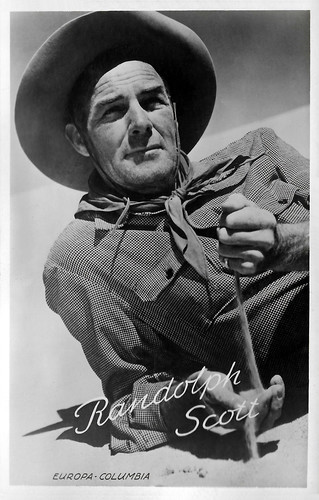
Dutch postcard. Photo: Europa - Columbia.
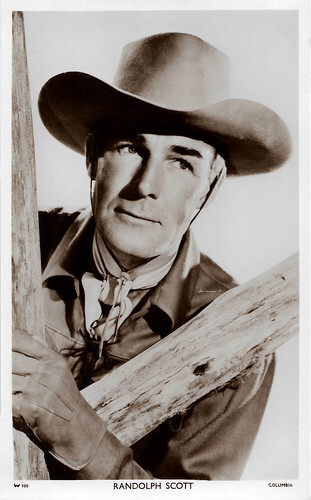
British postcard in the Picturegoer Series, London, no. W 980. Photo: Columbia.
Gaining much-needed acting experience
George Randolph Scott was born in 1898 as the second of six children of George and Lucy Crane Scott during a visit to Virginia. He was raised in Charlotte, North Carolina in a wealthy family. Because of his family's financial status, 'Randy' was able to attend private schools such as Woodberry Forest School. From an early age, Scott developed and displayed his athleticism, excelling in football, baseball, horse racing, and swimming.
After service with the U.S. Army in France in World War I, he attended the Georgia Institute of Technology but, after being injured playing football, he transferred to the University of North Carolina, from which he graduated with a degree in textile engineering and manufacturing.
Around 1927, he discovered acting and went to California, where he met Howard Hughes, who arranged a small part in a George O'Brien film called Sharp Shooters (John G. Blystone, 1928). Hughes also obtained an audition for him for Cecil B. DeMille 's Dynamite (1929), a role that went instead to Joel McCrea. He was hired to coach Gary Cooper in a Virginia dialect for The Virginian (Victor Fleming, 1929) and played a bit part in the film.
On the advice of Cecil B. DeMille , Scott gained much-needed acting experience by performing in stage plays with the Pasadena Playhouse. In 1931 Scott played his first leading role opposite Sally Blane in Women Men Marry (Charles Hutchison, 1931), a film, now apparently lost, made by a Poverty Row studio called Headline Pictures. In 1932 Scott appeared in a play at the Vine Street Theatre in Hollywood, 'Under a Virginia Moon'. Paramount scouts saw him and offered him a contract. Paramount cast him as the lead in Heritage of the Desert (Henry Hathaway, 1932), his first significant starring role and also the one that established him as a Western hero. Henry Hathaway made his directorial debut with Heritage of the Desert. The film was popular and Scott would go on to make ten 'B' Westerns loosely based on the novels of Zane Grey.
Scott met Cary Grant , another Paramount contract player, on the set of Hot Saturday (William A. Seiter, 1932) and the pair soon moved in together. Till 1944, they lived in a beach house known jocularly as Bachelor Hall. The close friendship between Scott and Grant and the steady stream of women into and out of Bachelor Hall fed rumour mills for years. Many believed that Grant and Scott were lovers, and the women were arranged by the film studios for public effect. This cohabitation ended in 1942 when Cary Grant married the Woolworth heiress Barbara Hutton, then the richest woman in the world. Scott remained close friends with Grant until the day he died. When he heard of his old friend's death, he reportedly put his head in his hands and wept. He himself would die a little over 2 months afterwards.
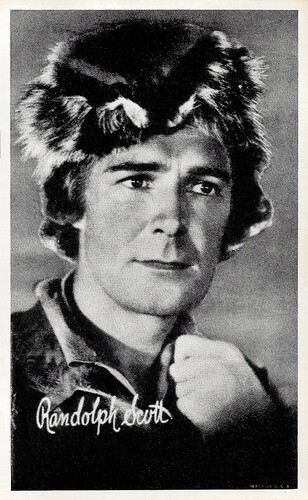
American postcard. Randolph Scott in The Last of the Mohicans (George B. Seitz, 1936).
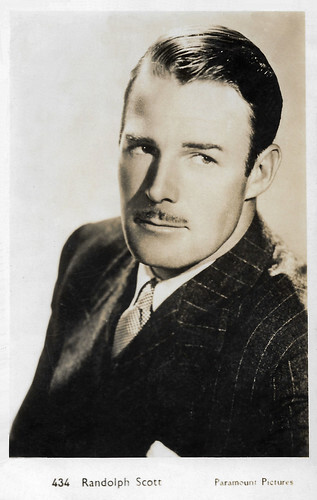
British postcard by Publicity Photographs LTD, London, no. 434. Photo: Paramount.
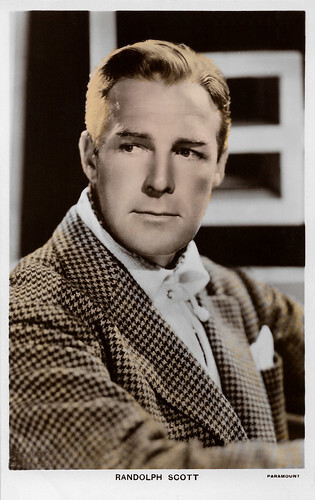
British postcard in the Colourgraph Series, London, no. C 256. Photo: Paramount.
Altering into a stoic, craggy, and uncompromising figure
Paramount loaned Randolph Scott to RKO Radio Pictures to support Fred Astaire , Ginger Rogers and Irene Dunne in Roberta (William A. Seiter, 1935), a hugely popular adaptation of the Broadway musical. He was loaned to independent producer Edward Small, to play Hawkeye in the adventure classic, The Last of the Mohicans (George B. Seitz, 1936), adapted from the 1826 novel by James Fenimore Cooper. A big hit, the film gave Scott his first unqualified 'A' picture success as a lead. He was a love interest for Mae West in Go West, Young Man (Henry Hathaway, 1936) and was reunited with Irene Dunne in a musical, High, Wide and Handsome (Rouben Mamoulian, 1937).
Randolph Scott married and divorced wealthy heiress Marion DuPont in the late 1930s. In the 1940s he appeared in several war films, notably To the Shores of Tripoli (H. Bruce Humberstone, 1942), Bombardier (Richard Wallace, 1943), the Canadian warship drama Corvette K-225 (Richard Rosson, 1943), Gung Ho! (Ray Enright, 1943) and China Sky (Ray Enright, 1945). Scott was a pleasant figure in comedies, dramas, and the occasional adventure, but it was not until he began focusing on Westerns in the late 1940s that he reached his greatest stardom. In 1946, after playing roles that had him wandering in and out of the saddle for many years, Scott appeared in Abilene Town (Edwin L. Marin, 1946), which cast him in what would become one of his classic images, the fearless lawman cleaning up a lawless town. The film cemented Scott's position as a cowboy hero; from this point on, all but two of his starring films would be Westerns.
He became one of the top box office stars of the 1950s and, in the Westerns of Budd Boetticher especially, a critically important figure in the Western as an art form. The seven films he shot under Boetticher's direction are classic Westerns: Seven Men from Now (1956), The Tall T (1956), Decision at Sundown (1957), Buchanan Rides Alone (1958), Westbound (1958), Ride Lonesome (1959) and Comanche Station (1960). His screen persona altered into that of a stoic, craggy, uncompromising figure, a tough, hard-bitten man seemingly unconnected to the light comedy lead he had been in the 1930s. In these films, the natural entourage is the rugged landscapes of the Californian Sierras.
Following a critically acclaimed, less-heroic-than-usual role in one of the classics of the genre, Ride the High Country (Sam Peckinpah, 1962) opposite Joel McCrea, Scott retired from films at the age of 64. A multimillionaire as a result of smart investments, Scott spent his remaining years playing golf and avoiding film industry affairs, stating that he didn't like publicity.
In 1987, he died in Beverly Hills of a heart and lung disease at the age of 89. He was survived by his second wife, Patricia Stillman, and their two adopted children, Christopher and Sandra. He was interred at Elmwood Cemetery, Charlotte, North Carolina, USA, just four blocks from his boyhood home at 312 W. 10th Street.
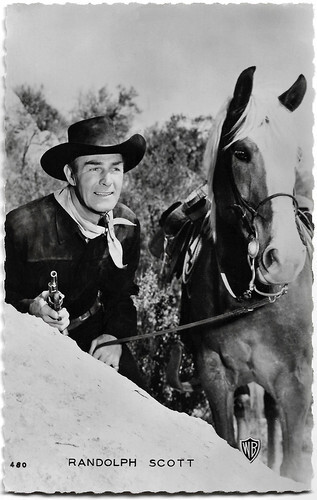
French postcard by Editions P.I., presented by Les Carbones Korès, Paris, no. 480. Photo: Warner Bros, 1953.Randolph Scott in Colt .45 (Edwin L. Marin, 1950).
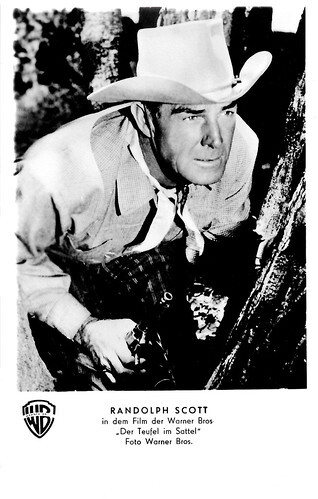
German postcard by Netter's Star Verlag, Berlin, no. 1475. Photo: Warner Bros. Randolph Scott in Tall Man Riding (Lesley Selander, 1955).
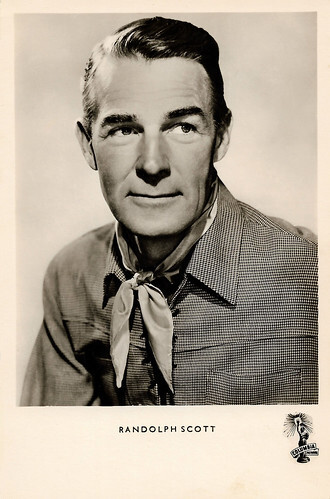
West-German postcard by Kunst und Bild, Berlin, no. A 123. Photo: Columbia.
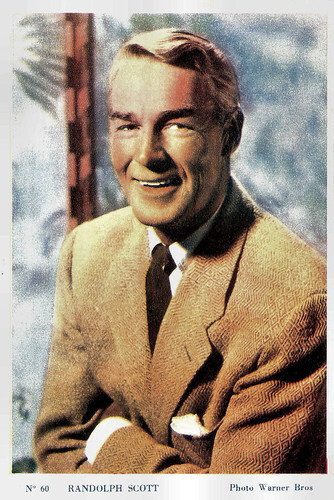
Belgian collectors card by Merbotex, Bruxelles, for cinéma Kursaal in Bertrix, no. 60. Photo: Warner Bros.
Sources: (IMDb), Wikipedia and .

British postcard in the Picturegoer Series, London, no. 799. Photo: Paramount.

Dutch postcard. Photo: Europa - Columbia.

British postcard in the Picturegoer Series, London, no. W 980. Photo: Columbia.
Gaining much-needed acting experience
George Randolph Scott was born in 1898 as the second of six children of George and Lucy Crane Scott during a visit to Virginia. He was raised in Charlotte, North Carolina in a wealthy family. Because of his family's financial status, 'Randy' was able to attend private schools such as Woodberry Forest School. From an early age, Scott developed and displayed his athleticism, excelling in football, baseball, horse racing, and swimming.
After service with the U.S. Army in France in World War I, he attended the Georgia Institute of Technology but, after being injured playing football, he transferred to the University of North Carolina, from which he graduated with a degree in textile engineering and manufacturing.
Around 1927, he discovered acting and went to California, where he met Howard Hughes, who arranged a small part in a George O'Brien film called Sharp Shooters (John G. Blystone, 1928). Hughes also obtained an audition for him for Cecil B. DeMille 's Dynamite (1929), a role that went instead to Joel McCrea. He was hired to coach Gary Cooper in a Virginia dialect for The Virginian (Victor Fleming, 1929) and played a bit part in the film.
On the advice of Cecil B. DeMille , Scott gained much-needed acting experience by performing in stage plays with the Pasadena Playhouse. In 1931 Scott played his first leading role opposite Sally Blane in Women Men Marry (Charles Hutchison, 1931), a film, now apparently lost, made by a Poverty Row studio called Headline Pictures. In 1932 Scott appeared in a play at the Vine Street Theatre in Hollywood, 'Under a Virginia Moon'. Paramount scouts saw him and offered him a contract. Paramount cast him as the lead in Heritage of the Desert (Henry Hathaway, 1932), his first significant starring role and also the one that established him as a Western hero. Henry Hathaway made his directorial debut with Heritage of the Desert. The film was popular and Scott would go on to make ten 'B' Westerns loosely based on the novels of Zane Grey.
Scott met Cary Grant , another Paramount contract player, on the set of Hot Saturday (William A. Seiter, 1932) and the pair soon moved in together. Till 1944, they lived in a beach house known jocularly as Bachelor Hall. The close friendship between Scott and Grant and the steady stream of women into and out of Bachelor Hall fed rumour mills for years. Many believed that Grant and Scott were lovers, and the women were arranged by the film studios for public effect. This cohabitation ended in 1942 when Cary Grant married the Woolworth heiress Barbara Hutton, then the richest woman in the world. Scott remained close friends with Grant until the day he died. When he heard of his old friend's death, he reportedly put his head in his hands and wept. He himself would die a little over 2 months afterwards.

American postcard. Randolph Scott in The Last of the Mohicans (George B. Seitz, 1936).

British postcard by Publicity Photographs LTD, London, no. 434. Photo: Paramount.

British postcard in the Colourgraph Series, London, no. C 256. Photo: Paramount.
Altering into a stoic, craggy, and uncompromising figure
Paramount loaned Randolph Scott to RKO Radio Pictures to support Fred Astaire , Ginger Rogers and Irene Dunne in Roberta (William A. Seiter, 1935), a hugely popular adaptation of the Broadway musical. He was loaned to independent producer Edward Small, to play Hawkeye in the adventure classic, The Last of the Mohicans (George B. Seitz, 1936), adapted from the 1826 novel by James Fenimore Cooper. A big hit, the film gave Scott his first unqualified 'A' picture success as a lead. He was a love interest for Mae West in Go West, Young Man (Henry Hathaway, 1936) and was reunited with Irene Dunne in a musical, High, Wide and Handsome (Rouben Mamoulian, 1937).
Randolph Scott married and divorced wealthy heiress Marion DuPont in the late 1930s. In the 1940s he appeared in several war films, notably To the Shores of Tripoli (H. Bruce Humberstone, 1942), Bombardier (Richard Wallace, 1943), the Canadian warship drama Corvette K-225 (Richard Rosson, 1943), Gung Ho! (Ray Enright, 1943) and China Sky (Ray Enright, 1945). Scott was a pleasant figure in comedies, dramas, and the occasional adventure, but it was not until he began focusing on Westerns in the late 1940s that he reached his greatest stardom. In 1946, after playing roles that had him wandering in and out of the saddle for many years, Scott appeared in Abilene Town (Edwin L. Marin, 1946), which cast him in what would become one of his classic images, the fearless lawman cleaning up a lawless town. The film cemented Scott's position as a cowboy hero; from this point on, all but two of his starring films would be Westerns.
He became one of the top box office stars of the 1950s and, in the Westerns of Budd Boetticher especially, a critically important figure in the Western as an art form. The seven films he shot under Boetticher's direction are classic Westerns: Seven Men from Now (1956), The Tall T (1956), Decision at Sundown (1957), Buchanan Rides Alone (1958), Westbound (1958), Ride Lonesome (1959) and Comanche Station (1960). His screen persona altered into that of a stoic, craggy, uncompromising figure, a tough, hard-bitten man seemingly unconnected to the light comedy lead he had been in the 1930s. In these films, the natural entourage is the rugged landscapes of the Californian Sierras.
Following a critically acclaimed, less-heroic-than-usual role in one of the classics of the genre, Ride the High Country (Sam Peckinpah, 1962) opposite Joel McCrea, Scott retired from films at the age of 64. A multimillionaire as a result of smart investments, Scott spent his remaining years playing golf and avoiding film industry affairs, stating that he didn't like publicity.
In 1987, he died in Beverly Hills of a heart and lung disease at the age of 89. He was survived by his second wife, Patricia Stillman, and their two adopted children, Christopher and Sandra. He was interred at Elmwood Cemetery, Charlotte, North Carolina, USA, just four blocks from his boyhood home at 312 W. 10th Street.

French postcard by Editions P.I., presented by Les Carbones Korès, Paris, no. 480. Photo: Warner Bros, 1953.Randolph Scott in Colt .45 (Edwin L. Marin, 1950).

German postcard by Netter's Star Verlag, Berlin, no. 1475. Photo: Warner Bros. Randolph Scott in Tall Man Riding (Lesley Selander, 1955).

West-German postcard by Kunst und Bild, Berlin, no. A 123. Photo: Columbia.

Belgian collectors card by Merbotex, Bruxelles, for cinéma Kursaal in Bertrix, no. 60. Photo: Warner Bros.
Sources: (IMDb), Wikipedia and .
Published on December 01, 2022 22:00
November 30, 2022
Alice Field
French actress Alice Field(1903-1969) started out in the silent film era. Her career got on steam in the 1930s when she starred in several French language versions of German film classics.
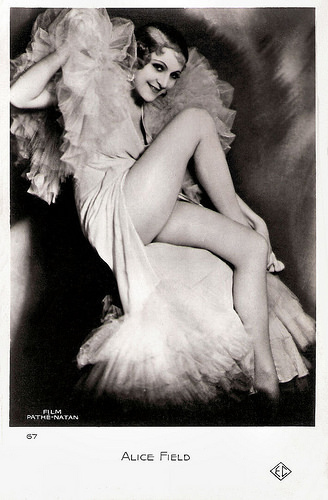
French postcard by EC, no. 67. Photo: Film Pathé-Nathan.
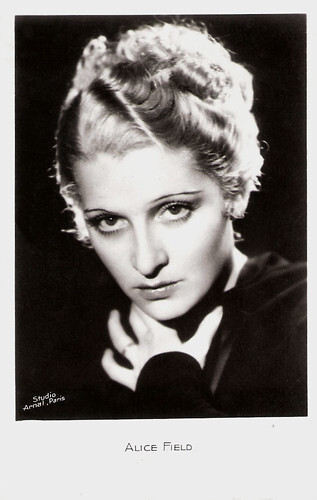
French postcard. Photo: Studio Arnal, Paris.
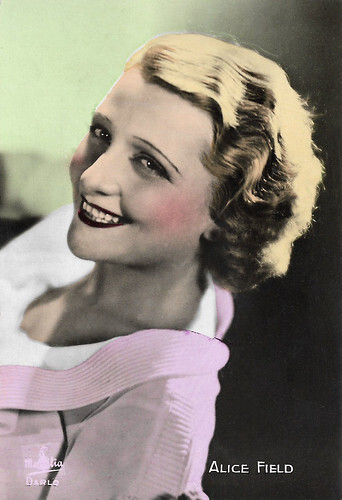
French collectors card by Massilia. Photo: Darlo.
Atlantis
Alice Field was born Alice Fille in Alger, France, now Algeria,in 1903.
She made her film debut opposite Saint-Granier in the silent production Villa Destin (Marcel L’Herbier, 1921), based on a play by Oscar Wilde. That same year she played the second wife of a well-to-do Algerian ( Marcel Vibert ) in Visages voilés... âmes closes/The Sheik's Wife (Henry Roussel, 1921).
She then focused on stage work but returned to the cinema when sound film was introduced. She played the wife of Constant Rémy in Atlantis (Ewald André Dupont, Jean Kemm, 1930), produced by British International Pictures at Elstree Studios and based on the 1929 West End play 'The Berg' by Ernest Raymond a heavily fictionalised version of the RMS Titanic story. It was filmed simultaneously with the English-language version, Atlantic (1929), the German-language version, Atlantik (1929) and the silent version, Atlantic (1929). Such Multiple-language versions were common in the early years of sound before dubbing became a more established practice.
Her film career got on steam. In the following years, Field appeared in several films. The mystery film La maison de La Flèche/The house of La Flèche (Henri Fescourt, 1930) with Annabella , was made at Twickenham Studios in London as part of a co-production that saw an English-language version directed by Leslie S. Hiscott. Next, she appeared in Le refuge/The Refuge (Léon Mathot, 1931) and Vous serez ma femme/You Will Be My Wife (Carl Boese, Serge de Poligny, 1932) with Roger Tréville . The latter was the alternative language version of the Ufa comedy Der Frechdachs/The Cheeky Devil (Carl Boese, Heinz Hille, 1932) with Willy Fritsch and Camilla Horn .
Throughout the 1930s, Field played leading and supporting roles in a dozen French films. Most of them were run-of-the-mill, but quite watchable are Cette vieille canaille/The Old Rogue (Anatole Litvak, 1933) featuring Harry Baur , and the crime drama Police mondaine/Worldly Police (Michel Bernheim, Christian Chamborant, 1937), in which she starred opposite Charles Vanel and Pierre Larquey.
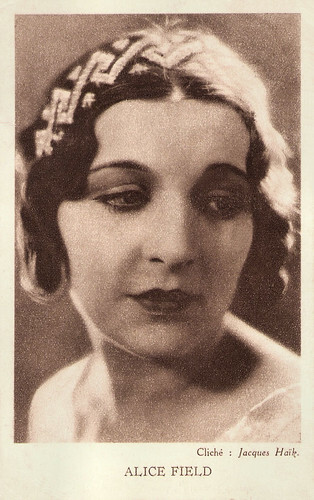
Belgian postcard by S.A. Cacao et Chocolat Kivou, Vilvorde. Photo: Jacques Haïk.
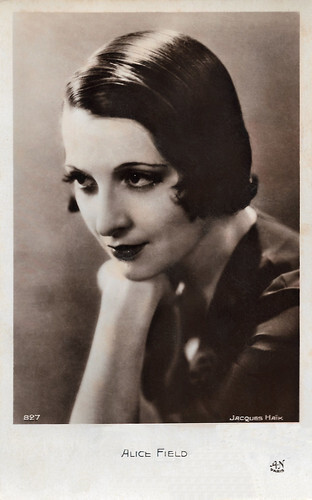
French postcard by A.N., Paris, no. 827. Photo: Jacques Haïk.
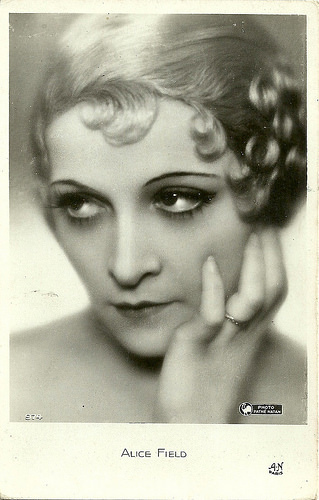
French postcard by A.N., Paris, no. 974. Photo: Pathé Natan.
Playtime
Alice Field starred in the spectacle Le tigre du Bengale/The Tiger of Eschnapur (Richard Eichberg, 1938) and the sequel Le tombeau hindou/The Indian Tomb (Richard Eichberg, 1938). These were the French language versions of the German two-parter Das indische Grabmal (Richard Eichberg, 1938) and Der Tiger von Eschnapur (Richard Eichberg, 1938).
These films were remakes of Joe May's 1919 silent films of the same name. Both versions were based on a novel by Thea Von Harbou, at one time the wife of director Fritz Lang . In turn, both Der Tiger von Eschnapur and Das Indische Grabmal were remade in 1959 by Fritz Lang .
During the 1940s, Field continued to star in French films. Among her films were the drama Campement 13/Camp 13 (Jacques Constant, 1940), and the comedy La loi du printemps/The law of spring (Jacques Daniel-Norman, 1942) with Pierre Renoir .
After the war, she kept busy although her parts became smaller. Among her films of the 1950s and 1960s are the comedy drama Au p'tit zouave/The little Zouave (Gilles Grangier, 1950) starring François Périer , the Euro-spy film Pleins feux sur Stanislas/Killer Spy (Jean-Charles Dudrumet, 1965) starring Jean Marais , and the romance Un garçon, une fille. Le dix-septième ciel/A boy, a girl. The seventeenth sky (Serge Korber, 1966) with Jean Louis Trintignant and Marie Dubois .
She continued to play roles on stage and also on television, like in the series Au théâtre ce soir/On stage tonight (1966-1970). One of her final film appearances was a small part as a customer at Royal Garden in the classic comedy Playtime (Jacques Tati, 1967) with Jacques Tati as Monsieur Hulot. Playtime is considered Tati's masterpiece and his most daring work.
Alice Field died in 1969 in Paris. She was 66.
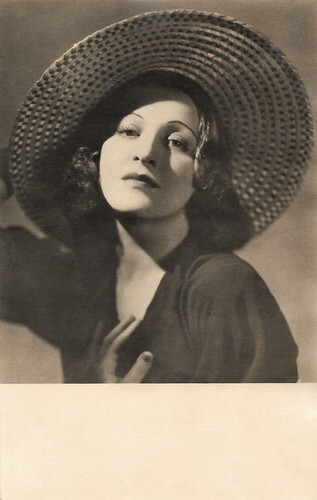
French postcard.
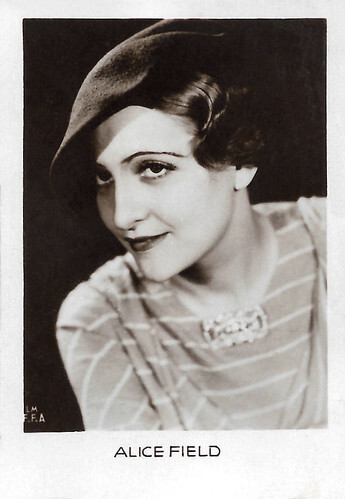
French collectors card by Ets Ungemach, Strasbourg, for Bonbons Loriot, Serie G: Cinema, sujet no. 2 (50 sujets).
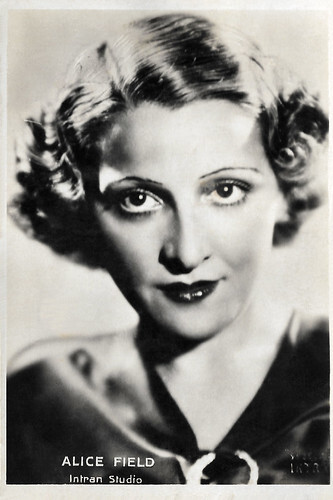
French collectors card. Photo: Intran Studio.
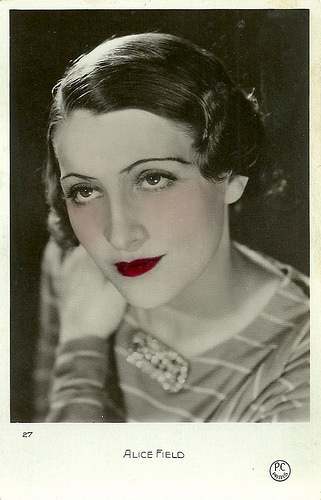
French postcard by P.C., Paris, no. 27.
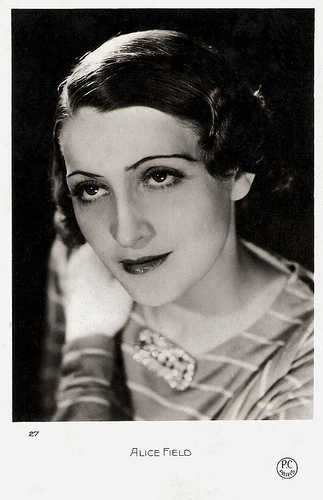
French postcard by P.C., Paris, no. 27.
Sources: AllMovie, Wikipedia (French and English) and .

French postcard by EC, no. 67. Photo: Film Pathé-Nathan.

French postcard. Photo: Studio Arnal, Paris.

French collectors card by Massilia. Photo: Darlo.
Atlantis
Alice Field was born Alice Fille in Alger, France, now Algeria,in 1903.
She made her film debut opposite Saint-Granier in the silent production Villa Destin (Marcel L’Herbier, 1921), based on a play by Oscar Wilde. That same year she played the second wife of a well-to-do Algerian ( Marcel Vibert ) in Visages voilés... âmes closes/The Sheik's Wife (Henry Roussel, 1921).
She then focused on stage work but returned to the cinema when sound film was introduced. She played the wife of Constant Rémy in Atlantis (Ewald André Dupont, Jean Kemm, 1930), produced by British International Pictures at Elstree Studios and based on the 1929 West End play 'The Berg' by Ernest Raymond a heavily fictionalised version of the RMS Titanic story. It was filmed simultaneously with the English-language version, Atlantic (1929), the German-language version, Atlantik (1929) and the silent version, Atlantic (1929). Such Multiple-language versions were common in the early years of sound before dubbing became a more established practice.
Her film career got on steam. In the following years, Field appeared in several films. The mystery film La maison de La Flèche/The house of La Flèche (Henri Fescourt, 1930) with Annabella , was made at Twickenham Studios in London as part of a co-production that saw an English-language version directed by Leslie S. Hiscott. Next, she appeared in Le refuge/The Refuge (Léon Mathot, 1931) and Vous serez ma femme/You Will Be My Wife (Carl Boese, Serge de Poligny, 1932) with Roger Tréville . The latter was the alternative language version of the Ufa comedy Der Frechdachs/The Cheeky Devil (Carl Boese, Heinz Hille, 1932) with Willy Fritsch and Camilla Horn .
Throughout the 1930s, Field played leading and supporting roles in a dozen French films. Most of them were run-of-the-mill, but quite watchable are Cette vieille canaille/The Old Rogue (Anatole Litvak, 1933) featuring Harry Baur , and the crime drama Police mondaine/Worldly Police (Michel Bernheim, Christian Chamborant, 1937), in which she starred opposite Charles Vanel and Pierre Larquey.

Belgian postcard by S.A. Cacao et Chocolat Kivou, Vilvorde. Photo: Jacques Haïk.

French postcard by A.N., Paris, no. 827. Photo: Jacques Haïk.

French postcard by A.N., Paris, no. 974. Photo: Pathé Natan.
Playtime
Alice Field starred in the spectacle Le tigre du Bengale/The Tiger of Eschnapur (Richard Eichberg, 1938) and the sequel Le tombeau hindou/The Indian Tomb (Richard Eichberg, 1938). These were the French language versions of the German two-parter Das indische Grabmal (Richard Eichberg, 1938) and Der Tiger von Eschnapur (Richard Eichberg, 1938).
These films were remakes of Joe May's 1919 silent films of the same name. Both versions were based on a novel by Thea Von Harbou, at one time the wife of director Fritz Lang . In turn, both Der Tiger von Eschnapur and Das Indische Grabmal were remade in 1959 by Fritz Lang .
During the 1940s, Field continued to star in French films. Among her films were the drama Campement 13/Camp 13 (Jacques Constant, 1940), and the comedy La loi du printemps/The law of spring (Jacques Daniel-Norman, 1942) with Pierre Renoir .
After the war, she kept busy although her parts became smaller. Among her films of the 1950s and 1960s are the comedy drama Au p'tit zouave/The little Zouave (Gilles Grangier, 1950) starring François Périer , the Euro-spy film Pleins feux sur Stanislas/Killer Spy (Jean-Charles Dudrumet, 1965) starring Jean Marais , and the romance Un garçon, une fille. Le dix-septième ciel/A boy, a girl. The seventeenth sky (Serge Korber, 1966) with Jean Louis Trintignant and Marie Dubois .
She continued to play roles on stage and also on television, like in the series Au théâtre ce soir/On stage tonight (1966-1970). One of her final film appearances was a small part as a customer at Royal Garden in the classic comedy Playtime (Jacques Tati, 1967) with Jacques Tati as Monsieur Hulot. Playtime is considered Tati's masterpiece and his most daring work.
Alice Field died in 1969 in Paris. She was 66.

French postcard.

French collectors card by Ets Ungemach, Strasbourg, for Bonbons Loriot, Serie G: Cinema, sujet no. 2 (50 sujets).

French collectors card. Photo: Intran Studio.

French postcard by P.C., Paris, no. 27.

French postcard by P.C., Paris, no. 27.
Sources: AllMovie, Wikipedia (French and English) and .
Published on November 30, 2022 22:00
November 29, 2022
La Collectionneuse: Jean Arthur
Rarely an actress had taken so much time to achieve recognition than Jean Arthur. She made her film debut in 1923 and had to wait for about thirteen years to become a full-fledged star and one of the most famous comedy queens of her time. She was part of a 1930s new breed of heroines: independent, strong-willed, breezy, quick-witted, no-nonsense and sassy. By becoming one of the quintessential epitomes of the working girl in her films, she paved the way for more accurate depictions of women in Hollywood. Her distinctive voice, at once squeaky, cracked, nasal and husky, which at times could change unpredictably in tones, became one of her principal assets and formed a winning combination with her perfect comic timing and endearing on-screen persona. Jean Arthur’s unique contributions to social and screwball comedies have been deservedly acknowledged by film historians.
When she was at the top, Jean Arthur stunned columnists by recoiling from interviews, by showing an aversion to publicity and by avoiding parties and nightclubs. She was even compared to Greta Garbo for her alleged elusiveness. In 1942, she received a Sour Apple Award for being the least cooperative actress in Hollywood. About the capital of cinema, she was adamant: "I hated the place - not the work, but the lack of privacy, those terrible, prying fan magazine writers and all the surrounding exploitation". In private, she was known to be shy and insecure and to be plagued with stage and screen fright. She also sought perfection in her work, always fearing not attaining the high standards of acting she had set for herself. In real life, she always took great care to retain her privacy, her individuality and her non-conformism and she could appear as anti-social to many people. She once said: "I’m not an adult, that’s my explanation of myself. Except when I’m working on a set, I have all the inhibitions and shyness of the bashful, backward child". She also declared: "As a character in a play, I feel as if I can be what people expect. As Jean Arthur, I never feel as if I know what people expect". For sure, she was a complex and conflicted person ... but what a good actress she became!
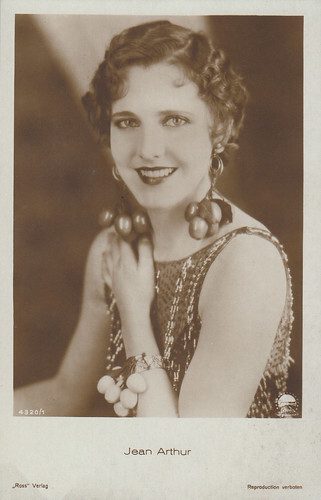
German postcard by Ross Verlag, no. 4320/1, 1929-1930. Photo: Paramount.
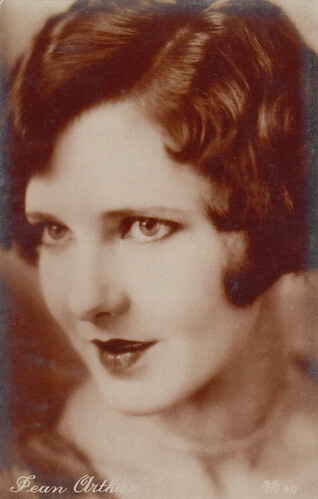
Spanish postcard by M.C., Barcelona, no. 90.
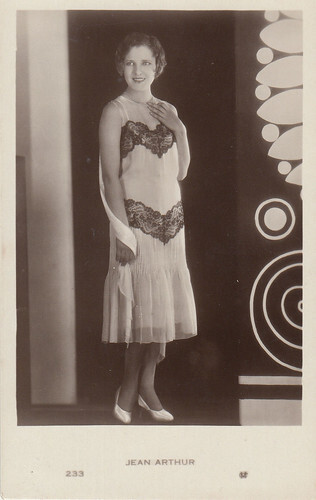
Spanish postcard by M.C., Barcelona, no. 233.
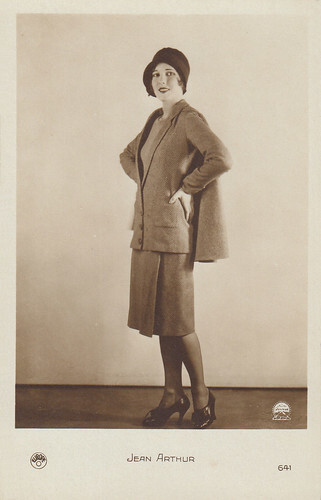
French postcard by Europe, no. 641. Photo: Paramount.
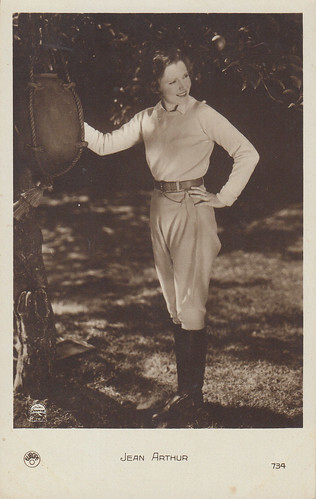
French postcard by Europe, no. 734. Photo: Paramount.
A long struggle to achieve recognition
Jean Arthur was born Gladys Georgianna Greene on the 17th of October 1900 in Plattsburgh, New York, U.S.A. Her father was a photographer. During the First World War, she took a job as a stenographer but later turned to photographic modelling. This led her to be noticed by Fox and she made her film debut in a supporting role in John Ford’s Cameo Kirby (1923). She took her stage name from Saint Joan of Arc / Jeanne d’Arc, who was one of her favourite heroines, and King Arthur. She was then given a leading part in The Temple of Venus (1923) but was found too inexperienced and was quickly replaced by Mary Philbin .
For a few years, she was mostly seen in comedy shorts and low-budget Westerns. In 1928, she got her break in the Paramount film Warming Up, which earned her good reviews. As a result, she was given a three-year contract. Unfortunately, during her stay at Paramount, she appeared mostly in inconsequential ingenue roles. Nevertheless, from time to time, she had the opportunity to impress the critics, for example in The Mysterious Dr Fu Manchu (1929) or as Clara Bow ’s conniving little sister in The Saturday Night Kid (1929).
At the time, she had an affair with David O’Selznick, who was then a rising young Paramount executive. He tried his best to promote her but it seemed that the company had somewhat lost interest in her and was not really convinced anymore that she would ever make it to the top. In 1931, her contract was not renewed and Jean Arthur decided to go on stage. Interestingly enough, her plays brought her on the whole more recognition than she ever had during her movie days.
After her personal success on Broadway in 'The Curtain Rises' (1933), an offer came from Columbia to play a reporter opposite Jack Holt in Whirlpool (1934). During filming, Columbia executives felt she had the makings of a star and decided to sign her to a five-year contract in February 1934. They put her in The Defense Rests (1934) and The Most Precious Thing in Life (1934) with mixed results but she soon shone as a hard-boiled working girl in John Ford’s The Whole Town’s Talking (1935).
Definitely gone was the nondescript ingenue of a few years before: a new image of Jean Arthur had emerged. Her career moved forward with such films as Party Wire (1935) or If You Could Only Cook (1935). After Carole Lombard had backed out, she was chosen by Frank Capra to play Babe Bennett, a cynical newspaperwoman who finally falls in love with the man she had been cheated on, in Mr Deeds Goes to Town (1936), opposite Gary Cooper . It finally made her a full-fledged star.
She then notably was William Powell ’s co-star in The Ex-Mrs Bradford (1936) and, as Calamity Jane, reunited with Gary Cooper in Cecil B. De Mille ’s The Plainsman (1937). She also showed her skills in films such as History Is Made at Night (1937) and Easy Living (1937).
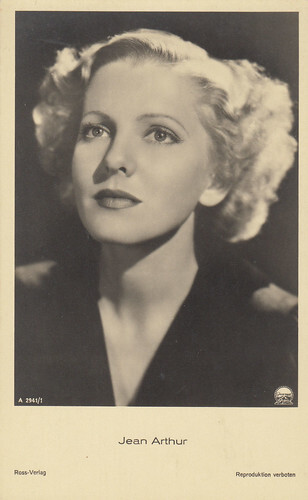
German postcard by Ross Verlag, no. A 2941/1, 1939-1940. Photo: Paramount.
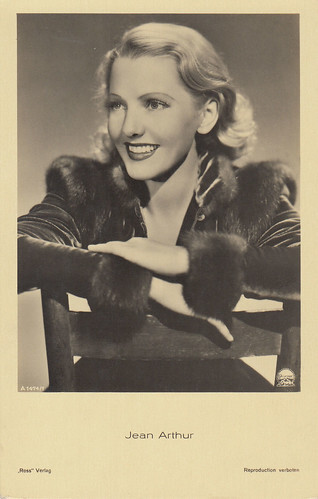
German postcard by Ross Verlag, no. A 1474/1, 1937-1938. Photo: Paramount.
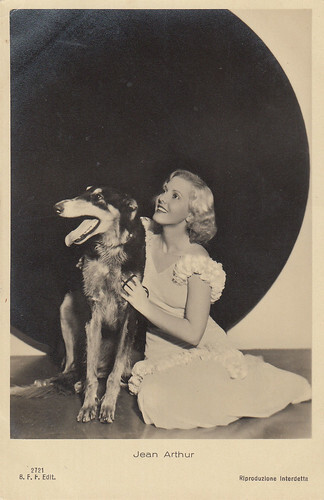
Italian postcard by Ballerini & Fratini, Firenze, no. 2721.
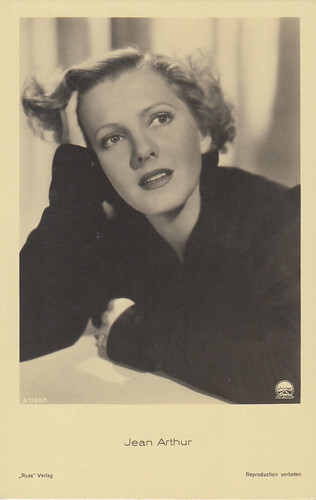
German postcard by Ross Verlag, no. A 1198/1, 1937-1938. Photo: Paramount.
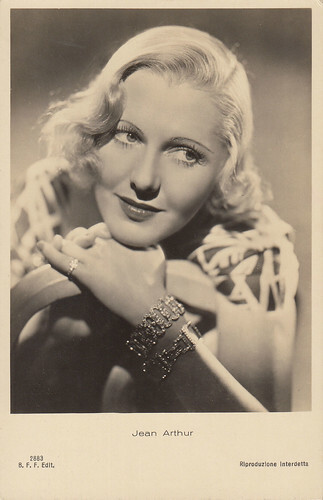
Italian postcard by Ballerini & Fratini, Firenze, no. 2883.
At the top of her profession
In March 1938, she signed a new contract with Columbia, succeeding in adding a clause which relieved her from any duty to participate in interviews or public appearances. In December 1938, she screen-tested for the role of Scarlett O’Hara in Gone With the Wind but most people agreed that she was not suited for the part.
She was again successfully directed by Frank Capra in You Can’t Take It with You (1938) and Mr Smith Goes to Washington (1939). Furthermore, she tremendously liked being directed by George Stevens in The Talk of the Town (1942) and The More the Merrier (1943), which got her her only Oscar nomination. She also joined the list of 'Hawksian Women' in Howard Hawks’ Only Angels Have Wings (1939).
Her other films include The Devil and Miss Jones (1941) and The Lady Takes a Chance (1943), which were produced by her then-husband Frank Ross for RKO. After The Impatient Years (1944), her contract with Columbia was over, much to her relief. Their relationship had been a stormy one and she had been suspended on several occasions.
In 1947, she signed a three-picture deal with Paramount. She only made two: Billy Wilder’s A Foreign Affair (1948) and George Stevens’ Western Shane (1953). She gave good performances in both but the ever-insecure actress thought Wilder had favoured Marlene Dietrich in the first and was not too fond of the latter as she "couldn’t use any comedy bits in it at all and just had to act old and worn out".
After she repeatedly turned down the scripts offered to her, Paramount bought out the rest of her contract and she never made another Hollywood movie. In the mid-1960s, she decided to give television a try and starred in 1965 in an episode of the popular series Gunsmoke. She was delighted by the results and was then featured in 1966 in a weekly 30-minute situation comedy program called The Jean Arthur Show, in which she played a lawyer. Unfortunately, it was a flop and was cancelled after twelve episodes. In August 1973, to the amazement of everyone, in view of her bashfulness, she agreed to appear, alongside Frank Capra, in the only talk show of her career, The Merv Griffin Show.
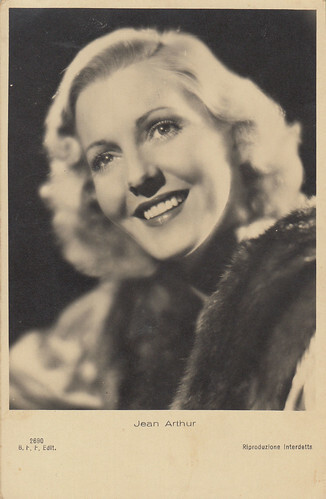
Italian postcard by Ballerini & Fratini, Firenze, no. 2690.
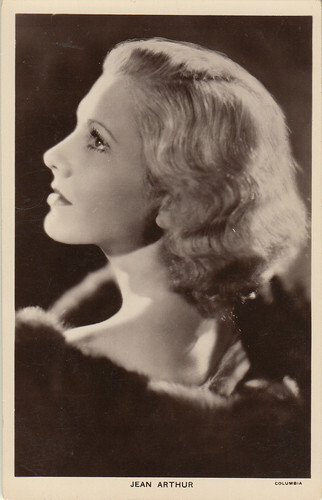
British postcard by Picturegoer, no. 438b. Photo: Columbia.
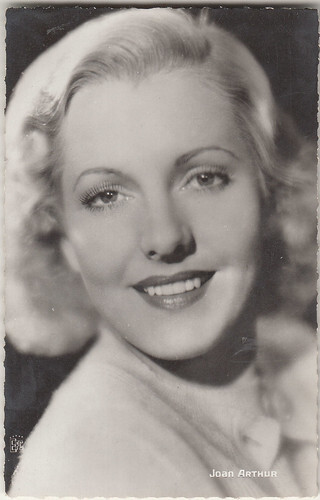
French postcard by Editions et publications cinématographiques (EPC), no. 164.

British postcard. Photo: Columbia. Jean Arthur in The Whole Town’s Talking (John Ford, 1935). Passport to Fame was the British premiere title.
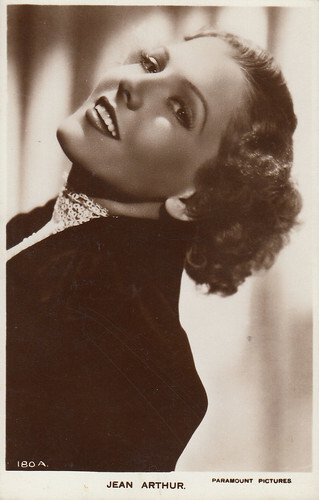
British postcard, no. 180 A. Photo: Paramount Pictures.
Jean Arthur’s later stage career: a big hit and several downs
In 1945, Jean Arthur was signed for the role of Billie Dawn in 'Born Yesterday,' a play Garson Kanin had written with her in mind. She opened with it in New Haven on the 20th of December 1945 and quit in Boston several days later on the 1st of January, pleading health reasons. She was quickly replaced by newcomer Judy Holliday, who triumphed with it on Broadway from February 1946 to December 1949 and got an Oscar in 1951 for the film version.
Ultimately, Jean Arthur was a hit on Broadway by playing in James Barrie’s 'Peter Pan', a role she had longed to play for a long time, from April 1950 to January 1951. In 1954, she toured with G.B. Shaw’s 'Saint Joan', beginning on the 17th of September. But she didn’t get along with director Harold Clurman and, if several critics were enthusiastic, some others were not overly convinced by her portrayal of Joan. Her self-confidence began to dwindle and she gave her last performance on the 6th of November, declaring that she was too exhausted to go on.
She took a revenge of sorts when she gave a very successful concert reading of the same play at the University of Berkeley from the 6th to the 15th of February 1964. In 1967, she accepted to play a spinster involved with hippies in 'The Freaking Out of Stephanie Blake'. The first preview on the 30th of October was a disaster. There wasn’t to be any opening night as, at the very beginning of November, she quit, amidst rumours of a nervous breakdown.
At the beginning of 1973, she accepted an offer from John Springer to appear on stage at the Manhattan Town Hall in his Legendary Ladies of the Movies series. For one evening, she would have been slated to answer questions from the audience, after a showing of film clips. But she quickly began to get cold feet, finally cancelled her participation and was replaced by Joan Crawford .
On the 17th of October 1975, she opened in Cleveland opposite Melvyn Douglas in 'First Monday' in October and played it for the last time on the 29th, allegedly suffering from a viral affection. It was the fourth time that she had pulled out of a legitimate stage production. There had been much speculation about this pattern. It’s commonly assumed that her illness symptoms were real, not feigned, but many thought that those troubles were mostly of psychosomatic origin.
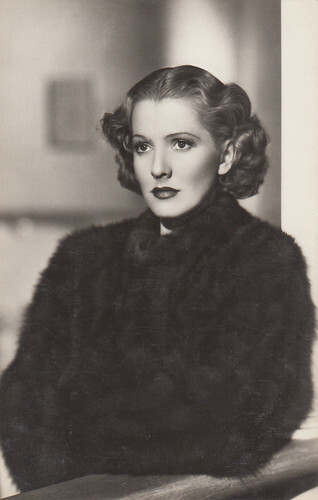
Spanish postcard by Infonal, no. 122.
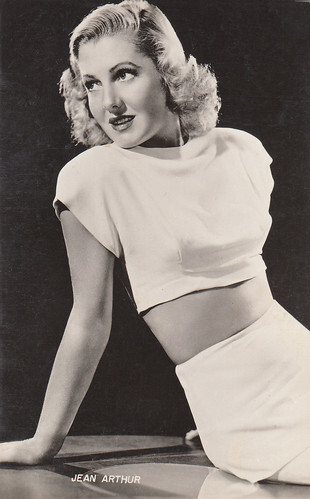
Vintage postcard.
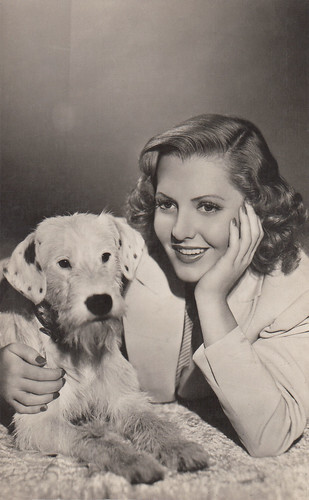
Spanish postcard by Archivo Bermejo.
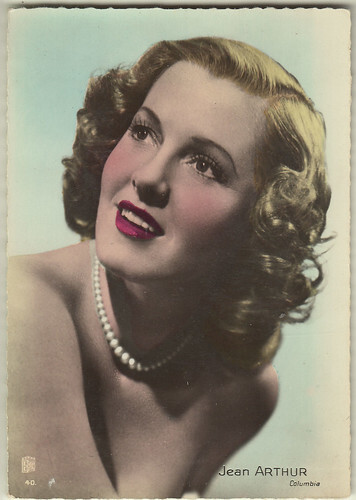
French postcard by EPC, no. 40. Photo: Columbia.
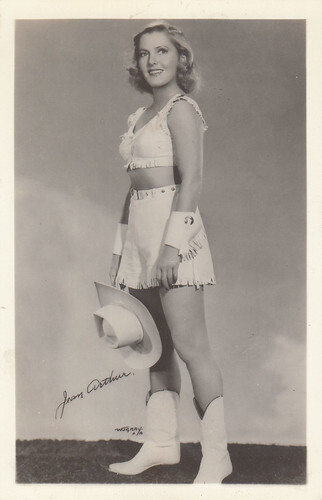
American postcard by W.J. Gray, L.A.
Jean Arthur as a teacher
After the 'The Freaking Out of Stephanie Blake' debacle, she taught drama at Vassar College from 1968 to 1972. Her methods didn’t win unanimity and, in the end, her relationship with the school director and several other teachers had become strained.
She had another ill-fated try at acting teaching at the North California School of the Arts in Winston-Salem and it was not a successful and happy experience for her. It only lasted one 1972-1973 semester.
In 1977, she sold her Driftwood Cottage, a place she had bought in Carmel in 1946, and moved to a new house called Bay Cottage in the same city. Still fiercely protecting her privacy, she embraced a certain measure of seclusion, spending much time gardening, tending her beloved cats (she had been an animal lover all her life) and reading books. True to herself, she continuously turned down interview requests.
In 1982, she was one of the very few stars not present when the American Film Institute honoured Frank Capra with a Life Achievement Award. In 1985, she declined to offer anecdotes in the documentary George Stevens: A Filmmaker’s Journey. She had a close circle of selected friends such as actor Roddy McDowall and Ellen Mastroianni, a neighbour she had met at the end of the 1950s, who took care of her until the end.
In 1989, she broke her hip and suffered a stroke, which left her an invalid. In June 1991, she had to move to a nursing home, where she passed away from heart failure on the 19th. According to her wishes, her body was cremated and her ashes were scattered at sea.
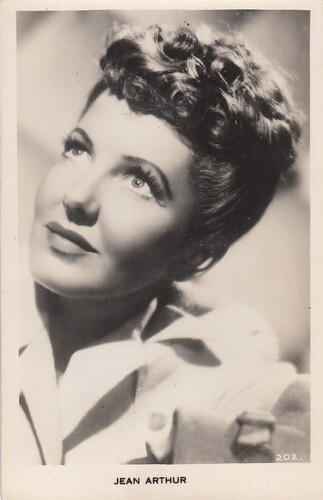
British postcard by Valentine’s, no.202.
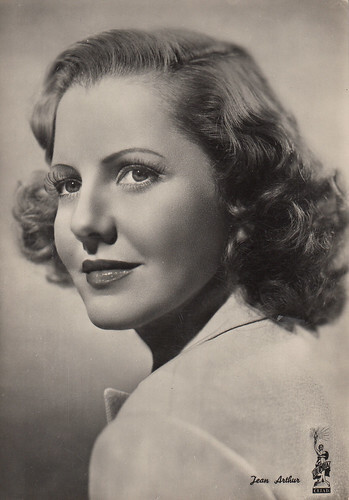
Italian postcard by Rotalfoto, Milano, no. 41. Photo: Columbia CEIAD.
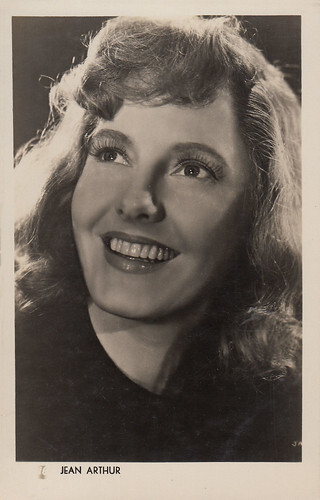
Spanish postcard by Kores Carboplan.
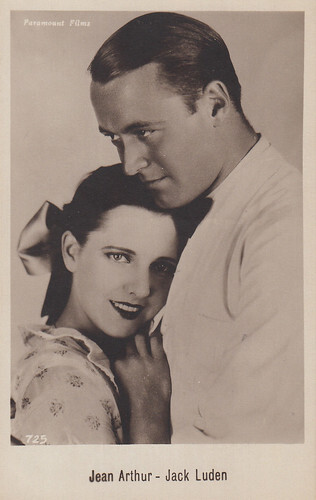
Italian postcard by G.B. Falci, Milano, no. 725. Jean Arthur and Jack Luden played together in Sins of the Fathers (Ludwig Berger, 1928).
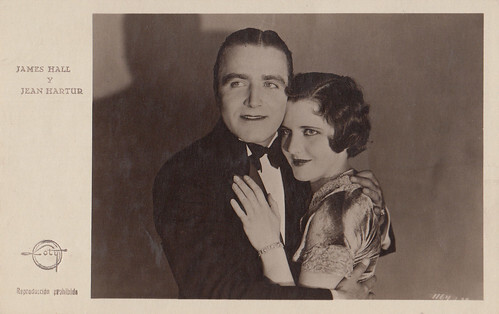
Spanish postcard by Loty, no. 1164. Jean Arthur and James Hall in The Canary Murder Case (Malcolm St. Clair, 1929).
Text and postcards: Marlene Pilaete.
When she was at the top, Jean Arthur stunned columnists by recoiling from interviews, by showing an aversion to publicity and by avoiding parties and nightclubs. She was even compared to Greta Garbo for her alleged elusiveness. In 1942, she received a Sour Apple Award for being the least cooperative actress in Hollywood. About the capital of cinema, she was adamant: "I hated the place - not the work, but the lack of privacy, those terrible, prying fan magazine writers and all the surrounding exploitation". In private, she was known to be shy and insecure and to be plagued with stage and screen fright. She also sought perfection in her work, always fearing not attaining the high standards of acting she had set for herself. In real life, she always took great care to retain her privacy, her individuality and her non-conformism and she could appear as anti-social to many people. She once said: "I’m not an adult, that’s my explanation of myself. Except when I’m working on a set, I have all the inhibitions and shyness of the bashful, backward child". She also declared: "As a character in a play, I feel as if I can be what people expect. As Jean Arthur, I never feel as if I know what people expect". For sure, she was a complex and conflicted person ... but what a good actress she became!

German postcard by Ross Verlag, no. 4320/1, 1929-1930. Photo: Paramount.

Spanish postcard by M.C., Barcelona, no. 90.

Spanish postcard by M.C., Barcelona, no. 233.

French postcard by Europe, no. 641. Photo: Paramount.

French postcard by Europe, no. 734. Photo: Paramount.
A long struggle to achieve recognition
Jean Arthur was born Gladys Georgianna Greene on the 17th of October 1900 in Plattsburgh, New York, U.S.A. Her father was a photographer. During the First World War, she took a job as a stenographer but later turned to photographic modelling. This led her to be noticed by Fox and she made her film debut in a supporting role in John Ford’s Cameo Kirby (1923). She took her stage name from Saint Joan of Arc / Jeanne d’Arc, who was one of her favourite heroines, and King Arthur. She was then given a leading part in The Temple of Venus (1923) but was found too inexperienced and was quickly replaced by Mary Philbin .
For a few years, she was mostly seen in comedy shorts and low-budget Westerns. In 1928, she got her break in the Paramount film Warming Up, which earned her good reviews. As a result, she was given a three-year contract. Unfortunately, during her stay at Paramount, she appeared mostly in inconsequential ingenue roles. Nevertheless, from time to time, she had the opportunity to impress the critics, for example in The Mysterious Dr Fu Manchu (1929) or as Clara Bow ’s conniving little sister in The Saturday Night Kid (1929).
At the time, she had an affair with David O’Selznick, who was then a rising young Paramount executive. He tried his best to promote her but it seemed that the company had somewhat lost interest in her and was not really convinced anymore that she would ever make it to the top. In 1931, her contract was not renewed and Jean Arthur decided to go on stage. Interestingly enough, her plays brought her on the whole more recognition than she ever had during her movie days.
After her personal success on Broadway in 'The Curtain Rises' (1933), an offer came from Columbia to play a reporter opposite Jack Holt in Whirlpool (1934). During filming, Columbia executives felt she had the makings of a star and decided to sign her to a five-year contract in February 1934. They put her in The Defense Rests (1934) and The Most Precious Thing in Life (1934) with mixed results but she soon shone as a hard-boiled working girl in John Ford’s The Whole Town’s Talking (1935).
Definitely gone was the nondescript ingenue of a few years before: a new image of Jean Arthur had emerged. Her career moved forward with such films as Party Wire (1935) or If You Could Only Cook (1935). After Carole Lombard had backed out, she was chosen by Frank Capra to play Babe Bennett, a cynical newspaperwoman who finally falls in love with the man she had been cheated on, in Mr Deeds Goes to Town (1936), opposite Gary Cooper . It finally made her a full-fledged star.
She then notably was William Powell ’s co-star in The Ex-Mrs Bradford (1936) and, as Calamity Jane, reunited with Gary Cooper in Cecil B. De Mille ’s The Plainsman (1937). She also showed her skills in films such as History Is Made at Night (1937) and Easy Living (1937).

German postcard by Ross Verlag, no. A 2941/1, 1939-1940. Photo: Paramount.

German postcard by Ross Verlag, no. A 1474/1, 1937-1938. Photo: Paramount.

Italian postcard by Ballerini & Fratini, Firenze, no. 2721.

German postcard by Ross Verlag, no. A 1198/1, 1937-1938. Photo: Paramount.

Italian postcard by Ballerini & Fratini, Firenze, no. 2883.
At the top of her profession
In March 1938, she signed a new contract with Columbia, succeeding in adding a clause which relieved her from any duty to participate in interviews or public appearances. In December 1938, she screen-tested for the role of Scarlett O’Hara in Gone With the Wind but most people agreed that she was not suited for the part.
She was again successfully directed by Frank Capra in You Can’t Take It with You (1938) and Mr Smith Goes to Washington (1939). Furthermore, she tremendously liked being directed by George Stevens in The Talk of the Town (1942) and The More the Merrier (1943), which got her her only Oscar nomination. She also joined the list of 'Hawksian Women' in Howard Hawks’ Only Angels Have Wings (1939).
Her other films include The Devil and Miss Jones (1941) and The Lady Takes a Chance (1943), which were produced by her then-husband Frank Ross for RKO. After The Impatient Years (1944), her contract with Columbia was over, much to her relief. Their relationship had been a stormy one and she had been suspended on several occasions.
In 1947, she signed a three-picture deal with Paramount. She only made two: Billy Wilder’s A Foreign Affair (1948) and George Stevens’ Western Shane (1953). She gave good performances in both but the ever-insecure actress thought Wilder had favoured Marlene Dietrich in the first and was not too fond of the latter as she "couldn’t use any comedy bits in it at all and just had to act old and worn out".
After she repeatedly turned down the scripts offered to her, Paramount bought out the rest of her contract and she never made another Hollywood movie. In the mid-1960s, she decided to give television a try and starred in 1965 in an episode of the popular series Gunsmoke. She was delighted by the results and was then featured in 1966 in a weekly 30-minute situation comedy program called The Jean Arthur Show, in which she played a lawyer. Unfortunately, it was a flop and was cancelled after twelve episodes. In August 1973, to the amazement of everyone, in view of her bashfulness, she agreed to appear, alongside Frank Capra, in the only talk show of her career, The Merv Griffin Show.

Italian postcard by Ballerini & Fratini, Firenze, no. 2690.

British postcard by Picturegoer, no. 438b. Photo: Columbia.

French postcard by Editions et publications cinématographiques (EPC), no. 164.

British postcard. Photo: Columbia. Jean Arthur in The Whole Town’s Talking (John Ford, 1935). Passport to Fame was the British premiere title.

British postcard, no. 180 A. Photo: Paramount Pictures.
Jean Arthur’s later stage career: a big hit and several downs
In 1945, Jean Arthur was signed for the role of Billie Dawn in 'Born Yesterday,' a play Garson Kanin had written with her in mind. She opened with it in New Haven on the 20th of December 1945 and quit in Boston several days later on the 1st of January, pleading health reasons. She was quickly replaced by newcomer Judy Holliday, who triumphed with it on Broadway from February 1946 to December 1949 and got an Oscar in 1951 for the film version.
Ultimately, Jean Arthur was a hit on Broadway by playing in James Barrie’s 'Peter Pan', a role she had longed to play for a long time, from April 1950 to January 1951. In 1954, she toured with G.B. Shaw’s 'Saint Joan', beginning on the 17th of September. But she didn’t get along with director Harold Clurman and, if several critics were enthusiastic, some others were not overly convinced by her portrayal of Joan. Her self-confidence began to dwindle and she gave her last performance on the 6th of November, declaring that she was too exhausted to go on.
She took a revenge of sorts when she gave a very successful concert reading of the same play at the University of Berkeley from the 6th to the 15th of February 1964. In 1967, she accepted to play a spinster involved with hippies in 'The Freaking Out of Stephanie Blake'. The first preview on the 30th of October was a disaster. There wasn’t to be any opening night as, at the very beginning of November, she quit, amidst rumours of a nervous breakdown.
At the beginning of 1973, she accepted an offer from John Springer to appear on stage at the Manhattan Town Hall in his Legendary Ladies of the Movies series. For one evening, she would have been slated to answer questions from the audience, after a showing of film clips. But she quickly began to get cold feet, finally cancelled her participation and was replaced by Joan Crawford .
On the 17th of October 1975, she opened in Cleveland opposite Melvyn Douglas in 'First Monday' in October and played it for the last time on the 29th, allegedly suffering from a viral affection. It was the fourth time that she had pulled out of a legitimate stage production. There had been much speculation about this pattern. It’s commonly assumed that her illness symptoms were real, not feigned, but many thought that those troubles were mostly of psychosomatic origin.

Spanish postcard by Infonal, no. 122.

Vintage postcard.

Spanish postcard by Archivo Bermejo.

French postcard by EPC, no. 40. Photo: Columbia.

American postcard by W.J. Gray, L.A.
Jean Arthur as a teacher
After the 'The Freaking Out of Stephanie Blake' debacle, she taught drama at Vassar College from 1968 to 1972. Her methods didn’t win unanimity and, in the end, her relationship with the school director and several other teachers had become strained.
She had another ill-fated try at acting teaching at the North California School of the Arts in Winston-Salem and it was not a successful and happy experience for her. It only lasted one 1972-1973 semester.
In 1977, she sold her Driftwood Cottage, a place she had bought in Carmel in 1946, and moved to a new house called Bay Cottage in the same city. Still fiercely protecting her privacy, she embraced a certain measure of seclusion, spending much time gardening, tending her beloved cats (she had been an animal lover all her life) and reading books. True to herself, she continuously turned down interview requests.
In 1982, she was one of the very few stars not present when the American Film Institute honoured Frank Capra with a Life Achievement Award. In 1985, she declined to offer anecdotes in the documentary George Stevens: A Filmmaker’s Journey. She had a close circle of selected friends such as actor Roddy McDowall and Ellen Mastroianni, a neighbour she had met at the end of the 1950s, who took care of her until the end.
In 1989, she broke her hip and suffered a stroke, which left her an invalid. In June 1991, she had to move to a nursing home, where she passed away from heart failure on the 19th. According to her wishes, her body was cremated and her ashes were scattered at sea.

British postcard by Valentine’s, no.202.

Italian postcard by Rotalfoto, Milano, no. 41. Photo: Columbia CEIAD.

Spanish postcard by Kores Carboplan.

Italian postcard by G.B. Falci, Milano, no. 725. Jean Arthur and Jack Luden played together in Sins of the Fathers (Ludwig Berger, 1928).

Spanish postcard by Loty, no. 1164. Jean Arthur and James Hall in The Canary Murder Case (Malcolm St. Clair, 1929).
Text and postcards: Marlene Pilaete.
Published on November 29, 2022 22:00
November 28, 2022
Rudolph Valentino
Rudolph Valentino (1895-1926) was Hollywood's ultimate 'Latin Lover'. The Italian-born American actor starred in several well-known silent films including The Four Horsemen of the Apocalypse (1921), The Sheik (1922), Blood and Sand (1922), and The Son of the Sheik (1926). His early death at age 31 caused mass hysteria among his fans and propelled him into iconic status. In the coming weeks, we will highlight three of his lesser-known films, Monsieur Beaucaire (1924), A Sainted Devil (1924) and The Eagle (1925).
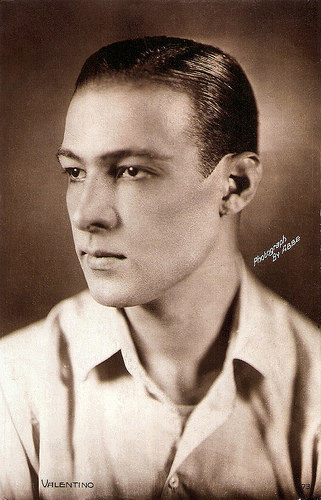
French postcard by Cinémagazine-Edition, Paris. Photo: James Abbe.
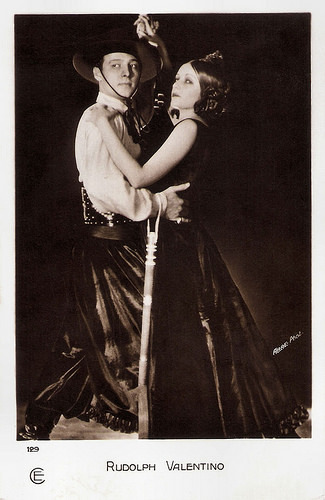
With Natacha Rambova. French postcard by Cinémagazine-Edition, no. 129. Photo: James Abbe.
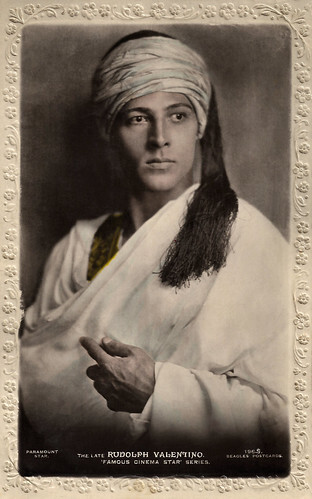
British postcard in the Famous Cinema Star Series by Beagles, no. 196.S. Photo: Paramount. Publicity still for The Sheik (George Fitzmaurice, 1921). Valentino wore the same costume in The Son of the Sheik, so we doubted for which of the two films this still was taken. However, Paramount was the producer of The Sheik.
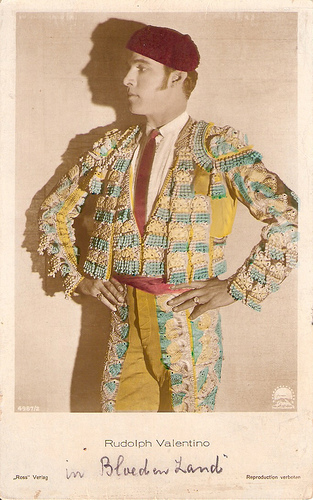
German postcard by Ross Verlag, no. 4987/2, 1929-1930. Photo: Paramount. Publicity still for Blood and Sand (Fred Niblo, 1922).
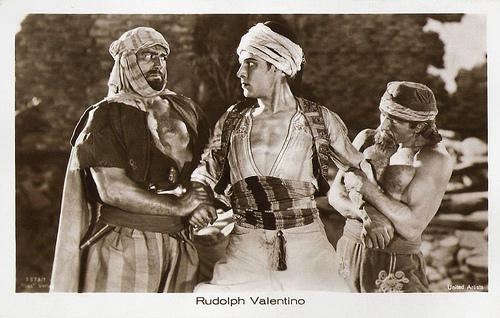
German postcard by Ross Verlag, no. 3373/1, 1928-1929. Photo: United Artists. Publicity still for The Son of the Sheik (George Fitzmaurice, 1926).
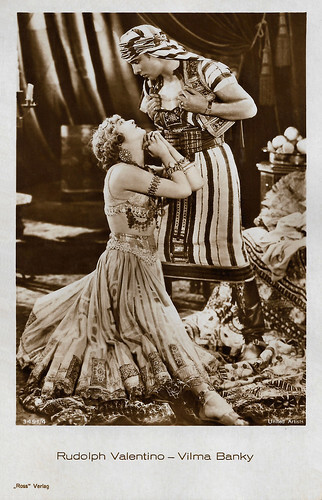
German postcard by Ross Verlag, no. 3491/4, 1928-1929. Photo: United Artists. Rudolph Valentino and Vilma Bánky in The Son of the Sheik (George Fitzmaurice, 1926).
Delicious little devil
Rudolph Valentino was born Rodolfo Alfonso Raffaello Pierre Filibert Guglielmi di Valentina d'Antonguella in 1895 in Castellaneta, Apulia, Kingdom of Italy. He had a French mother, Marie Berta Gabrielle née Barbin, and an Italian father, Giovanni Antonio Giuseppe Fedele Guglielmi di Valentina d'Antonguella, a veterinarian who died of malaria when Rodolfo was 11.
Unable to secure employment, the 18-years-old Rodolfo departed for the United States in 1913. In New York, the handsome young man supported himself as a taxi dancer (someone who danced with women for 10 cents a dance), among other occupations. In 1917, Valentino joined an operetta company that travelled to Utah, where it disbanded.
He then joined an Al Jolson production of 'Robinson Crusoe, Jr.' which was travelling to Los Angeles. By fall, he was in San Francisco with a bit part in a theatrical production of 'Nobody Home'.
While in town, actor Norman Kerry , helped Valentino land a few minor roles in films and by 1919 the young Italian was typecast as a shifty-eyed Latino villain.
He appeared as the second lead in The Delicious Little Devil (Robert Z. Leonard, 1919) with Mae Murray . He was credited Rudolpho De Valintine.
During this period he married small-time actress Jean Acker. Acker was a lesbian, involved in a love triangle with actresses Grace Darmond and Alla Nazimova , and the union with Valentino didn't last long.
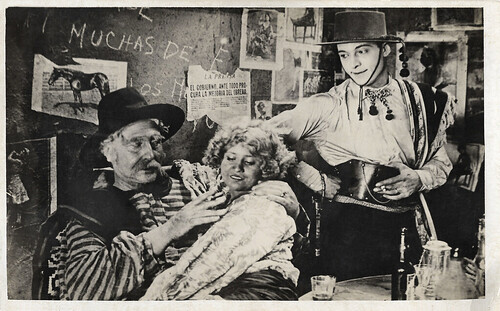
Vintage postcard. Rudolph Valentino in The Four Horsemen of the Apocalypse (Rex Ingram, 1921). Madariaga "The Centaur" (Pomeroy Cannon), the richest man in Argentine, and his grandson, the handsome tango dancer Julio (Rudolph Valentino).
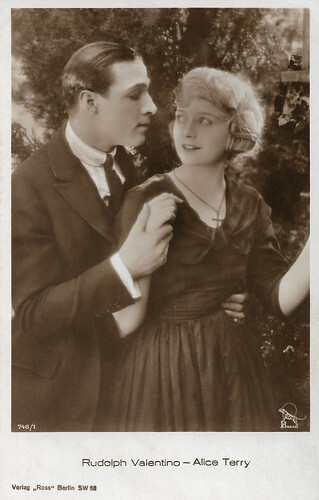
German postcard by Ross Verlag, no. 748/1. Photo: Bafag. Rudolph Valentino and Alice Terry in The Conquering Power (Rex Ingram, 1921).
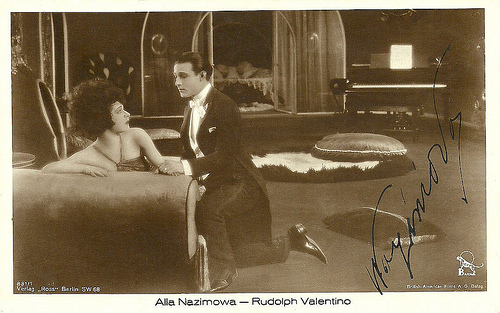
German postcard by Ross Verlag, no. 831/1, 1925-1926. Photo: British American Films / Balag. Collection: Didier Hanson. Publicity still for Camille (Ray C. Smallwood, 1921) with Alla Nazimova .
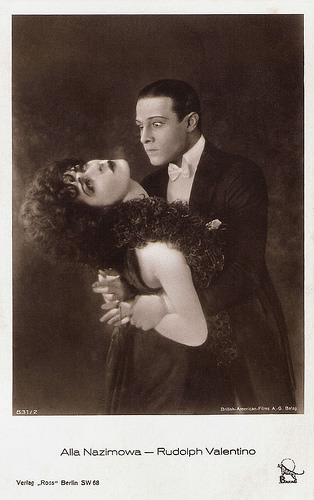
German postcard by Ross Verlag, Berlin, no. 831/2, 1925-1926. Photo: British-American-Films A.G. (Bafag). Publicity still for Camille (Ray C. Smallwood, 1921) with Alla Nazimova .
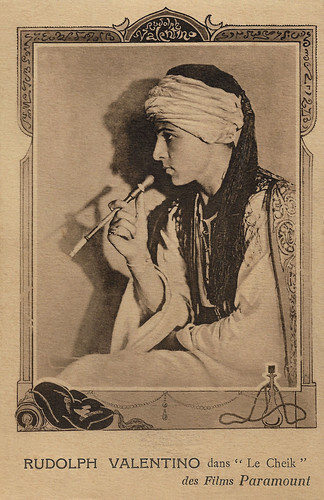
French postcard. Photo: Les Films Paramount. Rudolph Valentino in The Sheik (George Melford, 1921).
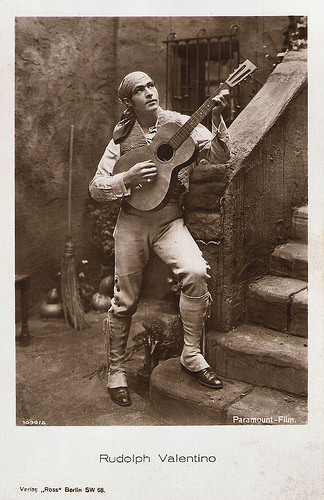
German postcard by Ross Verlag, no. 1090/5, 1927-1928. Photo: Paramount-Film. Publicity still for Blood and Sand (Fred Niblo, 1922).
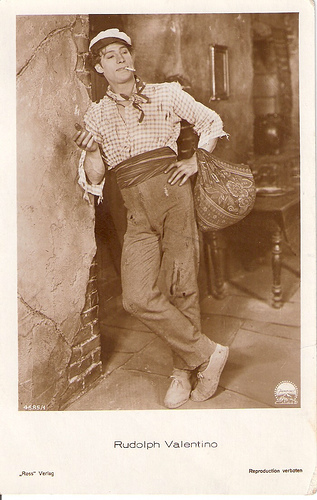
German postcard by Ross Verlag, no. 4685/1, 1929-1930. Photo: Paramount. Publicity still for Blood and Sand (Fred Niblo, 1922).
A unique brand of sexual charisma
Finally, in 1921, Rudolph Valentino's star potential was realised by screenwriter June Mathis, who convinced director Rex Ingram to cast Valentino as Julio Desnoyers in The Four Horseman of the Apocalypse (1921). A sensation was the scene in which he dances a sensual tango.
The Four Horseman of the Apocalypse became a critical success and was one of the first films to make $1,000,000 at the box office. It remains to this day the sixth-highest grossing silent film ever.
Valentino's unique brand of sexual charisma scored an immediate hit with the public, but Metro failed to capitalise on its new personality. For his follow-up film, they forced him into a bit part in a B-film called Uncharted Seas (Wesley Ruggles, 1921). In this film, Valentino met his second wife, Natacha Rambova.
Rambova, Mathis, Ivano, and Valentino began work on the Alla Nazimova film Camille (Ray C. Smallwood, 1921), based on the novel by Alexandre Dumas fils . Valentino was cast in the role of the idealistic young Armand, who falls in love with the older courtesan Camille (Nazimova). The film, mostly under the control of Rambova and Nazimova, was considered too avant-garde by critics and the public.
Valentino then accepted an offer at Famous Players-Lasky, the forerunner of the present-day Paramount Pictures. Here he co-starred with Agnes Ayres in The Sheik (George Melford, 1922), a role that would solidify his reputation as the ‘Latin lover’. Hal Erickson at AllMovie : “Despite the film's shortcomings, Valentino's magnetic personality permeated every frame, firmly establishing him as a star of the first rank.”
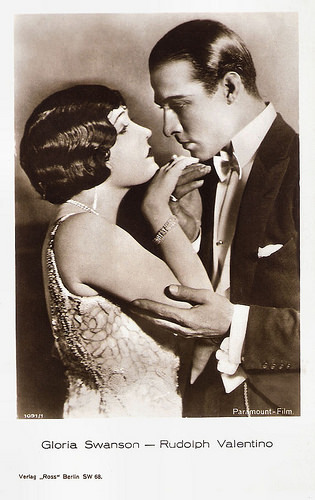
German postcard by Ross Verlag, Berlin, no. 1091/1, 1927-1928. Photo: Paramount-Film. Publicity still for Beyond the Rocks (Sam Wood, 1922) with Gloria Swanson .
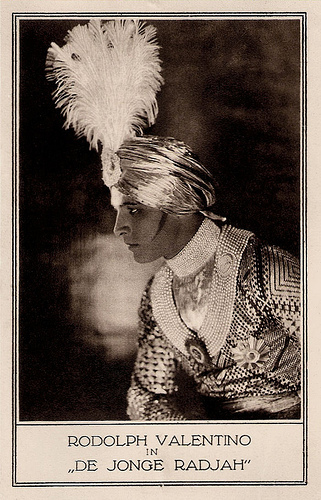
Dutch postcard, 1924. Publicity card to promote The Young Rajah (Phil Rosen, 1922), which was presented in the Asta Theatre in The Hague, The Netherlands. Rudolph Valentino was in this film credited as Rodolph Valentino. The Young Rajah was reportedly a lost film, but a few years ago the last forty minutes of a nitrate print were discovered. Paramount used stills and trailers to reconstruct the film and did according to reviewer Ischlake on IMDb a very commendable job.
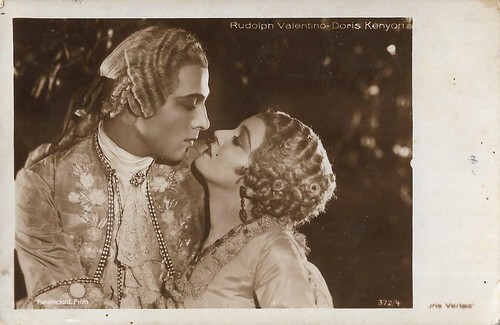
Austrian postcard by Iris Verlag, no. 372/4. Photo: Paramount-Film. Rudolph Valentino and Doris Kenyon in Monsieur Beaucaire (Sidney Olcott, 1924).
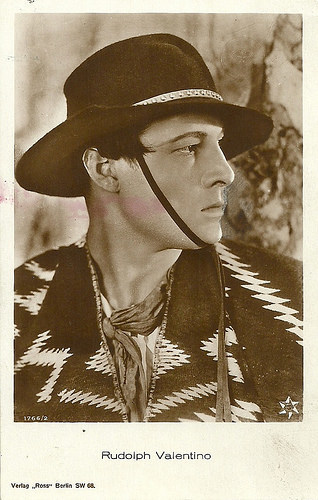
German postcard by Ross Verlag, no. 1766/2, 1927-1928. Rudolph Valentino in A Sainted Devil (Joseph Henabery, 1924).
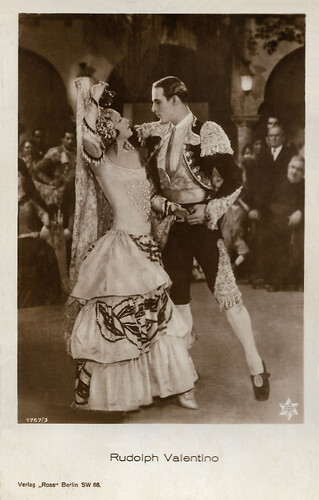
German postcard by Ross Verlag, no. 1767/3, 1927-1928. Photo Stern Film Verleih. Rudolph Valentino and Helena D'Algy in the American silent film A Sainted Devil (Joseph Henabery, 1924).
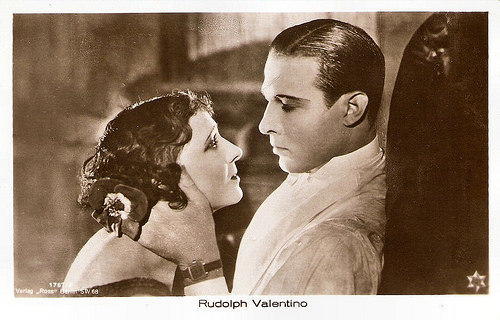
German postcard for Ross Verlag, Berlin, no. 1787/2, 1927-1928. Photo: Famous Players-Lasky Corporation. Publicity still for A Sainted Devil (Joseph Henabery, 1924) with Louise Lagrange.
Pink powderpuff
Rudolph Valentino was rushed by Paramount from one film to another. He starred alongside Gloria Swanson in Beyond the Rocks (Sam Wood, 1922), but it was a critical disappointment.
Valentino began work on another Mathis-penned film, Blood and Sand (Fred Niblo, 1922), co-starring with vamp Nita Naldi. Valentino played the bullfighter Juan Gallardo. He initially believed the film would be shot in Spain and was upset to learn that the studio planned on shooting on a Hollywood backlot.
After finishing the film, Valentino married Rambova, which led to a sensational bigamy trial. The pair were forced to have their marriage annulled and separated for a year. Despite the trial, the film was still a success. Blood and Sand went on to become one of the top four grossing movies of 1922, and Valentino considered this one of his best films.
Valentino took a two-year sabbatical, devoting his time to writing and publishing poetry. He returned to the screen in such disappointing productions as Monsieur Beaucaire (Sidney Olcott, 1924) and Cobra (Joseph Henabery, 1925). A columnist for the Chicago Tribune characterised the actor as a 'pink powder puff'. Valentino angrily challenged the writer to a fistfight, but the waspish scrivener refused.
Valentino divorced his second wife Natacha Rambova and formed his own production company, playing virile leading roles in The Eagle (Clarence Brown, 1925) and Son of the Sheik (George Fitzmaurice, 1926), two of his best films.
A few months after completing Son of the Sheik, he was hospitalised in New York with a perforated ulcer. Complications quickly set in, and on 23 August 1926, the 31-year-old actor died. Nearly 80,000 hysterical women, including actress Pola Negri, crowded into Campbell's Funeral Parlour in New York.
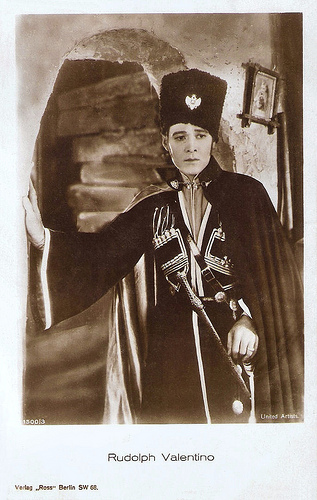
German postcard by Ross Verlag, no. 1500/3, 1927-1928. Photo: United Artists. Rudolph Valentino in The Eagle (Clarence Brown, 1925).
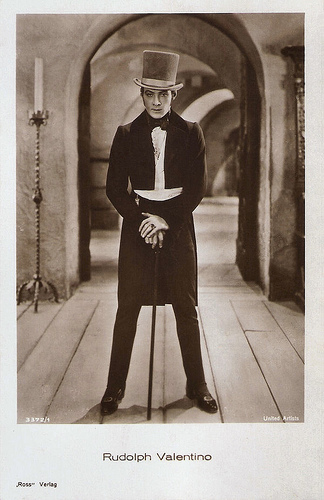
German postcard by Ross Verlag, Berlin, no. 3372/1, 1928-1929. Photo: United Artists. Rudolph Valentino in The Eagle (Clarence Brown, 1925).
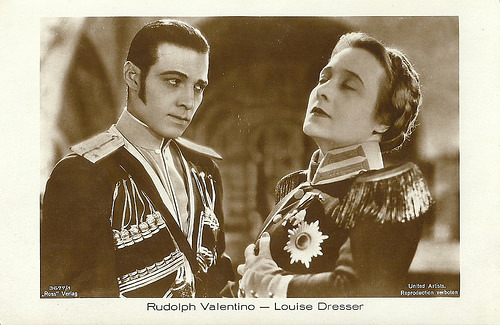
German postcard by Ross Verlag, no. 3677/1, 1928-1929. Photo: United Artists. Rudolph Valentino and Louise Dresser in The Eagle (Clarence Brown, 1925).
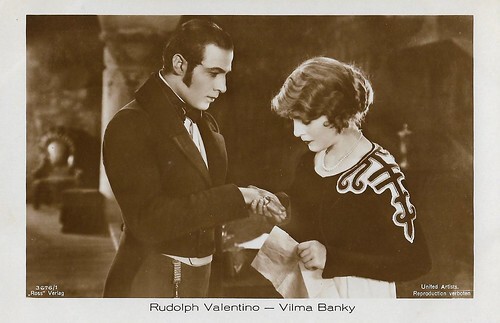
German postcard by Ross Verlag, no. 3676/1, 1928-1929. Photo: United Artists. Rudolph Valentino and Vilma Banky in The Eagle (Clarence Brown, 1925).
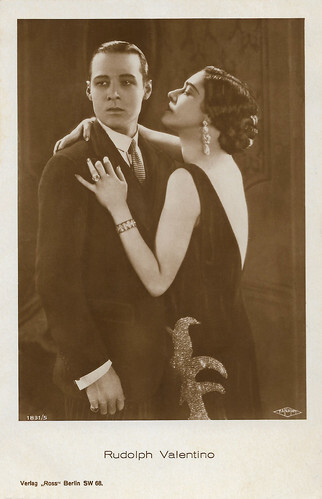
German postcard by Verlag Ross, Berlin, no. 1831/5, 1927-1928. Photo: Fanamet. Rudolph Valentino and Nita Naldi in Cobra (Joseph Henabery, 1925).
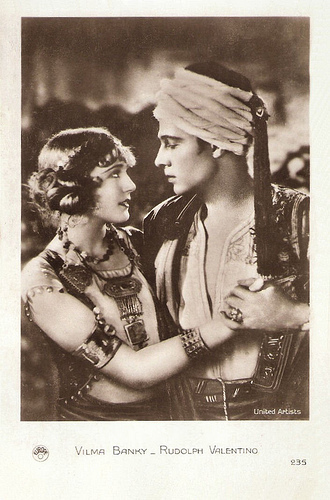
French postcard by Europa, no. 235. Photo: United Artists. Rudolph Valentino in The Son of the Sheik (George Fitzmaurice, 1926) with Vilma Banky .
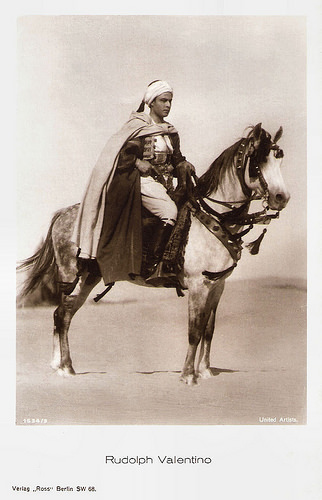
German postcard by Ross Verlag, no. 1534/3, 1927-1928. Photo: United Artists. Rudolph Valentino in The Son of the Sheik (George Fitzmaurice, 1926).
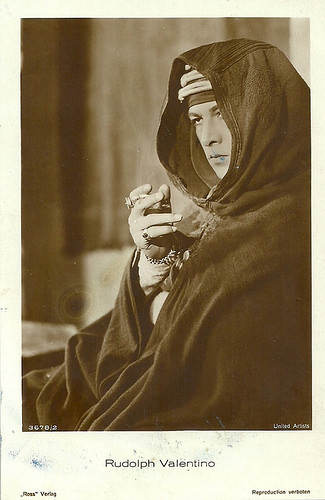
German postcard by Ross Verlag, no. 3678/2, 1928-1929. Photo: United Artists. Rudolph Valentino in The Son of the Sheik (George Fitzmaurice, 1926).
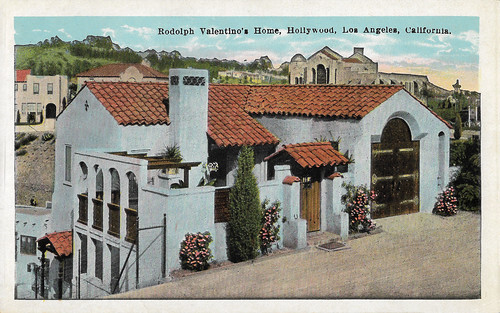
American postcard by California Postcard Co., Los Angeles, California, no. 26829N. Caption: Rudolph Valentino's Home, Hollywood, Los Angeles, California.
Sources: Hal Erickson (AllMovie), Wikipedia, and .

French postcard by Cinémagazine-Edition, Paris. Photo: James Abbe.

With Natacha Rambova. French postcard by Cinémagazine-Edition, no. 129. Photo: James Abbe.

British postcard in the Famous Cinema Star Series by Beagles, no. 196.S. Photo: Paramount. Publicity still for The Sheik (George Fitzmaurice, 1921). Valentino wore the same costume in The Son of the Sheik, so we doubted for which of the two films this still was taken. However, Paramount was the producer of The Sheik.

German postcard by Ross Verlag, no. 4987/2, 1929-1930. Photo: Paramount. Publicity still for Blood and Sand (Fred Niblo, 1922).

German postcard by Ross Verlag, no. 3373/1, 1928-1929. Photo: United Artists. Publicity still for The Son of the Sheik (George Fitzmaurice, 1926).

German postcard by Ross Verlag, no. 3491/4, 1928-1929. Photo: United Artists. Rudolph Valentino and Vilma Bánky in The Son of the Sheik (George Fitzmaurice, 1926).
Delicious little devil
Rudolph Valentino was born Rodolfo Alfonso Raffaello Pierre Filibert Guglielmi di Valentina d'Antonguella in 1895 in Castellaneta, Apulia, Kingdom of Italy. He had a French mother, Marie Berta Gabrielle née Barbin, and an Italian father, Giovanni Antonio Giuseppe Fedele Guglielmi di Valentina d'Antonguella, a veterinarian who died of malaria when Rodolfo was 11.
Unable to secure employment, the 18-years-old Rodolfo departed for the United States in 1913. In New York, the handsome young man supported himself as a taxi dancer (someone who danced with women for 10 cents a dance), among other occupations. In 1917, Valentino joined an operetta company that travelled to Utah, where it disbanded.
He then joined an Al Jolson production of 'Robinson Crusoe, Jr.' which was travelling to Los Angeles. By fall, he was in San Francisco with a bit part in a theatrical production of 'Nobody Home'.
While in town, actor Norman Kerry , helped Valentino land a few minor roles in films and by 1919 the young Italian was typecast as a shifty-eyed Latino villain.
He appeared as the second lead in The Delicious Little Devil (Robert Z. Leonard, 1919) with Mae Murray . He was credited Rudolpho De Valintine.
During this period he married small-time actress Jean Acker. Acker was a lesbian, involved in a love triangle with actresses Grace Darmond and Alla Nazimova , and the union with Valentino didn't last long.

Vintage postcard. Rudolph Valentino in The Four Horsemen of the Apocalypse (Rex Ingram, 1921). Madariaga "The Centaur" (Pomeroy Cannon), the richest man in Argentine, and his grandson, the handsome tango dancer Julio (Rudolph Valentino).

German postcard by Ross Verlag, no. 748/1. Photo: Bafag. Rudolph Valentino and Alice Terry in The Conquering Power (Rex Ingram, 1921).

German postcard by Ross Verlag, no. 831/1, 1925-1926. Photo: British American Films / Balag. Collection: Didier Hanson. Publicity still for Camille (Ray C. Smallwood, 1921) with Alla Nazimova .

German postcard by Ross Verlag, Berlin, no. 831/2, 1925-1926. Photo: British-American-Films A.G. (Bafag). Publicity still for Camille (Ray C. Smallwood, 1921) with Alla Nazimova .

French postcard. Photo: Les Films Paramount. Rudolph Valentino in The Sheik (George Melford, 1921).

German postcard by Ross Verlag, no. 1090/5, 1927-1928. Photo: Paramount-Film. Publicity still for Blood and Sand (Fred Niblo, 1922).

German postcard by Ross Verlag, no. 4685/1, 1929-1930. Photo: Paramount. Publicity still for Blood and Sand (Fred Niblo, 1922).
A unique brand of sexual charisma
Finally, in 1921, Rudolph Valentino's star potential was realised by screenwriter June Mathis, who convinced director Rex Ingram to cast Valentino as Julio Desnoyers in The Four Horseman of the Apocalypse (1921). A sensation was the scene in which he dances a sensual tango.
The Four Horseman of the Apocalypse became a critical success and was one of the first films to make $1,000,000 at the box office. It remains to this day the sixth-highest grossing silent film ever.
Valentino's unique brand of sexual charisma scored an immediate hit with the public, but Metro failed to capitalise on its new personality. For his follow-up film, they forced him into a bit part in a B-film called Uncharted Seas (Wesley Ruggles, 1921). In this film, Valentino met his second wife, Natacha Rambova.
Rambova, Mathis, Ivano, and Valentino began work on the Alla Nazimova film Camille (Ray C. Smallwood, 1921), based on the novel by Alexandre Dumas fils . Valentino was cast in the role of the idealistic young Armand, who falls in love with the older courtesan Camille (Nazimova). The film, mostly under the control of Rambova and Nazimova, was considered too avant-garde by critics and the public.
Valentino then accepted an offer at Famous Players-Lasky, the forerunner of the present-day Paramount Pictures. Here he co-starred with Agnes Ayres in The Sheik (George Melford, 1922), a role that would solidify his reputation as the ‘Latin lover’. Hal Erickson at AllMovie : “Despite the film's shortcomings, Valentino's magnetic personality permeated every frame, firmly establishing him as a star of the first rank.”

German postcard by Ross Verlag, Berlin, no. 1091/1, 1927-1928. Photo: Paramount-Film. Publicity still for Beyond the Rocks (Sam Wood, 1922) with Gloria Swanson .

Dutch postcard, 1924. Publicity card to promote The Young Rajah (Phil Rosen, 1922), which was presented in the Asta Theatre in The Hague, The Netherlands. Rudolph Valentino was in this film credited as Rodolph Valentino. The Young Rajah was reportedly a lost film, but a few years ago the last forty minutes of a nitrate print were discovered. Paramount used stills and trailers to reconstruct the film and did according to reviewer Ischlake on IMDb a very commendable job.

Austrian postcard by Iris Verlag, no. 372/4. Photo: Paramount-Film. Rudolph Valentino and Doris Kenyon in Monsieur Beaucaire (Sidney Olcott, 1924).

German postcard by Ross Verlag, no. 1766/2, 1927-1928. Rudolph Valentino in A Sainted Devil (Joseph Henabery, 1924).

German postcard by Ross Verlag, no. 1767/3, 1927-1928. Photo Stern Film Verleih. Rudolph Valentino and Helena D'Algy in the American silent film A Sainted Devil (Joseph Henabery, 1924).

German postcard for Ross Verlag, Berlin, no. 1787/2, 1927-1928. Photo: Famous Players-Lasky Corporation. Publicity still for A Sainted Devil (Joseph Henabery, 1924) with Louise Lagrange.
Pink powderpuff
Rudolph Valentino was rushed by Paramount from one film to another. He starred alongside Gloria Swanson in Beyond the Rocks (Sam Wood, 1922), but it was a critical disappointment.
Valentino began work on another Mathis-penned film, Blood and Sand (Fred Niblo, 1922), co-starring with vamp Nita Naldi. Valentino played the bullfighter Juan Gallardo. He initially believed the film would be shot in Spain and was upset to learn that the studio planned on shooting on a Hollywood backlot.
After finishing the film, Valentino married Rambova, which led to a sensational bigamy trial. The pair were forced to have their marriage annulled and separated for a year. Despite the trial, the film was still a success. Blood and Sand went on to become one of the top four grossing movies of 1922, and Valentino considered this one of his best films.
Valentino took a two-year sabbatical, devoting his time to writing and publishing poetry. He returned to the screen in such disappointing productions as Monsieur Beaucaire (Sidney Olcott, 1924) and Cobra (Joseph Henabery, 1925). A columnist for the Chicago Tribune characterised the actor as a 'pink powder puff'. Valentino angrily challenged the writer to a fistfight, but the waspish scrivener refused.
Valentino divorced his second wife Natacha Rambova and formed his own production company, playing virile leading roles in The Eagle (Clarence Brown, 1925) and Son of the Sheik (George Fitzmaurice, 1926), two of his best films.
A few months after completing Son of the Sheik, he was hospitalised in New York with a perforated ulcer. Complications quickly set in, and on 23 August 1926, the 31-year-old actor died. Nearly 80,000 hysterical women, including actress Pola Negri, crowded into Campbell's Funeral Parlour in New York.

German postcard by Ross Verlag, no. 1500/3, 1927-1928. Photo: United Artists. Rudolph Valentino in The Eagle (Clarence Brown, 1925).

German postcard by Ross Verlag, Berlin, no. 3372/1, 1928-1929. Photo: United Artists. Rudolph Valentino in The Eagle (Clarence Brown, 1925).

German postcard by Ross Verlag, no. 3677/1, 1928-1929. Photo: United Artists. Rudolph Valentino and Louise Dresser in The Eagle (Clarence Brown, 1925).

German postcard by Ross Verlag, no. 3676/1, 1928-1929. Photo: United Artists. Rudolph Valentino and Vilma Banky in The Eagle (Clarence Brown, 1925).

German postcard by Verlag Ross, Berlin, no. 1831/5, 1927-1928. Photo: Fanamet. Rudolph Valentino and Nita Naldi in Cobra (Joseph Henabery, 1925).

French postcard by Europa, no. 235. Photo: United Artists. Rudolph Valentino in The Son of the Sheik (George Fitzmaurice, 1926) with Vilma Banky .

German postcard by Ross Verlag, no. 1534/3, 1927-1928. Photo: United Artists. Rudolph Valentino in The Son of the Sheik (George Fitzmaurice, 1926).

German postcard by Ross Verlag, no. 3678/2, 1928-1929. Photo: United Artists. Rudolph Valentino in The Son of the Sheik (George Fitzmaurice, 1926).

American postcard by California Postcard Co., Los Angeles, California, no. 26829N. Caption: Rudolph Valentino's Home, Hollywood, Los Angeles, California.
Sources: Hal Erickson (AllMovie), Wikipedia, and .
Published on November 28, 2022 22:00
November 27, 2022
Bus Stop (1956)
Bus Stop (Joshua Logan, 1956) marked Marilyn Monroe's return to the screen after a one-year absence. She had been disappointed with the roles she was assigned at 20th Century Fox, so she left Hollywood for New York City to study acting with Lee Strasberg at the Actors Studio. Fox finally awarded her a new contract, which gave her more control and a larger salary. Marilyn later called Bus Stop her favourite film and she thought she did her best work here. And although the film is uneven, Marilyn indeed created a complete and deeply touching character. The film also has one of Monroe's best-remembered songs, 'That Old Black Magic', which is as funny as it is heartbreaking.
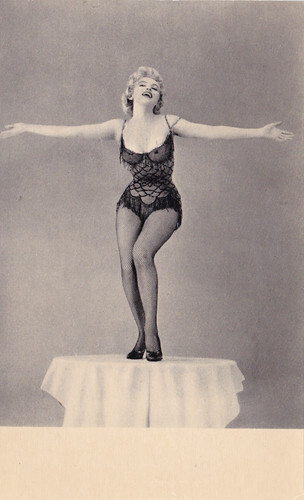
Yugoslavian postcard by Epoha, Zagreb, no. 4. Marilyn Monroe in her costume for Bus Stop (Joshua Logan, 1956). Collection: Carla Bosch.
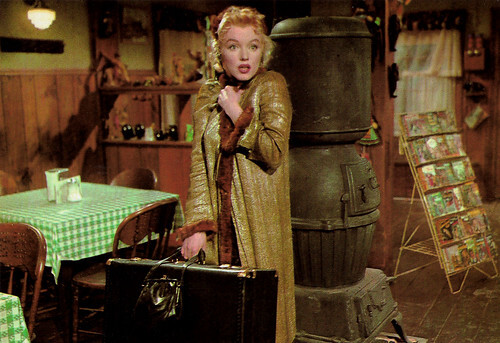
American postcard by Classico San Francisco, no. 105-017. Photo: 20th Century Fox. Marilyn Monroe in Bus Stop (Joshua Logan, 1956).
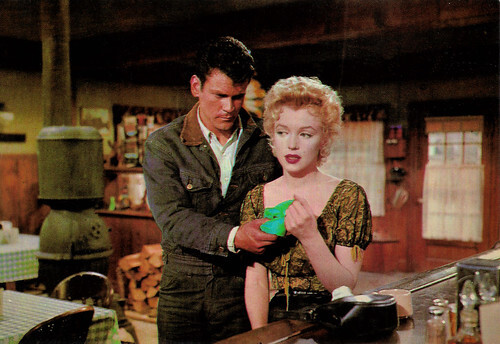
American postcard by Classico San Francisco, no. 105-018. Photo: 20th Century Fox. Don Murray and Marilyn Monroe in Bus Stop (Joshua Logan, 1956).
An acclaimed over-the-top performance
Naive but stubborn cowboy Beauregard "Bo" Decker (Don Murray) takes the bus from Montana to Phoenix to make his fortune at the Rodeo. His Fatherly friend Virgil Blessing (Arthur O'Connell) encourages him to talk to girls but he doesn't have much experience. In Phoenix, singer Chérie ( Marilyn Monroe ) at the Blue Dragon Cafe, who is aiming to go to Hollywood, is forced to hustle Virgil to pay for her drinks. Although she has only moderate talent, Chérie dreams of a great career as a "chanteuse". Bo falls for her right away. He has found himself an Angel to take back to his Montana ranch and become his beloved wife.
Cherie confesses that she finds him really handsome, according to his first name "Beauregard". In his simple-mindedness, he interprets a kiss from her as an engagement. Cherie likes him but has no intention of marrying him or going back to Montana with him. Bo keeps ignorantly dragging her around expecting to get married. She tries to run away to Los Angeles but he literally ropes her like cattle and forces her to board the bus to his home in Montana. When the bus stops at Grace's Diner the passengers learn that the road ahead is blocked by snow.
In Grace's Diner, a bus stop somewhere in Wyoming, the other passengers finally give Beau his 'comeuppance'. By now everyone knows of the kidnapping, but Bo is determined to have Chérie. Bo lashes out and is finally beaten up by the bus driver. He binds up and promises to behave himself. The next morning, he apologises to Chérie and says she can go wherever she wants. Chérie, who now sees that Bo also has a soft side, forgives him and now decides to go with him voluntarily.
The original play 'Bus Stop' by William Inge has only a few elements in common with the film. The play is set in a diner in Kansas, in the vicinity of Kansas City, Missouri. During a snowstorm, a number of passengers take shelter from the snow. Love relationships develop between the various characters, including between cowboy Bo and singer Chérie. For the film, the relationship between Bo and Chérie was taken out and magnified. Especially Chérie's role was increased and the whole introduction of the rodeo was added.
The original Broadway production of 'Bus Stop' opened at the Music Box Theater in New York on 2 March 1955, ran for 478 performances and was nominated for the 1956 Tony Award for Best Play. Before he achieved success on Broadway, Inge wrote a one-act play, 'People in the Wind,' the story of strangers caught in a storm at a bus station in a small Midwestern town. It was the inspiration for 'Bus Stop'. Marilyn Monroe was technically in charge of the film adaptation as the head of MMP (Marilyn Monroe Productions, her own film production company.
The film was shot on location in Ketchum, Idaho, North Fork Store, Idaho and Phoenix, Arizona. Studio filming was done at 20th Century Fox Studios in Los Angeles. Director Joshua Logan, known for his work on Broadway, cast Don Murray as cowboy Bo after seeing him in Thornton Wilder's 'The Skin of Our Teeth' on Broadway. Murray, a New Yorker, had never been astride a horse until the scene in which he rides one in a parade. Bus Stop marked Murray's film debut and Bo would be Murray's only Oscar-winning performance. Hope Lange also made her first film appearance in Bus Stop. Don Murray fell in love with her and they would shortly marry.
There are several fine performances in the film. Arthur O'Connell is delightful as the cowboy's pal who big-brothers him with loving patience. Eileen Heckart amuses as the old-time friend, and Betty Field is strong enough as the bus stop owner. Carl, the firm bus driver and former state wrestling champ, was played by actor Robert Bray. He had a long career in films and TV but would be best remembered as Lassie's co-star, forest ranger Corey Stuart, in the TV series.
At the Oscar ceremony, Don Murray received an Oscar for Best Male Supporting Actor. However, his over-the-top performance as Beau is now problematic. There is no way we accept in 2022 a cowboy as a sympathetic, romantic hero when he chases a woman down, rips off half of her dress, breaks into her dressing room, follows her out the window to a bus station, lassos her and kidnaps her by dragging her onto the bus. Murray is so loud, abrasive and stupid that he often overshadows Monroe's fragile performance and thus nearly ruins the film. And by the time Beau apologises for his bad behaviour, we no longer care about him.
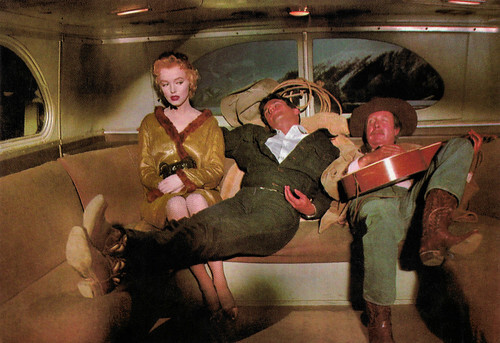
American postcard by Classico San Francisco, no. 105-019. Photo: 20th Century Fox. Marilyn Monroe, Don Murray and Arthur O'Connell in Bus Stop (Joshua Logan, 1956).
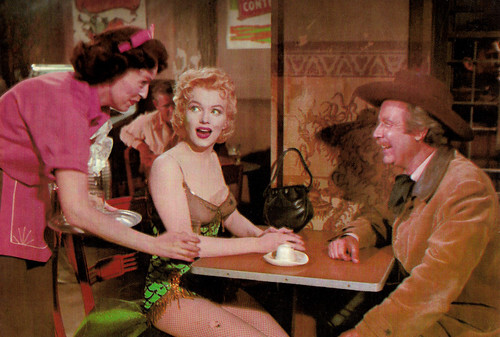
American postcard by Classico San Francisco, no. 105-021. Photo: 20th Century Fox. Eileen Heckart, Marilyn Monroe and Arthur O'Connell in Bus Stop (Joshua Logan, 1956).
Get set for a rattling surprise
Bus Stop (Joshua Logan, 1956) was the first film of Marilyn Monroe 's new seven-year contract with Fox. She played Cherie, a role that Kim Stanley originated on Broadway. She had seen and loved Stanley's performance in the Broadway production and patterned her accent on Stanley's, as well as those accents she had heard during her own time in the South. Monroe worked diligently on the hillbilly twang, speaking quite differently than in her other movies, and subverted her natural singing talent to make it painfully clear that Chérie was not gifted in that department. Most of Monroe's delivery of 'That Old Black Magic' by Harold Arlen and Johnny Mercer was captured live on camera without lip-synching - a rarity in those days.
Monroe felt that Cherie, although she is a very sexual character, should have a slightly shabby look as a pale and cheaply costumed saloon singer. She rejected most of the original costume designs by Travilla and rifled through the studio costume department to find things she thought suited the character. The black-lace blouse that she wears in the early scenes was originally worn by Susan Hayward in With a Song in My Heart (1952). Working with Milton L. Greene, Joshua Logan and her makeup artist, Allan Snyder, she opted for an almost-white facial and body makeup that made Cherie look washed-out and faintly unhealthy as if she slept all day and avoided the sun.
Hairstylist Helen Turpin changed Monroe's platinum-blonde hair to a subdued honey-blonde that offered more contrast to the white skin. Studio executives thought Marilyn should always be "honey-coloured" all over, but she and Logan stuck to their guns. In subsequent films, she would continue to favour lighter, more luminous makeup even when her hair was once again platinum.
Marilyn Monroe's badly-needed champion on the film set was her director. Joshua Logan, who had studied with Konstantin Stanislavsky in Russia. He understood the needs of actors using 'the Method' and had come to adore Marilyn's talent and respect her native intelligence. "She made directing worthwhile," he said later. "She had such fascinating things happen to her face and skin and hair and body as she read lines, that she was... inspiring." Logan involved his star in script discussions and supported her efforts to 'find' Cherie through her experiments with makeup, costuming, hairstyles and - above all - intense identification with her character. By allowing the cameras to continue rolling, he gave Monroe every opportunity to find continuity in her role and listened carefully when she made suggestions about her blocking and camera angles on this, her 24th film.
Paula Strasberg had replaced Natasha Lytess as Monroe's on-the-spot acting coach. As a friend of the Strasbergs who had directed their daughter, Susan Strasberg, in Picnic (Joshua Logan, 1955), he was tolerant of Paula Strasberg's presence and constant influence on Monroe's performance. He did, however, insist that she not be on the sets during actual rehearsals or filming.
Bus Stop (1956) became a box office success in the U.S.A., earning more than $7 million in rentals, and received mainly favourable reviews, with Monroe's performance being highly praised. The New York Times critic Bosley Crowther started his review with "HOLD onto your chairs, everybody, and get set for a rattling surprise. Marilyn Monroe has finally proved herself an actress in Bus Stop. She and the picture are swell!" Marilyn Monroe Productions would produce only one more film - The Prince and the Showgirl (1957), directed by and co-starring Laurence Olivier .
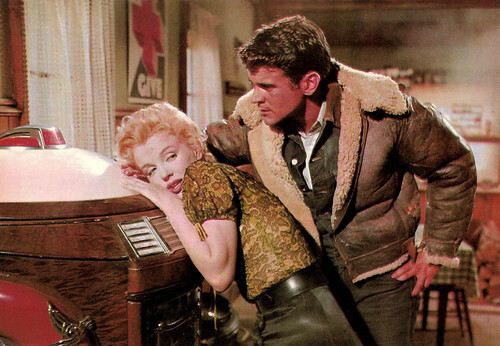
American postcard by Classico San Francisco, no. 105-022. Photo: 20th Century Fox. Marilyn Monroe and Don Murray in Bus Stop (Joshua Logan, 1956).
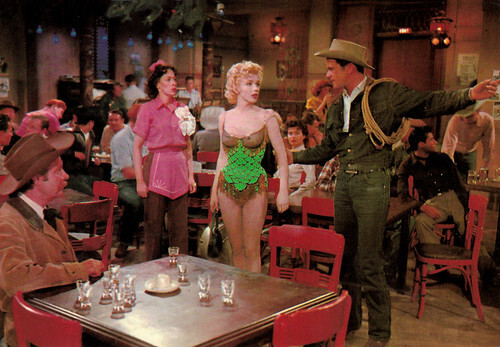
American postcard by Classico San Francisco, no. 105-023. Photo: 20th Century Fox. Arthur O'Connell, Eileen Heckart, Marilyn Monroe and Don Murray in Bus Stop (Joshua Logan, 1956).
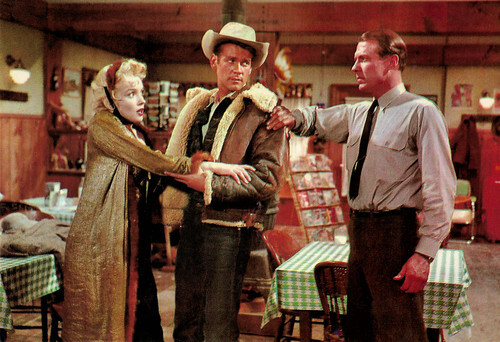
American postcard by Classico San Francisco, no. 105-024. Photo: 20th Century Fox. Marilyn Monroe , Don Murray and Robert Bray in Bus Stop (Joshua Logan, 1956).
Sources: Bosley Crowther (The New York Times), Wikipedia (Dutch, German and English), and IMDb.

Yugoslavian postcard by Epoha, Zagreb, no. 4. Marilyn Monroe in her costume for Bus Stop (Joshua Logan, 1956). Collection: Carla Bosch.

American postcard by Classico San Francisco, no. 105-017. Photo: 20th Century Fox. Marilyn Monroe in Bus Stop (Joshua Logan, 1956).

American postcard by Classico San Francisco, no. 105-018. Photo: 20th Century Fox. Don Murray and Marilyn Monroe in Bus Stop (Joshua Logan, 1956).
An acclaimed over-the-top performance
Naive but stubborn cowboy Beauregard "Bo" Decker (Don Murray) takes the bus from Montana to Phoenix to make his fortune at the Rodeo. His Fatherly friend Virgil Blessing (Arthur O'Connell) encourages him to talk to girls but he doesn't have much experience. In Phoenix, singer Chérie ( Marilyn Monroe ) at the Blue Dragon Cafe, who is aiming to go to Hollywood, is forced to hustle Virgil to pay for her drinks. Although she has only moderate talent, Chérie dreams of a great career as a "chanteuse". Bo falls for her right away. He has found himself an Angel to take back to his Montana ranch and become his beloved wife.
Cherie confesses that she finds him really handsome, according to his first name "Beauregard". In his simple-mindedness, he interprets a kiss from her as an engagement. Cherie likes him but has no intention of marrying him or going back to Montana with him. Bo keeps ignorantly dragging her around expecting to get married. She tries to run away to Los Angeles but he literally ropes her like cattle and forces her to board the bus to his home in Montana. When the bus stops at Grace's Diner the passengers learn that the road ahead is blocked by snow.
In Grace's Diner, a bus stop somewhere in Wyoming, the other passengers finally give Beau his 'comeuppance'. By now everyone knows of the kidnapping, but Bo is determined to have Chérie. Bo lashes out and is finally beaten up by the bus driver. He binds up and promises to behave himself. The next morning, he apologises to Chérie and says she can go wherever she wants. Chérie, who now sees that Bo also has a soft side, forgives him and now decides to go with him voluntarily.
The original play 'Bus Stop' by William Inge has only a few elements in common with the film. The play is set in a diner in Kansas, in the vicinity of Kansas City, Missouri. During a snowstorm, a number of passengers take shelter from the snow. Love relationships develop between the various characters, including between cowboy Bo and singer Chérie. For the film, the relationship between Bo and Chérie was taken out and magnified. Especially Chérie's role was increased and the whole introduction of the rodeo was added.
The original Broadway production of 'Bus Stop' opened at the Music Box Theater in New York on 2 March 1955, ran for 478 performances and was nominated for the 1956 Tony Award for Best Play. Before he achieved success on Broadway, Inge wrote a one-act play, 'People in the Wind,' the story of strangers caught in a storm at a bus station in a small Midwestern town. It was the inspiration for 'Bus Stop'. Marilyn Monroe was technically in charge of the film adaptation as the head of MMP (Marilyn Monroe Productions, her own film production company.
The film was shot on location in Ketchum, Idaho, North Fork Store, Idaho and Phoenix, Arizona. Studio filming was done at 20th Century Fox Studios in Los Angeles. Director Joshua Logan, known for his work on Broadway, cast Don Murray as cowboy Bo after seeing him in Thornton Wilder's 'The Skin of Our Teeth' on Broadway. Murray, a New Yorker, had never been astride a horse until the scene in which he rides one in a parade. Bus Stop marked Murray's film debut and Bo would be Murray's only Oscar-winning performance. Hope Lange also made her first film appearance in Bus Stop. Don Murray fell in love with her and they would shortly marry.
There are several fine performances in the film. Arthur O'Connell is delightful as the cowboy's pal who big-brothers him with loving patience. Eileen Heckart amuses as the old-time friend, and Betty Field is strong enough as the bus stop owner. Carl, the firm bus driver and former state wrestling champ, was played by actor Robert Bray. He had a long career in films and TV but would be best remembered as Lassie's co-star, forest ranger Corey Stuart, in the TV series.
At the Oscar ceremony, Don Murray received an Oscar for Best Male Supporting Actor. However, his over-the-top performance as Beau is now problematic. There is no way we accept in 2022 a cowboy as a sympathetic, romantic hero when he chases a woman down, rips off half of her dress, breaks into her dressing room, follows her out the window to a bus station, lassos her and kidnaps her by dragging her onto the bus. Murray is so loud, abrasive and stupid that he often overshadows Monroe's fragile performance and thus nearly ruins the film. And by the time Beau apologises for his bad behaviour, we no longer care about him.

American postcard by Classico San Francisco, no. 105-019. Photo: 20th Century Fox. Marilyn Monroe, Don Murray and Arthur O'Connell in Bus Stop (Joshua Logan, 1956).

American postcard by Classico San Francisco, no. 105-021. Photo: 20th Century Fox. Eileen Heckart, Marilyn Monroe and Arthur O'Connell in Bus Stop (Joshua Logan, 1956).
Get set for a rattling surprise
Bus Stop (Joshua Logan, 1956) was the first film of Marilyn Monroe 's new seven-year contract with Fox. She played Cherie, a role that Kim Stanley originated on Broadway. She had seen and loved Stanley's performance in the Broadway production and patterned her accent on Stanley's, as well as those accents she had heard during her own time in the South. Monroe worked diligently on the hillbilly twang, speaking quite differently than in her other movies, and subverted her natural singing talent to make it painfully clear that Chérie was not gifted in that department. Most of Monroe's delivery of 'That Old Black Magic' by Harold Arlen and Johnny Mercer was captured live on camera without lip-synching - a rarity in those days.
Monroe felt that Cherie, although she is a very sexual character, should have a slightly shabby look as a pale and cheaply costumed saloon singer. She rejected most of the original costume designs by Travilla and rifled through the studio costume department to find things she thought suited the character. The black-lace blouse that she wears in the early scenes was originally worn by Susan Hayward in With a Song in My Heart (1952). Working with Milton L. Greene, Joshua Logan and her makeup artist, Allan Snyder, she opted for an almost-white facial and body makeup that made Cherie look washed-out and faintly unhealthy as if she slept all day and avoided the sun.
Hairstylist Helen Turpin changed Monroe's platinum-blonde hair to a subdued honey-blonde that offered more contrast to the white skin. Studio executives thought Marilyn should always be "honey-coloured" all over, but she and Logan stuck to their guns. In subsequent films, she would continue to favour lighter, more luminous makeup even when her hair was once again platinum.
Marilyn Monroe's badly-needed champion on the film set was her director. Joshua Logan, who had studied with Konstantin Stanislavsky in Russia. He understood the needs of actors using 'the Method' and had come to adore Marilyn's talent and respect her native intelligence. "She made directing worthwhile," he said later. "She had such fascinating things happen to her face and skin and hair and body as she read lines, that she was... inspiring." Logan involved his star in script discussions and supported her efforts to 'find' Cherie through her experiments with makeup, costuming, hairstyles and - above all - intense identification with her character. By allowing the cameras to continue rolling, he gave Monroe every opportunity to find continuity in her role and listened carefully when she made suggestions about her blocking and camera angles on this, her 24th film.
Paula Strasberg had replaced Natasha Lytess as Monroe's on-the-spot acting coach. As a friend of the Strasbergs who had directed their daughter, Susan Strasberg, in Picnic (Joshua Logan, 1955), he was tolerant of Paula Strasberg's presence and constant influence on Monroe's performance. He did, however, insist that she not be on the sets during actual rehearsals or filming.
Bus Stop (1956) became a box office success in the U.S.A., earning more than $7 million in rentals, and received mainly favourable reviews, with Monroe's performance being highly praised. The New York Times critic Bosley Crowther started his review with "HOLD onto your chairs, everybody, and get set for a rattling surprise. Marilyn Monroe has finally proved herself an actress in Bus Stop. She and the picture are swell!" Marilyn Monroe Productions would produce only one more film - The Prince and the Showgirl (1957), directed by and co-starring Laurence Olivier .

American postcard by Classico San Francisco, no. 105-022. Photo: 20th Century Fox. Marilyn Monroe and Don Murray in Bus Stop (Joshua Logan, 1956).

American postcard by Classico San Francisco, no. 105-023. Photo: 20th Century Fox. Arthur O'Connell, Eileen Heckart, Marilyn Monroe and Don Murray in Bus Stop (Joshua Logan, 1956).

American postcard by Classico San Francisco, no. 105-024. Photo: 20th Century Fox. Marilyn Monroe , Don Murray and Robert Bray in Bus Stop (Joshua Logan, 1956).
Sources: Bosley Crowther (The New York Times), Wikipedia (Dutch, German and English), and IMDb.
Published on November 27, 2022 22:00
November 26, 2022
Published by Kellner-Fotokarten
The 1950s brought Austria the largest film production boom in its history, but without a neorealist or New Wave school, which had revitalised other European cinemas during this era, and with no national subsidies. It was the age of musical comedies, which had already become popular in the 1930s, and of Heimatfilme, sentimental films with a rural setting. The postcards of the Austrian publisher Kellner-Fotokarten illustrate this boom of the Austrian commercial cinema and its stars but they also present many other popular European film stars of the 1950s. Nowadays, Kellner still exists as 'Verlag Kellner Scholtyssek KEG' in Korneuburg, Austria, and the firm still publishes postcards.
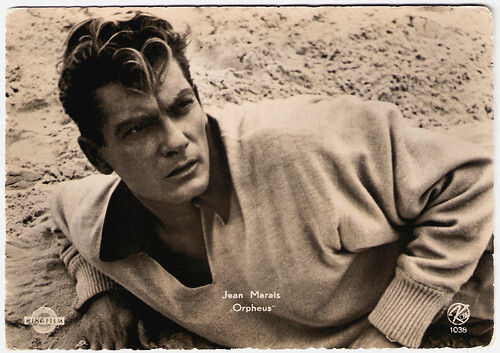
Austrian postcard by Kellner-Fotokarten, Wien, no. 1038. Photo: Ringfilm. Jean Marais in Orphée/Orpheus (Jean Cocteau, 1950).
With his heroic physique, Jean Marais (1913-1998) was France’s answer to Errol Flynn, the epitome of the swashbuckling romantic hero of French cinema. The blonde and incredibly good-looking actor played over 100 roles in film and on television and was also known as a director, writer, painter and sculptor. His mentor was the legendary poet and director Jean Cocteau, who was also his lover.
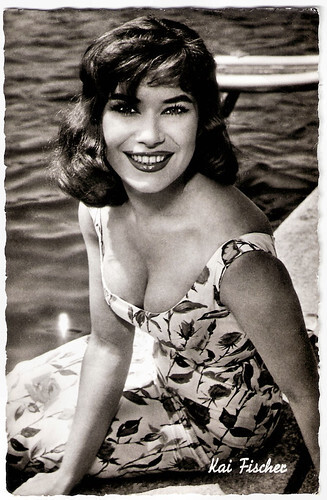
Austrian postcard by Kellner-Fotokarten, Wien, no. 287.
Red-haired and spirited German actress Kai Fischer (1934) appeared in 54 films between 1955 and 2004. She was the naughty bad girl of the Wirtschaftwunder cinema, and also appeared in sexy roles in international productions, either as a prostitute or a gangster girl. Later she worked with famous directors such as Wim Wenders and Ingmar Bergman.
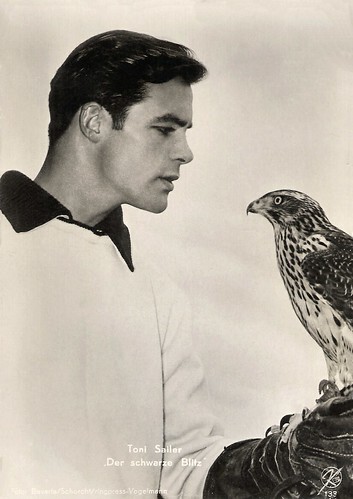
Austrian postcard by Kellner-Fotokarten, Wien, no. 1335. Photo: Bavaria / Schorcht / Ringpress / Vogelmann.
Toni Sailer (1935-2009) was a legendary Austrian alpine ski racer, one of the best the sport has ever produced. The ‘Black Blitz from Kitz’ appeared as an actor and singer in several films and TV series. He was a national hero and matinee idol rolled into one.
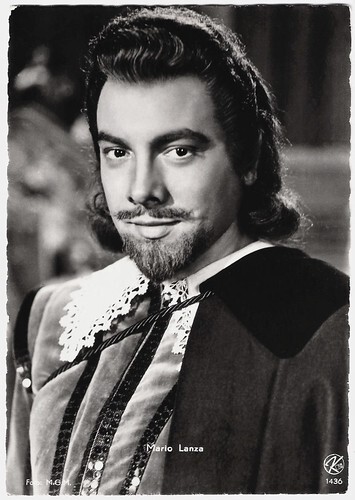
Austrian postcard by Kellner-Fotokarten, Wien, no. 1436. Photo: MGM. Mario Lanza in The Great Caruso (Richard Thorpe, 1951).
Mario Lanza (1921-1959) was an American tenor, actor and Hollywood film star of the late 1940s and the 1950s. His masterpiece was The Great Caruso (Richard Thorpe, 1951), the top-grossing film in the world in 1951. Lanza's voice was so dazzling that an awestruck Arturo Toscanini called it the "voice of the century".
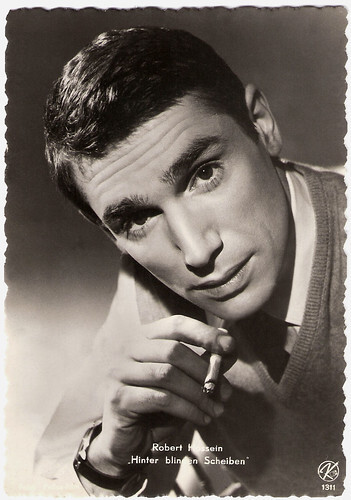
Austrian postcard by Kellner-Fotokarten, Wien, no. 1311. Photo: Robert Hossein in Méfiez-vous, fillettes!/Good Girls Beware! (Yves Allégret, 1957).
French film actor, director and writer Robert Hossein (1927-2020) was generally cast as a tough guy beside such gorgeous actresses as Brigitte Bardot, Sophia Loren and Marina Vlady. He is most famous though as Michèle Mercier's husband in the wildly popular Angélique series of the 1960s.
Heimatfilme
In the aftermath of World War II, Austria's film production soon restarted, partially supported by the Allied Forces.
Austria's cities were devastated and filmmakers set their works in the countryside to show the population the "good and beautiful" Austria.
The Heimatfilm genre came to life and remained popular from the late 1940s to the early 1960s. The films suggested a whole, romantic world untouched by war and the hazards of real life. More than three hundred Heimatfilme were produced in Germany, Austria and Switzerland during the 1950s.
Heimatfilme were usually shot in the Alps, the Black Forest, or the Lüneburg Heath, and always involved the outdoors. Their characteristics were their rural settings, sentimental tone and simplistic morality, and they centred on love, friendship, family and non-urban life.
They also involved the difference between old and young, tradition and progress, and rural and urban life. The typical plot structure involved both a good and bad guy wanting a girl, conflict ensuing, and the good guy ultimately triumphing to win the girl, making all (except the bad guy) happy.
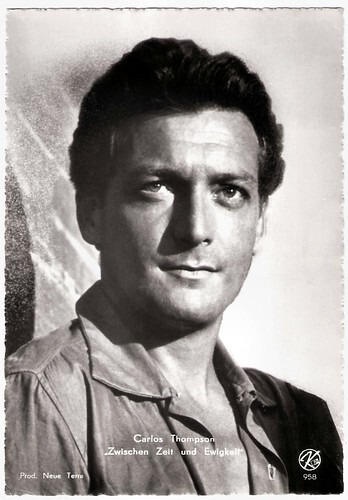
Austrian postcard by Kellner, no. 958. Photo: Neue Terra. Carlos Thompson in Zwischen Zeit und Ewigkeit/Between Time and Eternity (Arthur Maria Rabenalt, 1956).
Handsome Carlos Thompson (1923-1990) was an Argentinian heartthrob of German-Swiss parentage. He started his career in Argentina playing leading roles on stage and in films. In the 1950s, he went to Hollywood and was typically cast as a European womaniser opposite such stars as Lana Turner and Yvonne De Carlo. He moved to Europe and appeared in a large number of German-language films. In the late 1960s, Thompson left acting to become a writer and TV producer.
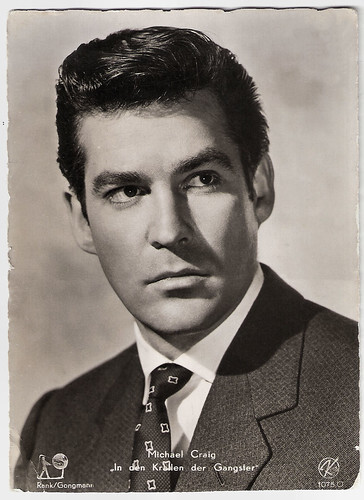
Austrian postcard by Kellner-Fotokarten, Wien, no. 1075 Ö. Photo: Rank Organisation. Michael Craig in House of Secrets (Guy Green, 1956).
British actor Michael Craig (1928) is known for his work in theatre, film and television both in the United Kingdom and Australia. He also worked as a scriptwriter, such as for The Angry Silence (1960). In Italy, Luchino Visconti directed him in Vaghe stelle dell'Orsa.../Sandra (1965).
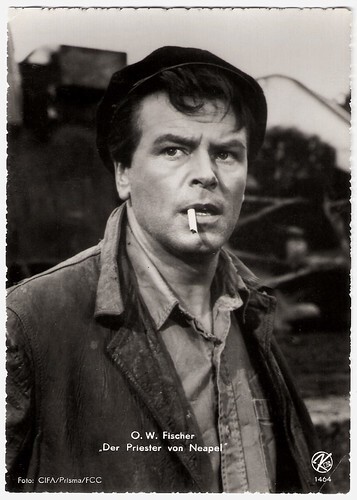
Austrian postcard by Kellner-Fotokarten, Wien, no. 1464. Photo: CIFA / Prisma / FCC. O.W. Fischer in II bacio del sole/Don Vesuvio/The Kiss of the Sun (Siro Marcellini, 1958).
Austrian actor O.W. Fischer (1915–2004) was one of the most popular and highest-paid actors in German-language films in the 1950s. He played the lead in dozens of light romantic comedies and historical pieces. Unlike countrymen Curd Jürgens, Maria Schell and Romy Schneider, he never made it internationally.
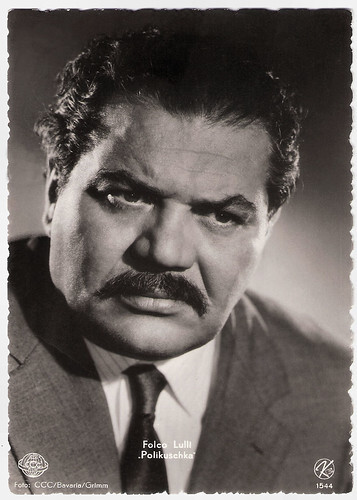
Austrian postcard by Kellner-Fotokarten, Wien, no. 1544. Photo: CCC / Bavaria / Arthur Grimm. Folco Lulli in Polikuschka/Polikuska (Carmine Gallone, 1958).
Acclaimed Italian film actor Folco Lulli (1912–1970) appeared in 104 films between 1946 and 1970, mainly in strong character roles. He was very active in both Italian and French cinema. Now he is best known as one of the four nitro-glycerine truck drivers in Henri Georges Clouzot‘s classic nail-biter La Salaire de la Peur/The Wages of Fear (1953).
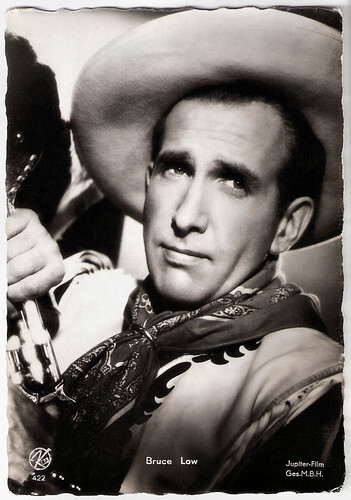
Austrian postcard by Kellner Postkarten, Wien (Vienna), no. 422. Photo: Jupiter-Film Ges.M.B.H. Bruce Low in Geld aus der Luft/Money from the air (Géza von Cziffra, 1954).
Bruce Low (1913-1990) was a Dutch Schlager and gospel singer and actor who had an impressive career in West Germany and Austria.
Imperial epics
During the age of the Wirtschaftswunder, there was little popular call in Austria for serious or critical films.
Veteran and new directors such as Ernst Marischka, Franz Antel, Geza von Cziffra, Geza von Bolvary and Walter Kolm-Veltee revised the comedy, provincial Heimatfilm, and biopic traditions, and began a new genre of the opulent imperial epic.
These imperial epics were set at the time of the Austro-Hungarian Empire as this period is identified with luxury, elegance, romance and a vision of Austria as large, powerful and peaceful. Extremely popular were Ernst Marischka's Sissi films starring Romy Schneider as Empress Elizabeth which found not only domestic but international success.
These films were the model for many other Austrian films of the period, such as Franz Antel's imperial-era musicals. The highly prolific Franz Antel became a household name with these films and with his popular comedies. These films rivalled Hollywood entertainment at the international box office.
Apart from Romy Schneider other Austrian film stars of the 1950s and rearly 1960s were Peter Alexander , Curd Jürgens , Hans Moser and ski champion Toni Sailer . The commercial Austrian film industry collapsed in the mid-1960s.
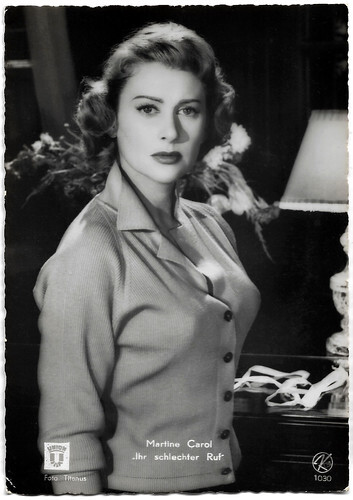
Austrian postcard by Kellner Fotokarten, Wien, no. 1030. Photo: Titanus / Union. Martine Carol in Difendo il mio amore/Defend My Love (Giulio Macchi, 1957).
Sex symbol Martine Carol (1920–1967) was one of the most beautiful women in French cinema. During the early 1950s, she was a top box office draw as an elegant blonde seductress. Her private life was filled with turmoil including a suicide attempt, drug abuse, a kidnapping, and mysterious death.
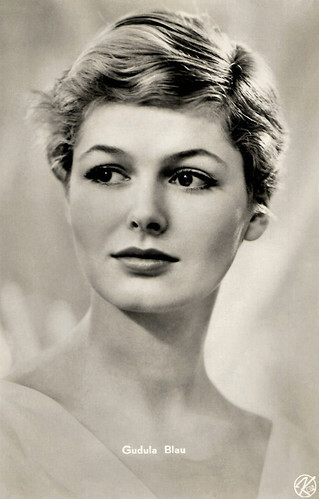
Austrian postcard by Kellner-Fotokarten, Wien, no. 81066.
Beautiful blonde Gudula Blau (1940) was a German actress who briefly appeared in German and Austrian entertainment films of the late 1950s. Later, she worked as an author, singer, and politician and incidentally played guest roles on television.
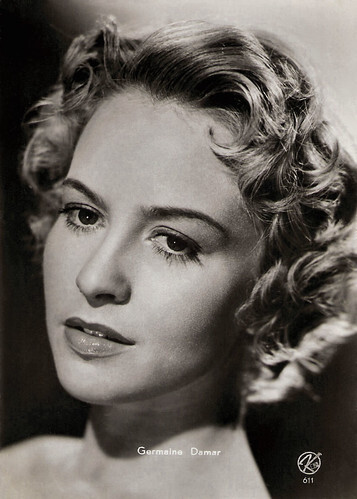
Austrian postcard by Kellner-Fotokarten, Wien, no. 611.
Luxembourg actress and dancer Germaine Damar (1929) started her career as an acrobat. She played in nearly 30 German films, including three films in which she was the partner of Peter Alexander.

Austrian postcard by Kellner Fotokarten, Wien, no. 81065. Photo: Paula Wessely Film / Hämmerer. Renate Holm in Wo die Lerche singt/Where the Lark Sings (Hans Wolff, 1956).
Renate Holm (1931-2022) is a German-Austrian film actress and operatic soprano. During the 1950s she was a popular star of Schlager films and operettas. In the 1960s, she became a star at the Vienna State Opera under the direction of Herbert von Karajan.
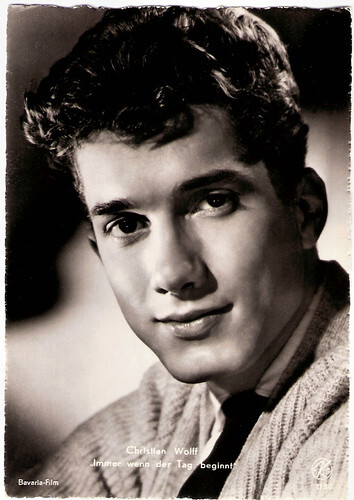
Austrian postcard by Kellner-Fotokarten, Wien, no. 81066. Photo: Bavaria-Film. Christian Wolff in Immer wenn der Tag beginnt/Always when the day starts (Wolfgang Liebeneiner, 1957).
Handsome Christian Wolff (1938) was a young lover of many German films of the late 1950s. He started out in the controversial 'gay' film Anders als Du und Ich/The Third Sex (1957) and later became a popular TV star in the long-running family series Forsthaus Falkenau (1989-2006).
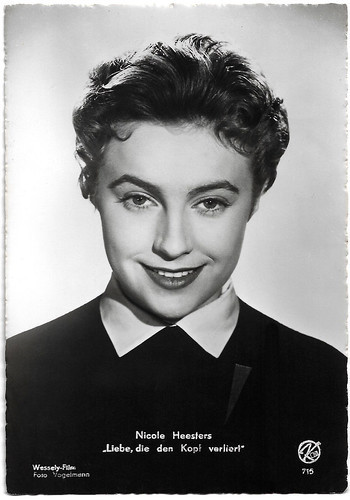
Austrian postcard by Kellner-Fotokarte, Wien, no. 715. Photo: Vogelmann / Wessely-Film. Nicole Heesters in Liebe, die den Kopf verliert/Love that loses its head (Thomas Engel, 1956).
Austrian actress Nicole Heesters (1937) is the daughter of Dutch-born film star Johannes Heesters. With a rich film and stage career, she stepped out of the shadow of her famous father. As a film actress, she became known in the 1950s for such films as Dieses Lied bleibt bei Dir/Cabaret (Willi Forst, 1954). Later she played in dozens of TV films and series.
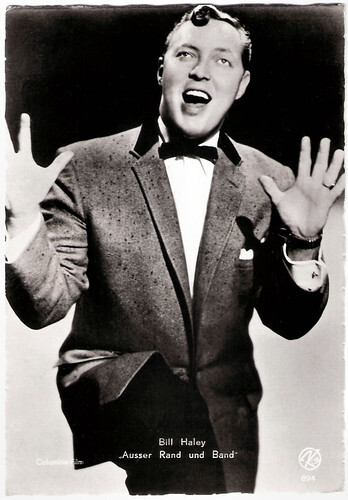
Austrian postcard by Kellner Fotokarten, Wien, no. 894. Photo: Columbia-Film. Bill Haley in Rock Around the Clock (Fred F. Sears, 1956).
Bill Haley & His Comets was an American rock and roll band that was founded in 1952 and continued until Haley's death in 1981. The band, also known by the names Bill Haley and the Comets and Bill Haley's Comets (and variations thereof), was the earliest group of white musicians to bring rock and roll to the attention of white America and the rest of the world.
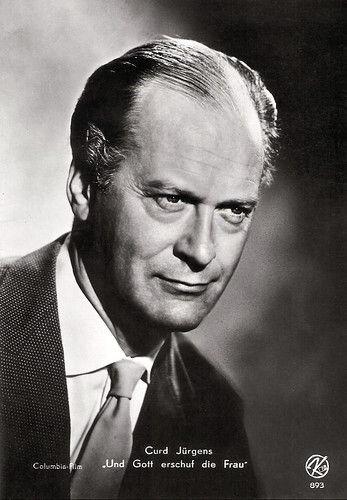
Austrian postcard by Kellner-Fotokarten, Wien (Vienna), no. 893. Photo: Columbia-Film. Curd Jürgens in Et Dieu... créa la femme/...And God Created Woman (Roger Vadim, 1956).
Tall, blonde, blue-eyed Curd Jürgens (1915-1982) played German soldiers in countless World War II films, usually billed as Curt Jurgens. Although the German-Austrian actor appeared in over 100 films, Jürgens considered himself primarily a stage actor. He also directed a few films with limited success and wrote screenplays.
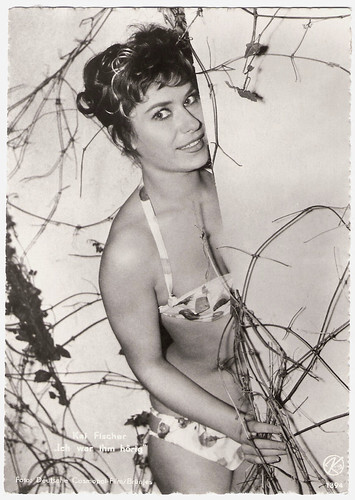
Austrian postcard by Kellner-Fotokarten, Wien, no. 1394. Photo: Deutsche Cosmopol-film / Brünjes. Kai Fischer in Ich war ihm hörig/I Was All His (Wolfgang Becker, 1958).
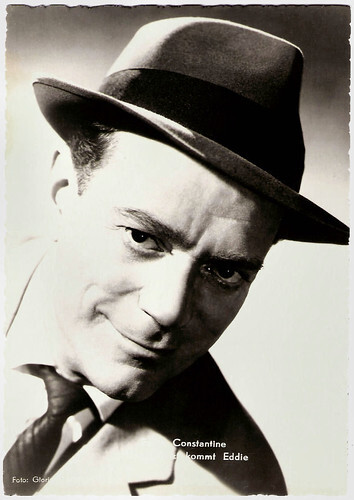
Austrian postcard by Kellner-Fotokarten, Wien, no. 82090. Photo: Gloria-Film / Wesel. Eddie Constantine in Hoppla, jetzt kommt Eddie/Hi, Here's Eddie (Werner Klingler, 1958).
Craggy-faced Eddie Constantine (1917-1993) was an American actor and singer who spent his career as a tough guy in European films. He became famous for a series of French B movies in which he played private eye Lemmy Caution, based on the hero of the detective novels by Peter Cheyney.
Sources: Wikipedia and Infobelpro.

Austrian postcard by Kellner-Fotokarten, Wien, no. 1038. Photo: Ringfilm. Jean Marais in Orphée/Orpheus (Jean Cocteau, 1950).
With his heroic physique, Jean Marais (1913-1998) was France’s answer to Errol Flynn, the epitome of the swashbuckling romantic hero of French cinema. The blonde and incredibly good-looking actor played over 100 roles in film and on television and was also known as a director, writer, painter and sculptor. His mentor was the legendary poet and director Jean Cocteau, who was also his lover.

Austrian postcard by Kellner-Fotokarten, Wien, no. 287.
Red-haired and spirited German actress Kai Fischer (1934) appeared in 54 films between 1955 and 2004. She was the naughty bad girl of the Wirtschaftwunder cinema, and also appeared in sexy roles in international productions, either as a prostitute or a gangster girl. Later she worked with famous directors such as Wim Wenders and Ingmar Bergman.

Austrian postcard by Kellner-Fotokarten, Wien, no. 1335. Photo: Bavaria / Schorcht / Ringpress / Vogelmann.
Toni Sailer (1935-2009) was a legendary Austrian alpine ski racer, one of the best the sport has ever produced. The ‘Black Blitz from Kitz’ appeared as an actor and singer in several films and TV series. He was a national hero and matinee idol rolled into one.

Austrian postcard by Kellner-Fotokarten, Wien, no. 1436. Photo: MGM. Mario Lanza in The Great Caruso (Richard Thorpe, 1951).
Mario Lanza (1921-1959) was an American tenor, actor and Hollywood film star of the late 1940s and the 1950s. His masterpiece was The Great Caruso (Richard Thorpe, 1951), the top-grossing film in the world in 1951. Lanza's voice was so dazzling that an awestruck Arturo Toscanini called it the "voice of the century".

Austrian postcard by Kellner-Fotokarten, Wien, no. 1311. Photo: Robert Hossein in Méfiez-vous, fillettes!/Good Girls Beware! (Yves Allégret, 1957).
French film actor, director and writer Robert Hossein (1927-2020) was generally cast as a tough guy beside such gorgeous actresses as Brigitte Bardot, Sophia Loren and Marina Vlady. He is most famous though as Michèle Mercier's husband in the wildly popular Angélique series of the 1960s.
Heimatfilme
In the aftermath of World War II, Austria's film production soon restarted, partially supported by the Allied Forces.
Austria's cities were devastated and filmmakers set their works in the countryside to show the population the "good and beautiful" Austria.
The Heimatfilm genre came to life and remained popular from the late 1940s to the early 1960s. The films suggested a whole, romantic world untouched by war and the hazards of real life. More than three hundred Heimatfilme were produced in Germany, Austria and Switzerland during the 1950s.
Heimatfilme were usually shot in the Alps, the Black Forest, or the Lüneburg Heath, and always involved the outdoors. Their characteristics were their rural settings, sentimental tone and simplistic morality, and they centred on love, friendship, family and non-urban life.
They also involved the difference between old and young, tradition and progress, and rural and urban life. The typical plot structure involved both a good and bad guy wanting a girl, conflict ensuing, and the good guy ultimately triumphing to win the girl, making all (except the bad guy) happy.

Austrian postcard by Kellner, no. 958. Photo: Neue Terra. Carlos Thompson in Zwischen Zeit und Ewigkeit/Between Time and Eternity (Arthur Maria Rabenalt, 1956).
Handsome Carlos Thompson (1923-1990) was an Argentinian heartthrob of German-Swiss parentage. He started his career in Argentina playing leading roles on stage and in films. In the 1950s, he went to Hollywood and was typically cast as a European womaniser opposite such stars as Lana Turner and Yvonne De Carlo. He moved to Europe and appeared in a large number of German-language films. In the late 1960s, Thompson left acting to become a writer and TV producer.

Austrian postcard by Kellner-Fotokarten, Wien, no. 1075 Ö. Photo: Rank Organisation. Michael Craig in House of Secrets (Guy Green, 1956).
British actor Michael Craig (1928) is known for his work in theatre, film and television both in the United Kingdom and Australia. He also worked as a scriptwriter, such as for The Angry Silence (1960). In Italy, Luchino Visconti directed him in Vaghe stelle dell'Orsa.../Sandra (1965).

Austrian postcard by Kellner-Fotokarten, Wien, no. 1464. Photo: CIFA / Prisma / FCC. O.W. Fischer in II bacio del sole/Don Vesuvio/The Kiss of the Sun (Siro Marcellini, 1958).
Austrian actor O.W. Fischer (1915–2004) was one of the most popular and highest-paid actors in German-language films in the 1950s. He played the lead in dozens of light romantic comedies and historical pieces. Unlike countrymen Curd Jürgens, Maria Schell and Romy Schneider, he never made it internationally.

Austrian postcard by Kellner-Fotokarten, Wien, no. 1544. Photo: CCC / Bavaria / Arthur Grimm. Folco Lulli in Polikuschka/Polikuska (Carmine Gallone, 1958).
Acclaimed Italian film actor Folco Lulli (1912–1970) appeared in 104 films between 1946 and 1970, mainly in strong character roles. He was very active in both Italian and French cinema. Now he is best known as one of the four nitro-glycerine truck drivers in Henri Georges Clouzot‘s classic nail-biter La Salaire de la Peur/The Wages of Fear (1953).

Austrian postcard by Kellner Postkarten, Wien (Vienna), no. 422. Photo: Jupiter-Film Ges.M.B.H. Bruce Low in Geld aus der Luft/Money from the air (Géza von Cziffra, 1954).
Bruce Low (1913-1990) was a Dutch Schlager and gospel singer and actor who had an impressive career in West Germany and Austria.
Imperial epics
During the age of the Wirtschaftswunder, there was little popular call in Austria for serious or critical films.
Veteran and new directors such as Ernst Marischka, Franz Antel, Geza von Cziffra, Geza von Bolvary and Walter Kolm-Veltee revised the comedy, provincial Heimatfilm, and biopic traditions, and began a new genre of the opulent imperial epic.
These imperial epics were set at the time of the Austro-Hungarian Empire as this period is identified with luxury, elegance, romance and a vision of Austria as large, powerful and peaceful. Extremely popular were Ernst Marischka's Sissi films starring Romy Schneider as Empress Elizabeth which found not only domestic but international success.
These films were the model for many other Austrian films of the period, such as Franz Antel's imperial-era musicals. The highly prolific Franz Antel became a household name with these films and with his popular comedies. These films rivalled Hollywood entertainment at the international box office.
Apart from Romy Schneider other Austrian film stars of the 1950s and rearly 1960s were Peter Alexander , Curd Jürgens , Hans Moser and ski champion Toni Sailer . The commercial Austrian film industry collapsed in the mid-1960s.

Austrian postcard by Kellner Fotokarten, Wien, no. 1030. Photo: Titanus / Union. Martine Carol in Difendo il mio amore/Defend My Love (Giulio Macchi, 1957).
Sex symbol Martine Carol (1920–1967) was one of the most beautiful women in French cinema. During the early 1950s, she was a top box office draw as an elegant blonde seductress. Her private life was filled with turmoil including a suicide attempt, drug abuse, a kidnapping, and mysterious death.

Austrian postcard by Kellner-Fotokarten, Wien, no. 81066.
Beautiful blonde Gudula Blau (1940) was a German actress who briefly appeared in German and Austrian entertainment films of the late 1950s. Later, she worked as an author, singer, and politician and incidentally played guest roles on television.

Austrian postcard by Kellner-Fotokarten, Wien, no. 611.
Luxembourg actress and dancer Germaine Damar (1929) started her career as an acrobat. She played in nearly 30 German films, including three films in which she was the partner of Peter Alexander.

Austrian postcard by Kellner Fotokarten, Wien, no. 81065. Photo: Paula Wessely Film / Hämmerer. Renate Holm in Wo die Lerche singt/Where the Lark Sings (Hans Wolff, 1956).
Renate Holm (1931-2022) is a German-Austrian film actress and operatic soprano. During the 1950s she was a popular star of Schlager films and operettas. In the 1960s, she became a star at the Vienna State Opera under the direction of Herbert von Karajan.

Austrian postcard by Kellner-Fotokarten, Wien, no. 81066. Photo: Bavaria-Film. Christian Wolff in Immer wenn der Tag beginnt/Always when the day starts (Wolfgang Liebeneiner, 1957).
Handsome Christian Wolff (1938) was a young lover of many German films of the late 1950s. He started out in the controversial 'gay' film Anders als Du und Ich/The Third Sex (1957) and later became a popular TV star in the long-running family series Forsthaus Falkenau (1989-2006).

Austrian postcard by Kellner-Fotokarte, Wien, no. 715. Photo: Vogelmann / Wessely-Film. Nicole Heesters in Liebe, die den Kopf verliert/Love that loses its head (Thomas Engel, 1956).
Austrian actress Nicole Heesters (1937) is the daughter of Dutch-born film star Johannes Heesters. With a rich film and stage career, she stepped out of the shadow of her famous father. As a film actress, she became known in the 1950s for such films as Dieses Lied bleibt bei Dir/Cabaret (Willi Forst, 1954). Later she played in dozens of TV films and series.

Austrian postcard by Kellner Fotokarten, Wien, no. 894. Photo: Columbia-Film. Bill Haley in Rock Around the Clock (Fred F. Sears, 1956).
Bill Haley & His Comets was an American rock and roll band that was founded in 1952 and continued until Haley's death in 1981. The band, also known by the names Bill Haley and the Comets and Bill Haley's Comets (and variations thereof), was the earliest group of white musicians to bring rock and roll to the attention of white America and the rest of the world.

Austrian postcard by Kellner-Fotokarten, Wien (Vienna), no. 893. Photo: Columbia-Film. Curd Jürgens in Et Dieu... créa la femme/...And God Created Woman (Roger Vadim, 1956).
Tall, blonde, blue-eyed Curd Jürgens (1915-1982) played German soldiers in countless World War II films, usually billed as Curt Jurgens. Although the German-Austrian actor appeared in over 100 films, Jürgens considered himself primarily a stage actor. He also directed a few films with limited success and wrote screenplays.

Austrian postcard by Kellner-Fotokarten, Wien, no. 1394. Photo: Deutsche Cosmopol-film / Brünjes. Kai Fischer in Ich war ihm hörig/I Was All His (Wolfgang Becker, 1958).

Austrian postcard by Kellner-Fotokarten, Wien, no. 82090. Photo: Gloria-Film / Wesel. Eddie Constantine in Hoppla, jetzt kommt Eddie/Hi, Here's Eddie (Werner Klingler, 1958).
Craggy-faced Eddie Constantine (1917-1993) was an American actor and singer who spent his career as a tough guy in European films. He became famous for a series of French B movies in which he played private eye Lemmy Caution, based on the hero of the detective novels by Peter Cheyney.
Sources: Wikipedia and Infobelpro.
Published on November 26, 2022 22:00
November 25, 2022
Herr Arnes pengar (1919)
The Swedish silent masterpiece Herr Arnes pengar/Sir Arne's Treasure (Mauritz Stiller, 1919) is a crime drama based on Selma Lagerlöf’s novel The Treasure. Set on the Swedish coast in the 16th century, the film stars Richard Lund as Sir Archie, a Scottish mercenary who has escaped from a Scottish prison and fled to Sweden.

Swedish postcard by Nordisk Konst, Stockholm, no. 1078/1. Photo: Richard Lund in Herr Arnes pengar/Sir Arne's Treasure (Mauritz Stiller, 1919).
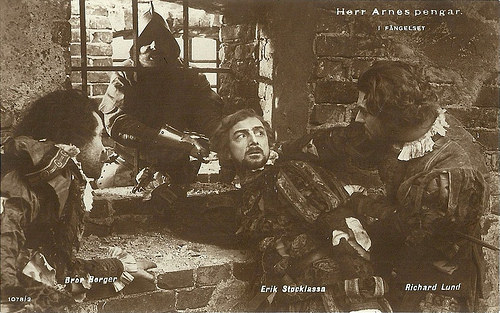
Swedish postcard by Nordisk Konst, Stockholm, no. 1078/2. Photo: Richard Lund , Bror Berger and Erik Stocklassa in Herr Arnes pengar/Sir Arne's Treasure (Mauritz Stiller, 1919). Caption: In Prison.
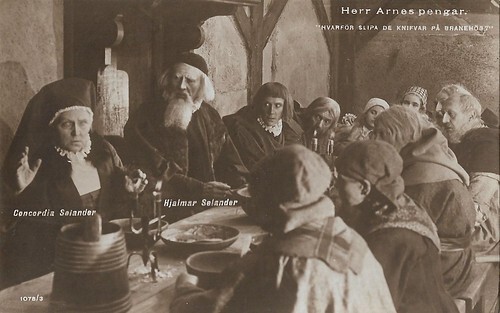
Swedish postcard by Nordisk Konst, Stockholm, no. 1078/3. Photo: Concordia Selander and Hjalmar Selander in Herr Arnes pengar/Sir Arne's Treasure (Mauritz Stiller, 1919). Caption: Why do they sharpen the knives on the Branehös?
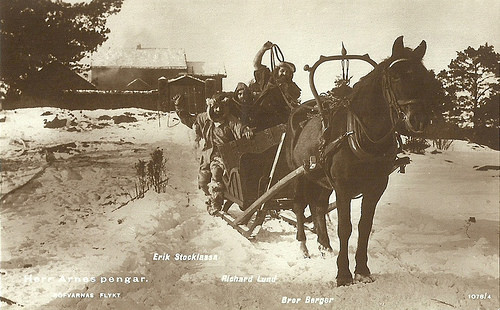
Swedish postcard by Nordisk Konst, Stockholm, no. 1078/4. Richard Lund , Bror Berger and Erik Stocklassa in Herr Arnes pengar/Sir Arne's Treasure (Mauritz Stiller, 1919). Caption: The Robbers' Escape.
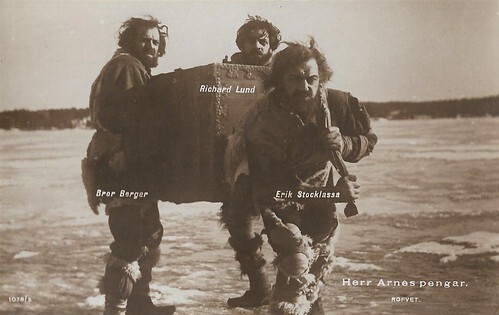
Swedish postcard by Nordisk Konst, Stockholm, no. 1078/5. Richard Lund , Bror Berger and Erik Stocklassa in Herr Arnes pengar/Sir Arne's Treasure (Mauritz Stiller, 1919). Caption: The Robbery.
Forces of nature can't be conquered
Swedish film and theatre actor Richard Lund (1885–1960) was a prolific star of early Scandinavian cinema. He worked for the two most important Swedish directors of the silent era, Victor Sjöström and Mauritz Stiller. The crime drama Herr Arnes pengar/Sir Arne's Treasure (1919) was directed by the latter. The film was produced by Svenska Biografteatern.
Richard Lund plays a Scottish mercenary who, together with his cronies Sir Donald (Bror Berger) and Sir Filip (Erik Stocklassa), has escaped from a Scottish prison and fled to Sweden.
There he murders the family of Sir Arne to obtain a treasure, after which he unknowingly starts an affair with the daughter of the murdered family, Elsalill ( Mary Johnson ).
Sir Arne’s Treasure still goes as one of if not the masterpiece of the Swedish silent cinema. Jerzy Toeplitz wrote in his Geschichte des Films (1972): “As with Sjöström, Nature plays a leading role in Stiller. Already in the first images, the snow creates the atmosphere of the action. In the tragic finale, the sea becomes a contributor. In the small port of Marstrand lies the ship that should return the Scots to their home. But it is wedged by ice floes. [...]
When the situation is strained to the utmost, because the forces of nature can't be conquered, in the city the news spreads that the criminals want to flee. In the battle with the town guards, Elsalill dies and Sir John Archie is captured. A long train of grey-clad women arrives at the ship to take off the corpse of Elsalill, after which the ice bursts and the occupied ship begins to move. Too late the silent, dangerous sea shows up.”

Swedish postcard by Nordisk Konst, Stockholm, no 1078/7. Richard Lund and Mary Johnson in Herr Arnes pengar/Sir Arne's Treasure (Mauritz Stiller, 1919). Caption: Elsallil, do you want to follow me to Scotland and become my wife?
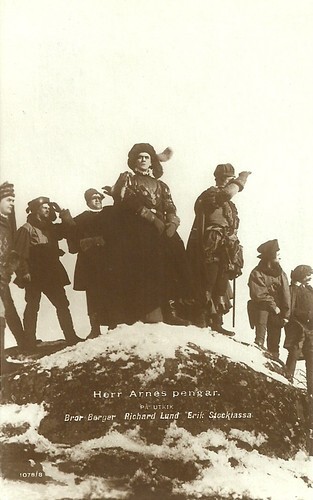
Swedish postcard by Nordisk Konst, Stockholm, no. 1078/8. Richard Lund , Bror Berger and Erik Stocklassa in Herr Arnes pengar/Sir Arne's Treasure (Mauritz Stiller, 1919). Caption: On the Lookout.
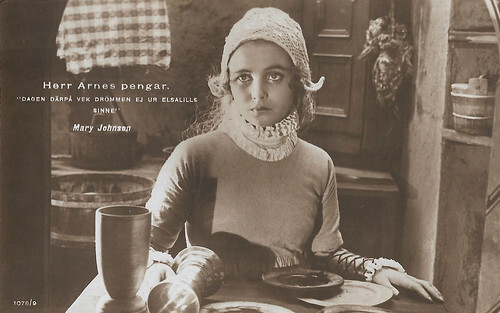
Swedish postcard by Nordisk Konst, Stockholm, no. 1078/9. Mary Johnson in Herr Arnes pengar/Sir Arne's Treasure (Mauritz Stiller, 1919). Caption: The next day the dream did not leave Elsalill's mind.
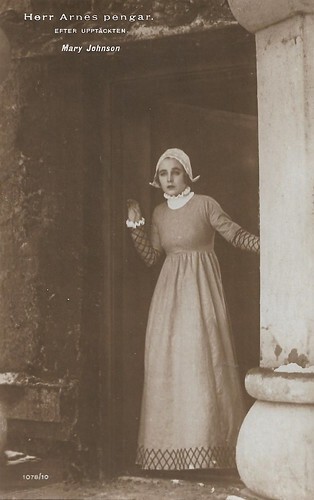
Swedish postcard by Nordisk Konst, Stockholm, no. 1078/10. Mary Johnson in Herr Arnes pengar/Sir Arne's Treasure (Mauritz Stiller, 1919). Caption: After the discovery.
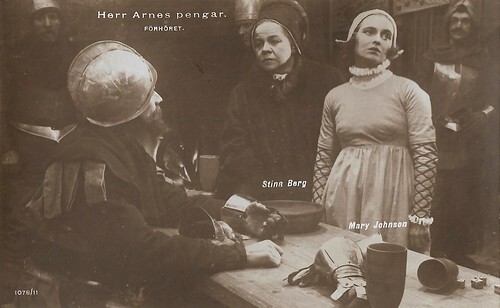
Swedish postcard by Nordisk Konst, Stockholm, no. 1078/11. Mary Johnson and Stina Berg in Herr Arnes pengar/Sir Arne's Treasure (Mauritz Stiller, 1919). Caption: The hearing.
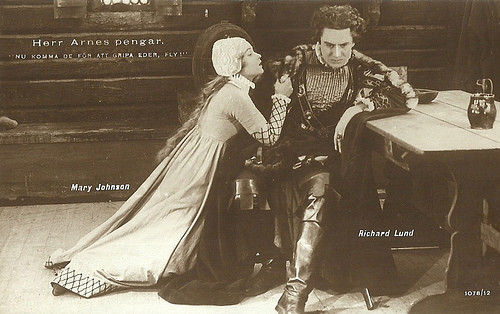
Swedish postcard by Nordisk Konst, Stockholm, no. 1078/12. Richard Lund and Mary Johnson in Herr Arnes pengar/Sir Arne's Treasure (Mauritz Stiller, 1919). Caption: They have come now to arrest you, escape!
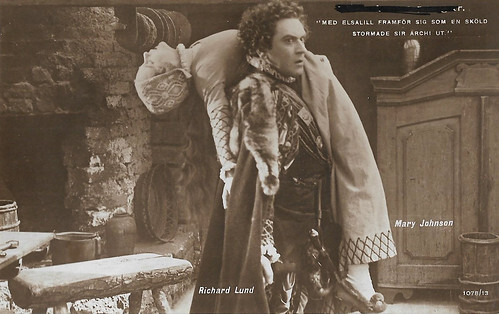
Swedish postcard by Nordisk Konst, Stockholm, no. 1078/13. Richard Lund and Mary Johnson in Herr Arnes pengar/Sir Arne's Treasure (Mauritz Stiller, 1919). Caption: With Elsallil before him like a shield, Sir Archi stormed out.
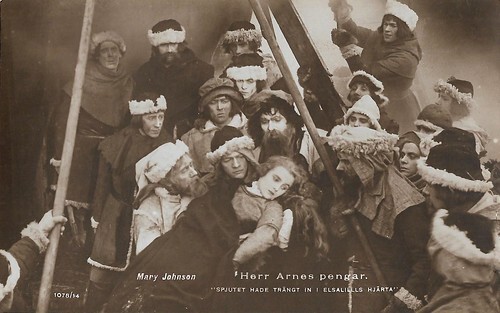
Swedish postcard by Nordisk Konst, Stockholm, no. 1078/14. Mary Johnson in Herr Arnes pengar/Sir Arne's Treasure (Mauritz Stiller, 1919). Caption: The spear had penetrated into Elsallil's heart.
Sources: Jerzy Toeplitz (Geschichte des Films - German), Wikipedia and IMDb.

Swedish postcard by Nordisk Konst, Stockholm, no. 1078/1. Photo: Richard Lund in Herr Arnes pengar/Sir Arne's Treasure (Mauritz Stiller, 1919).

Swedish postcard by Nordisk Konst, Stockholm, no. 1078/2. Photo: Richard Lund , Bror Berger and Erik Stocklassa in Herr Arnes pengar/Sir Arne's Treasure (Mauritz Stiller, 1919). Caption: In Prison.

Swedish postcard by Nordisk Konst, Stockholm, no. 1078/3. Photo: Concordia Selander and Hjalmar Selander in Herr Arnes pengar/Sir Arne's Treasure (Mauritz Stiller, 1919). Caption: Why do they sharpen the knives on the Branehös?

Swedish postcard by Nordisk Konst, Stockholm, no. 1078/4. Richard Lund , Bror Berger and Erik Stocklassa in Herr Arnes pengar/Sir Arne's Treasure (Mauritz Stiller, 1919). Caption: The Robbers' Escape.

Swedish postcard by Nordisk Konst, Stockholm, no. 1078/5. Richard Lund , Bror Berger and Erik Stocklassa in Herr Arnes pengar/Sir Arne's Treasure (Mauritz Stiller, 1919). Caption: The Robbery.
Forces of nature can't be conquered
Swedish film and theatre actor Richard Lund (1885–1960) was a prolific star of early Scandinavian cinema. He worked for the two most important Swedish directors of the silent era, Victor Sjöström and Mauritz Stiller. The crime drama Herr Arnes pengar/Sir Arne's Treasure (1919) was directed by the latter. The film was produced by Svenska Biografteatern.
Richard Lund plays a Scottish mercenary who, together with his cronies Sir Donald (Bror Berger) and Sir Filip (Erik Stocklassa), has escaped from a Scottish prison and fled to Sweden.
There he murders the family of Sir Arne to obtain a treasure, after which he unknowingly starts an affair with the daughter of the murdered family, Elsalill ( Mary Johnson ).
Sir Arne’s Treasure still goes as one of if not the masterpiece of the Swedish silent cinema. Jerzy Toeplitz wrote in his Geschichte des Films (1972): “As with Sjöström, Nature plays a leading role in Stiller. Already in the first images, the snow creates the atmosphere of the action. In the tragic finale, the sea becomes a contributor. In the small port of Marstrand lies the ship that should return the Scots to their home. But it is wedged by ice floes. [...]
When the situation is strained to the utmost, because the forces of nature can't be conquered, in the city the news spreads that the criminals want to flee. In the battle with the town guards, Elsalill dies and Sir John Archie is captured. A long train of grey-clad women arrives at the ship to take off the corpse of Elsalill, after which the ice bursts and the occupied ship begins to move. Too late the silent, dangerous sea shows up.”

Swedish postcard by Nordisk Konst, Stockholm, no 1078/7. Richard Lund and Mary Johnson in Herr Arnes pengar/Sir Arne's Treasure (Mauritz Stiller, 1919). Caption: Elsallil, do you want to follow me to Scotland and become my wife?

Swedish postcard by Nordisk Konst, Stockholm, no. 1078/8. Richard Lund , Bror Berger and Erik Stocklassa in Herr Arnes pengar/Sir Arne's Treasure (Mauritz Stiller, 1919). Caption: On the Lookout.

Swedish postcard by Nordisk Konst, Stockholm, no. 1078/9. Mary Johnson in Herr Arnes pengar/Sir Arne's Treasure (Mauritz Stiller, 1919). Caption: The next day the dream did not leave Elsalill's mind.

Swedish postcard by Nordisk Konst, Stockholm, no. 1078/10. Mary Johnson in Herr Arnes pengar/Sir Arne's Treasure (Mauritz Stiller, 1919). Caption: After the discovery.

Swedish postcard by Nordisk Konst, Stockholm, no. 1078/11. Mary Johnson and Stina Berg in Herr Arnes pengar/Sir Arne's Treasure (Mauritz Stiller, 1919). Caption: The hearing.

Swedish postcard by Nordisk Konst, Stockholm, no. 1078/12. Richard Lund and Mary Johnson in Herr Arnes pengar/Sir Arne's Treasure (Mauritz Stiller, 1919). Caption: They have come now to arrest you, escape!

Swedish postcard by Nordisk Konst, Stockholm, no. 1078/13. Richard Lund and Mary Johnson in Herr Arnes pengar/Sir Arne's Treasure (Mauritz Stiller, 1919). Caption: With Elsallil before him like a shield, Sir Archi stormed out.

Swedish postcard by Nordisk Konst, Stockholm, no. 1078/14. Mary Johnson in Herr Arnes pengar/Sir Arne's Treasure (Mauritz Stiller, 1919). Caption: The spear had penetrated into Elsallil's heart.
Sources: Jerzy Toeplitz (Geschichte des Films - German), Wikipedia and IMDb.
Published on November 25, 2022 22:00
November 24, 2022
Margaret Sullavan
Margaret Sullavan (1909-1960) was an American stage and film actress. She made her Broadway debut in 1931 and later returned to Broadway stages again and again. Sullavan is best remembered opposite James Stewart in Ernst Lubitsch's The Shop Around the Corner (1940).
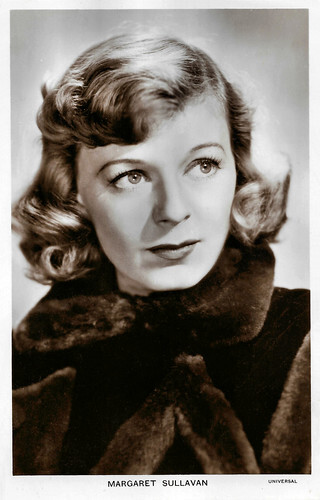
British postcard in the Picturegoer Series, London, no. W 10. Photo: Universal.
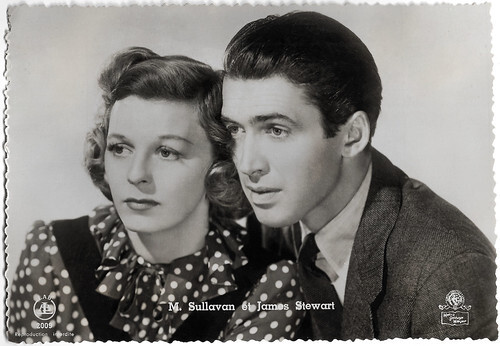
Belgian postcard by Les Editions d'Art L.A.B., Bruxelles, no. 2009. Photo: Metro-Goldwyn-Mayer. Margaret Sullavan and James Stewart in The Shop Around the Corner (Ernst Lubitsch, 1940). The French title was Rendez-vous.
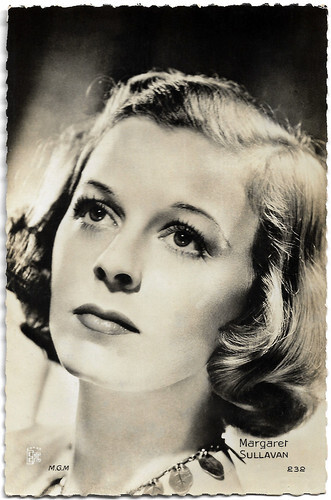
French postcard by EPC, no. 232. Photo: M.G.M.
A relationship behind the scenes
Margaret Brooke Sullavan Hancock was born in 1909 in Norfolk in the US state of Virginia. She was the daughter of the broker Cornelius Sullavan and his wife Garland Brooke. During her childhood, she attended several public schools. She graduated from Chatham Episcopal Institute in 1927. After this, she moved to Boston, where she moved into her sister's flat. Even as a child, Sullavan was a member of the theatre and danced in her spare time.
In the summer of 1928, she joined the local theatre University Players at Harvard. The owner of that theatre personally invited her to work for him after seeing her apprentice at the Copely Theatre. Her theatre debut followed in 1929 when she got a role in the touring play 'Strictly Dishonorable'. During these years, she met actor Henry Fonda, who was himself a member of University Players. They reportedly began a relationship behind the scenes back in 1929. They eventually married in 1931, but the marriage did not last long.
After only two months, a divorce was filed. In 1931, Sullavan had an interview with Lee Schubert, who was then preparing a play to be performed on Broadway. Although she had the flu during the interview, she got a role in his play 'A Modern Virgin', which ran in 1931 with a total of 53 performances. Sullavan soon began appearing in several plays on Broadway. After roles in 'If Love Were All', 'Happy Landing', 'Chrysalis' and 'Bad Manners', she replaced Marguerite Churchill in 'Dinner at Eight' in 1932.
It was not long before she was noticed by Hollywood producers. When she was offered the lead role in Only Yesterday (John M. Stahl, 1933), Sullivan decided to move west of the country. She signed a film contract with the film studio Universal Pictures, where she received $1,200 weekly for a period of three years. She arrived in Hollywood in 1933, on her twenty-fourth birthday. That same year, she was seen on the big screen in Only Yesterday. The film immediately made Sullavan a star.
Early on in her film career, she and Katharine Hepburn were considered rivals. This was mainly because they had a lot in common. In addition, Sullavan would regularly seduce friends of Hepburn, including Humphrey Bogart and James Stewart. She had a relationship with Stewart from 1932 to 1933. However, the only real serious relationship during this period was with director William Wyler. They got engaged and said yes to each other on 25 November 1934. The following year, she was featured in his film The Good Fairy. However, the marriage did not last long and the divorce was finalised in 1936.
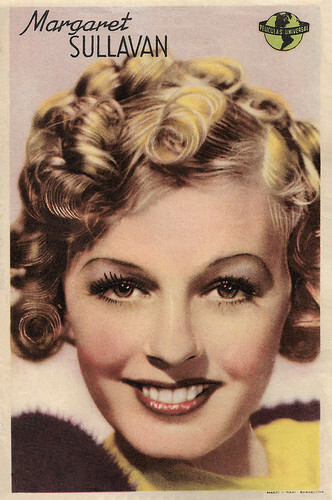
Spanish collectors card by Marti y Mary, Barcelona. Photo: Universal.
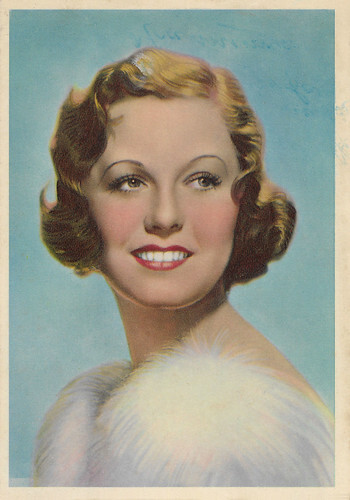
British postcard by Abdulla Cigarettes, no. 24. Photo: Universal.
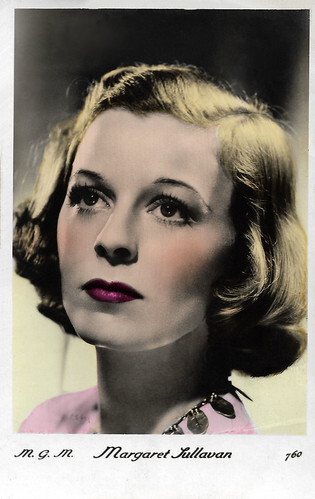
French postcard, no. 760. Photo: M.G.M.
A daring effort by the studio
In 1936, Margaret Sullavan starred in a film alongside James Stewart for the first time, Next Time We Love (Edward H. Griffith, 1936). This was the last film she made for Universal Pictures. Her contract was terminated and Sullavan briefly decided to return to theatre. She made 169 appearances in the Broadway play 'Stage Door' between October 1936 and March 1937, but the 1937 film version starred her old rival, Katharine Hepburn.
After this, she decided to return to the film industry. She got a contract with the Metro-Goldwyn-Mayer film studio. The first film she made for the studio was Three Comrades (Frank Borzage, 1938) alongside Robert Taylor. The film was a daring effort by the studio, as the Nazis were very powerful at the time and the film portrayed them in a negative light. However, it proved a great success and Sullavan was nominated for her first and only Academy Award for Best Actress.
Although she lost this one to Bette Davis for her role in Jezebel (1938), Sullavan became an international star. Thus, she was chosen as one of the audience favourites for the role of Scarlett O'Hara in the upcoming film Gone with the Wind. She was one of the first actresses considered for the role but was never a serious contender.
Sullavan married for the third time in 1936, this time to the powerful agent and producer Leland Hayward. In 1937, she gave birth to her first daughter, Brooke Hayward. The couple had two more children after this: daughter Bridget in 1939 and son William Bill in 1942. Sullavan was determined to give her children as normal a childhood as possible. Although she remained active in filmmaking herself during their childhood, she shielded her children from Hollywood.
Sullavan also starred again alongside James Stewart in The Shopworn Angel (H.C. Potter, 1938). In it, she played a spoilt and alcoholic actress who falls for the charms of an everyday citizen. Although Sullivan's voice had been praised since the beginning of her career, her musical numbers were dubbed by singer Mary Martin. She was not much later personally asked by actress Joan Crawford to be her counterpart in her upcoming film The Shining Hour (Frank Borzage, 1938). Although the film crew advised Crawford against offering Sullavan the role for fear she would overshadow her, she was determined to work with her.
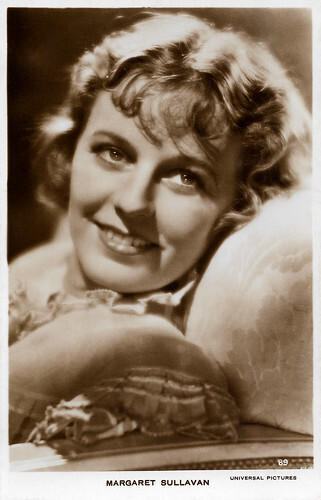
British Real Photograph postcard, no. 89. Photo: Universal Pictures.
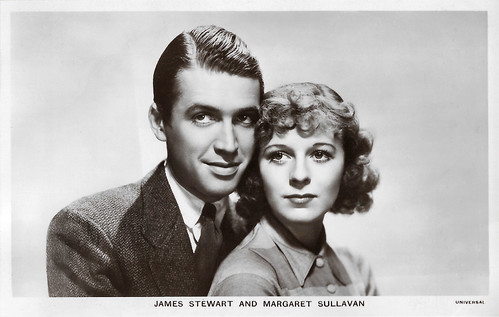
British postcard in the Film Partners Series, London, no. P 199. Photo: Universal. James Stewart and Margaret Sullavan in Next Time We Love (Edward H. Griffith, 1936).
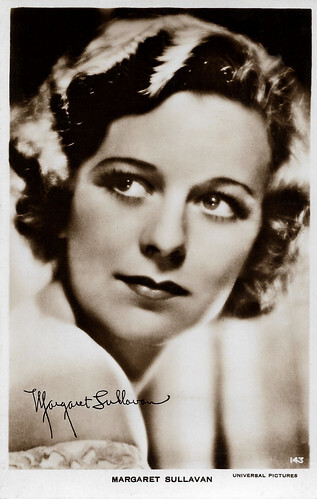
British postcard in the Filmkurier Series, London, no. 143. Photo: Universal Pictures.
Disowned by her children
After her role in The Shining Hour, Margaret Sullavan was again cast opposite James Stewart in The Shop Around the Corner (Ernst Lubitsch, 1940). In it, she played Klara Novak, the role for which she is probably best remembered. Although the film became a huge success, it went unnoticed at the Oscars.
Not much later, she again starred alongside Stewart in The Mortal Storm (Frank Borzage, 1940). After this, her contract with MGM was broken. Sullavan attempted a freelance career but was unable to find work after a role in Cry 'Havoc' (Richard Thorpe, 1943).
Her private life was not going according to plan either. Her daughter Brooke and son Will both had mental problems and had to be placed in an institution. When her marriage to Hayward also fell apart, Sullavan became depressed. They divorced in 1947 and Sullavan moved several times after this.
She achieved a few more successes in the theatre. For instance, she performed in the play 'The Voice of the Turtle' from 1943 to 1948. However, her personal problems affected her career. Critics spoke increasingly negatively about her acting skills. In 1950, Sullavan made her last film appearance in No Sad Songs for Me (Rudolph Maté, 1950). Between 1952 and 1956, she appeared in the plays 'The Deep Blue Sea', 'Sabrina Fair' and 'Janus', after which she decided to retire.
Her depression worsened. She was disowned by her children Bridget and Bill. After retirement, she only spoke negatively about her experiences with Hollywood and blamed her film career for, in her own words, failing her as a mother. In addition, she developed otosclerosis, which resulted in her becoming hard of hearing. She was found dead in her flat on 1 January 1960. It was later found that she had committed suicide via an overdose of barbiturates.
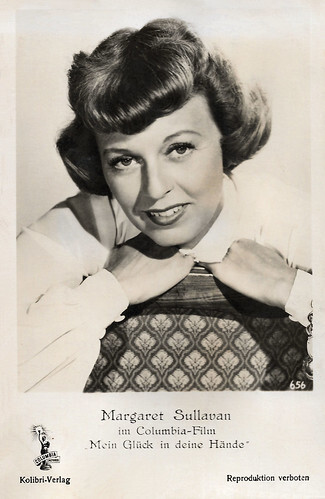
West-German postcard by Kolibri-Verlag, no. 656. Photo: Columbia. Margaret Sullavan in No Sad Songs for Me (Rudolph Maté, 1950).
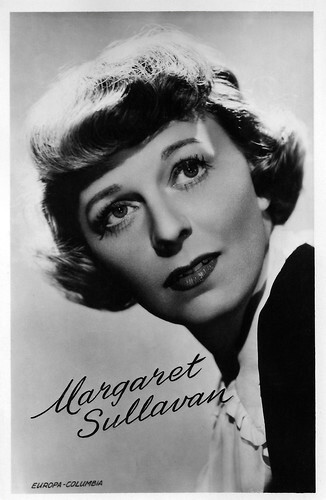
Dutch postcard, no. A.X. 314. Photo: Europa - Columbia.
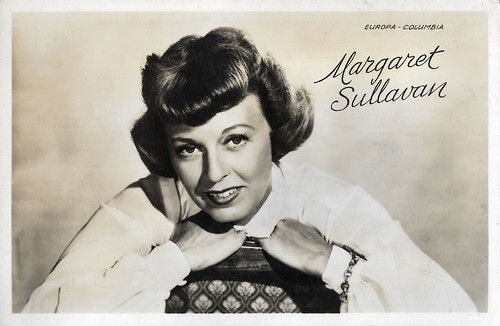
Belgian postcard, no. 3328. Photo: Europa-Columbia.
Source: Wikipedia (Dutch and German) and .

British postcard in the Picturegoer Series, London, no. W 10. Photo: Universal.

Belgian postcard by Les Editions d'Art L.A.B., Bruxelles, no. 2009. Photo: Metro-Goldwyn-Mayer. Margaret Sullavan and James Stewart in The Shop Around the Corner (Ernst Lubitsch, 1940). The French title was Rendez-vous.

French postcard by EPC, no. 232. Photo: M.G.M.
A relationship behind the scenes
Margaret Brooke Sullavan Hancock was born in 1909 in Norfolk in the US state of Virginia. She was the daughter of the broker Cornelius Sullavan and his wife Garland Brooke. During her childhood, she attended several public schools. She graduated from Chatham Episcopal Institute in 1927. After this, she moved to Boston, where she moved into her sister's flat. Even as a child, Sullavan was a member of the theatre and danced in her spare time.
In the summer of 1928, she joined the local theatre University Players at Harvard. The owner of that theatre personally invited her to work for him after seeing her apprentice at the Copely Theatre. Her theatre debut followed in 1929 when she got a role in the touring play 'Strictly Dishonorable'. During these years, she met actor Henry Fonda, who was himself a member of University Players. They reportedly began a relationship behind the scenes back in 1929. They eventually married in 1931, but the marriage did not last long.
After only two months, a divorce was filed. In 1931, Sullavan had an interview with Lee Schubert, who was then preparing a play to be performed on Broadway. Although she had the flu during the interview, she got a role in his play 'A Modern Virgin', which ran in 1931 with a total of 53 performances. Sullavan soon began appearing in several plays on Broadway. After roles in 'If Love Were All', 'Happy Landing', 'Chrysalis' and 'Bad Manners', she replaced Marguerite Churchill in 'Dinner at Eight' in 1932.
It was not long before she was noticed by Hollywood producers. When she was offered the lead role in Only Yesterday (John M. Stahl, 1933), Sullivan decided to move west of the country. She signed a film contract with the film studio Universal Pictures, where she received $1,200 weekly for a period of three years. She arrived in Hollywood in 1933, on her twenty-fourth birthday. That same year, she was seen on the big screen in Only Yesterday. The film immediately made Sullavan a star.
Early on in her film career, she and Katharine Hepburn were considered rivals. This was mainly because they had a lot in common. In addition, Sullavan would regularly seduce friends of Hepburn, including Humphrey Bogart and James Stewart. She had a relationship with Stewart from 1932 to 1933. However, the only real serious relationship during this period was with director William Wyler. They got engaged and said yes to each other on 25 November 1934. The following year, she was featured in his film The Good Fairy. However, the marriage did not last long and the divorce was finalised in 1936.

Spanish collectors card by Marti y Mary, Barcelona. Photo: Universal.

British postcard by Abdulla Cigarettes, no. 24. Photo: Universal.

French postcard, no. 760. Photo: M.G.M.
A daring effort by the studio
In 1936, Margaret Sullavan starred in a film alongside James Stewart for the first time, Next Time We Love (Edward H. Griffith, 1936). This was the last film she made for Universal Pictures. Her contract was terminated and Sullavan briefly decided to return to theatre. She made 169 appearances in the Broadway play 'Stage Door' between October 1936 and March 1937, but the 1937 film version starred her old rival, Katharine Hepburn.
After this, she decided to return to the film industry. She got a contract with the Metro-Goldwyn-Mayer film studio. The first film she made for the studio was Three Comrades (Frank Borzage, 1938) alongside Robert Taylor. The film was a daring effort by the studio, as the Nazis were very powerful at the time and the film portrayed them in a negative light. However, it proved a great success and Sullavan was nominated for her first and only Academy Award for Best Actress.
Although she lost this one to Bette Davis for her role in Jezebel (1938), Sullavan became an international star. Thus, she was chosen as one of the audience favourites for the role of Scarlett O'Hara in the upcoming film Gone with the Wind. She was one of the first actresses considered for the role but was never a serious contender.
Sullavan married for the third time in 1936, this time to the powerful agent and producer Leland Hayward. In 1937, she gave birth to her first daughter, Brooke Hayward. The couple had two more children after this: daughter Bridget in 1939 and son William Bill in 1942. Sullavan was determined to give her children as normal a childhood as possible. Although she remained active in filmmaking herself during their childhood, she shielded her children from Hollywood.
Sullavan also starred again alongside James Stewart in The Shopworn Angel (H.C. Potter, 1938). In it, she played a spoilt and alcoholic actress who falls for the charms of an everyday citizen. Although Sullivan's voice had been praised since the beginning of her career, her musical numbers were dubbed by singer Mary Martin. She was not much later personally asked by actress Joan Crawford to be her counterpart in her upcoming film The Shining Hour (Frank Borzage, 1938). Although the film crew advised Crawford against offering Sullavan the role for fear she would overshadow her, she was determined to work with her.

British Real Photograph postcard, no. 89. Photo: Universal Pictures.

British postcard in the Film Partners Series, London, no. P 199. Photo: Universal. James Stewart and Margaret Sullavan in Next Time We Love (Edward H. Griffith, 1936).

British postcard in the Filmkurier Series, London, no. 143. Photo: Universal Pictures.
Disowned by her children
After her role in The Shining Hour, Margaret Sullavan was again cast opposite James Stewart in The Shop Around the Corner (Ernst Lubitsch, 1940). In it, she played Klara Novak, the role for which she is probably best remembered. Although the film became a huge success, it went unnoticed at the Oscars.
Not much later, she again starred alongside Stewart in The Mortal Storm (Frank Borzage, 1940). After this, her contract with MGM was broken. Sullavan attempted a freelance career but was unable to find work after a role in Cry 'Havoc' (Richard Thorpe, 1943).
Her private life was not going according to plan either. Her daughter Brooke and son Will both had mental problems and had to be placed in an institution. When her marriage to Hayward also fell apart, Sullavan became depressed. They divorced in 1947 and Sullavan moved several times after this.
She achieved a few more successes in the theatre. For instance, she performed in the play 'The Voice of the Turtle' from 1943 to 1948. However, her personal problems affected her career. Critics spoke increasingly negatively about her acting skills. In 1950, Sullavan made her last film appearance in No Sad Songs for Me (Rudolph Maté, 1950). Between 1952 and 1956, she appeared in the plays 'The Deep Blue Sea', 'Sabrina Fair' and 'Janus', after which she decided to retire.
Her depression worsened. She was disowned by her children Bridget and Bill. After retirement, she only spoke negatively about her experiences with Hollywood and blamed her film career for, in her own words, failing her as a mother. In addition, she developed otosclerosis, which resulted in her becoming hard of hearing. She was found dead in her flat on 1 January 1960. It was later found that she had committed suicide via an overdose of barbiturates.

West-German postcard by Kolibri-Verlag, no. 656. Photo: Columbia. Margaret Sullavan in No Sad Songs for Me (Rudolph Maté, 1950).

Dutch postcard, no. A.X. 314. Photo: Europa - Columbia.

Belgian postcard, no. 3328. Photo: Europa-Columbia.
Source: Wikipedia (Dutch and German) and .
Published on November 24, 2022 22:00
November 23, 2022
Fee Malten
Pretty Fee Malten (1911-2005) was a popular German film star in the late 1920s and early 1930s. She portrayed uncomplicated, gay girls in several silent and early sound films until her budding career was broken off by the rise of Adolph Hitler.

German postcard by Ross Verlag, no. 3463/1, 1928-1929. Photo: Atelier Kiesel, Berlin.

German postcard by Ross Verlag, no. 3870/1, 1928-1929. Photo: Jacobi, Berlin / Eichberg-Film.
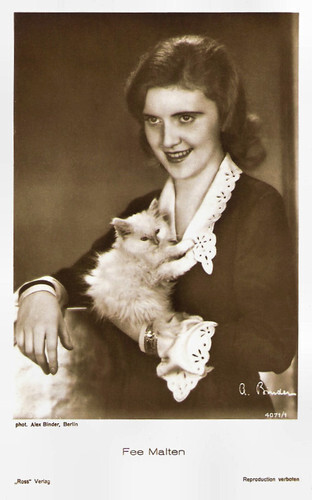
German postcard by Ross Verlag, no. 4071/1, 1929-1930. Photo: Alex Binder.
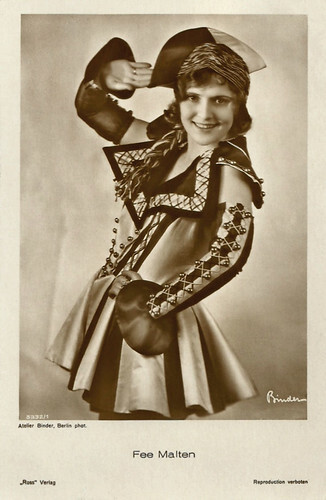
German postcard by Ross Verlag, no. 5332/1, 1930-1931. Photo: Atelier Binder, Berlin.
Uncomplicated, cheerful girl
Fee Malten was born as Felicitas Mansch in Berlin, Germany in 1911.
At the age of 9, she made her film debut. She was introduced by an uncle who worked as an actor. In Christi Geburt/Christ's birth (1920) she did a little dance performance. For the following years, she concentrated on her ballet and piano studies.
In 1927 she returned to the cinema in Am Rande der Welt/At the Edge of the World (Karl Grune, 1927) and the supernatural thriller Der geheimnisvolle Spiegel/The Mystic Mirror (Carl Hoffmann, Richard Teschner, 1928), credited as Felicitas Malten.
In the following years, she made some more silent films, now as Fee Malten, like Rutschbahn/Whirl of Youth (Richard Eichberg, 1928) with Heinrich George , and Tagebuch einer Kokotte/Diary of a Coquette (Constantin J. David, 1928). She was often cast as an uncomplicated, cheerful girl in those films.
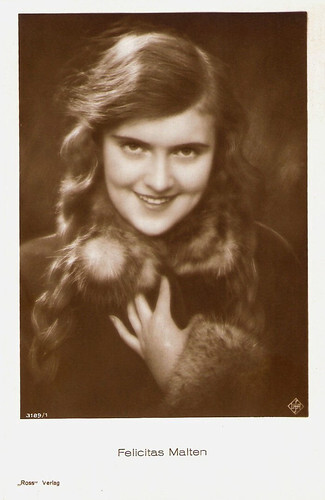
German postcard by Ross Verlag, no. 3189/1, 1928-1929. Photo: Ufa.
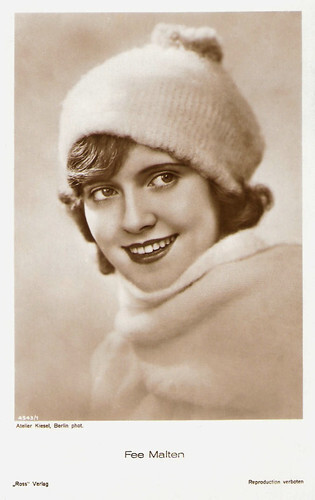
German postcard by Ross Verlag, no. 4543/1, 1929-1930. Photo: Atelier Kiesel, Berlin.
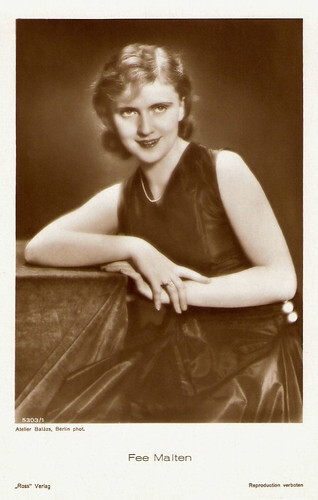
German postcard by Ross Verlag, no. 5303/1, 1930-1931. Photo: Atelier Balázs, Berlin.
The Rise of the Nazis
Fee Malten’s film career seemed to bloom after the arrival of the sound film. In the early 1930s, she played leading roles in several films.
In the popular operetta Ein Tango für Dich/A Tango For You (Géza Von Bolvary, 1930), she was a dancer, loved by two jazz singers, played by Paul Otto and Willi Forst .
Hal Erickson at AllMovie : "When all is said and done, however, the plots never really mattered in these early-talkie operettas; if there were plenty of singers and dancers and plenty of songs and dance, the audience went home happy. American critics seemed delighted that director Géza Von Bolvary emulated Hollywood filmmaking techniques while putting together Ein Tango fuer Dich."
The following year she made another operetta with the same actors and director, Sein Leibeslied/His Love Song (Géza Von Bolvary, 1931). Among her other films were the comedy Die schwebende Jungfrau/The Gliding Virgin (Carl Boese, 1931), the thriller D-Zug 13 hat Verspätung/Express 13 (Alfred Zeisler, 1931), and the military comedy Falscher Feldmarschall/False Field Marshall (Karel Lamac aka Carl Lamac, 1932).
Then her career was halted by the rise of the Nazis. The Jewish Malten wasn’t allowed to appear in more films in Germany.
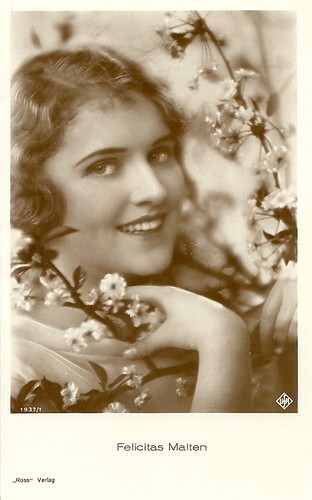
German postcard by Ross Verlag, Berlin, no. 1937/1, 1927-1928. Photo: Ufa.
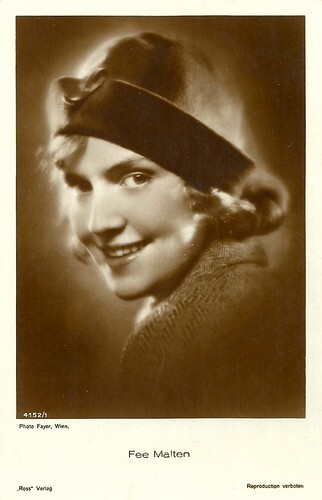
German postcard by Ross Verlag, Berlin, no. 4152/1, 1929-1930. Photo: Fayer, Vienna.
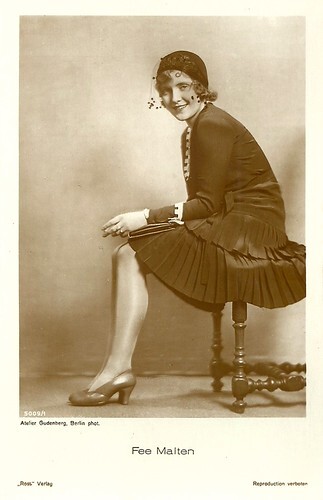
German postcard by Ross Verlag, Berlin, no. 5009/1, 1930-1931. Photo: Atelier Gudenberg, Berlin.
Monogram quickie
In 1937, talent agent Paul Kohner invited Fee Malten to come to Hollywood. She moved to the United States with her husband, Hans Wall, and their two children.
There she appeared in a few films, including in the Monogram quickie Foreign Agent (William Beaudine, 1942) and - as Fay Wall - in Hitler - Dead or Alive (Nick Grinde, 1942).
Reviewer Donnie Lee writes on IMDb about the latter film: "To everyone who tells me that Plan 9 From Outer Space was the worst film ever made, I simply reply: "You haven't seen Hitler: Dead or Alive. Watch it for laughs!"
Fee Malten or Fay Wall would never rise above supporting parts in Hollywood. Her last bit was in Young Bess (George Sidney, 1953). She died in 2005, in Los Angeles, USA. She was 94.
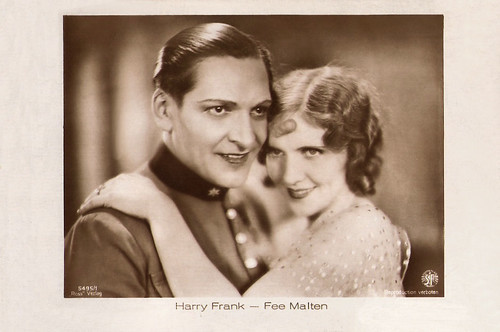
German postcard by Ross Verlag, no. 5495/1, 1930-1931. Photo: Süd-Film. Harry Frank and Fee Malten in Der falsche Feldmarschall/The Fake Field Marshal (Karel Lamac, 1930).
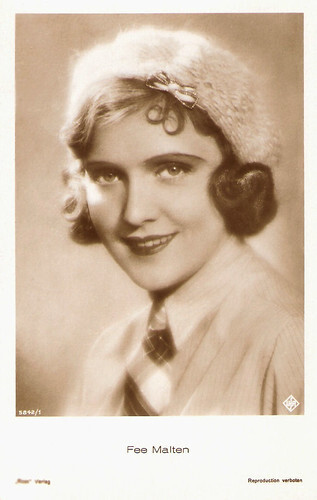
German postcard by Ross Verlag, no. 5842/1, 1930-1931. Photo: Ufa.
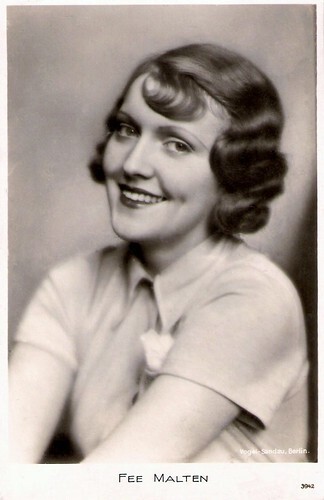
Vintage postcard, no. 3942. Photo: Vogel-Sandau, Berlin.
Sources: Hal Erickson (AllMovie), Thomas Staedeli (Cyranos), Donnie Lee (IMDb), AllMovie, Wikipedia (German) and .

German postcard by Ross Verlag, no. 3463/1, 1928-1929. Photo: Atelier Kiesel, Berlin.

German postcard by Ross Verlag, no. 3870/1, 1928-1929. Photo: Jacobi, Berlin / Eichberg-Film.

German postcard by Ross Verlag, no. 4071/1, 1929-1930. Photo: Alex Binder.

German postcard by Ross Verlag, no. 5332/1, 1930-1931. Photo: Atelier Binder, Berlin.
Uncomplicated, cheerful girl
Fee Malten was born as Felicitas Mansch in Berlin, Germany in 1911.
At the age of 9, she made her film debut. She was introduced by an uncle who worked as an actor. In Christi Geburt/Christ's birth (1920) she did a little dance performance. For the following years, she concentrated on her ballet and piano studies.
In 1927 she returned to the cinema in Am Rande der Welt/At the Edge of the World (Karl Grune, 1927) and the supernatural thriller Der geheimnisvolle Spiegel/The Mystic Mirror (Carl Hoffmann, Richard Teschner, 1928), credited as Felicitas Malten.
In the following years, she made some more silent films, now as Fee Malten, like Rutschbahn/Whirl of Youth (Richard Eichberg, 1928) with Heinrich George , and Tagebuch einer Kokotte/Diary of a Coquette (Constantin J. David, 1928). She was often cast as an uncomplicated, cheerful girl in those films.

German postcard by Ross Verlag, no. 3189/1, 1928-1929. Photo: Ufa.

German postcard by Ross Verlag, no. 4543/1, 1929-1930. Photo: Atelier Kiesel, Berlin.

German postcard by Ross Verlag, no. 5303/1, 1930-1931. Photo: Atelier Balázs, Berlin.
The Rise of the Nazis
Fee Malten’s film career seemed to bloom after the arrival of the sound film. In the early 1930s, she played leading roles in several films.
In the popular operetta Ein Tango für Dich/A Tango For You (Géza Von Bolvary, 1930), she was a dancer, loved by two jazz singers, played by Paul Otto and Willi Forst .
Hal Erickson at AllMovie : "When all is said and done, however, the plots never really mattered in these early-talkie operettas; if there were plenty of singers and dancers and plenty of songs and dance, the audience went home happy. American critics seemed delighted that director Géza Von Bolvary emulated Hollywood filmmaking techniques while putting together Ein Tango fuer Dich."
The following year she made another operetta with the same actors and director, Sein Leibeslied/His Love Song (Géza Von Bolvary, 1931). Among her other films were the comedy Die schwebende Jungfrau/The Gliding Virgin (Carl Boese, 1931), the thriller D-Zug 13 hat Verspätung/Express 13 (Alfred Zeisler, 1931), and the military comedy Falscher Feldmarschall/False Field Marshall (Karel Lamac aka Carl Lamac, 1932).
Then her career was halted by the rise of the Nazis. The Jewish Malten wasn’t allowed to appear in more films in Germany.

German postcard by Ross Verlag, Berlin, no. 1937/1, 1927-1928. Photo: Ufa.

German postcard by Ross Verlag, Berlin, no. 4152/1, 1929-1930. Photo: Fayer, Vienna.

German postcard by Ross Verlag, Berlin, no. 5009/1, 1930-1931. Photo: Atelier Gudenberg, Berlin.
Monogram quickie
In 1937, talent agent Paul Kohner invited Fee Malten to come to Hollywood. She moved to the United States with her husband, Hans Wall, and their two children.
There she appeared in a few films, including in the Monogram quickie Foreign Agent (William Beaudine, 1942) and - as Fay Wall - in Hitler - Dead or Alive (Nick Grinde, 1942).
Reviewer Donnie Lee writes on IMDb about the latter film: "To everyone who tells me that Plan 9 From Outer Space was the worst film ever made, I simply reply: "You haven't seen Hitler: Dead or Alive. Watch it for laughs!"
Fee Malten or Fay Wall would never rise above supporting parts in Hollywood. Her last bit was in Young Bess (George Sidney, 1953). She died in 2005, in Los Angeles, USA. She was 94.

German postcard by Ross Verlag, no. 5495/1, 1930-1931. Photo: Süd-Film. Harry Frank and Fee Malten in Der falsche Feldmarschall/The Fake Field Marshal (Karel Lamac, 1930).

German postcard by Ross Verlag, no. 5842/1, 1930-1931. Photo: Ufa.

Vintage postcard, no. 3942. Photo: Vogel-Sandau, Berlin.
Sources: Hal Erickson (AllMovie), Thomas Staedeli (Cyranos), Donnie Lee (IMDb), AllMovie, Wikipedia (German) and .
Published on November 23, 2022 22:00
November 22, 2022
Olive Borden
Stunning Olive Borden (1906-1947) was considered one of the most beautiful actresses of the silent era. At 15, she started as a Mack Sennett bathing beauty and reached the peak of her career in 1926 when she made 11 films for Fox Studios and was earning $1,500 a week. She was nicknamed 'the Joy Girl', after playing the lead in the 1927 film of that same title, but soon her career waned.
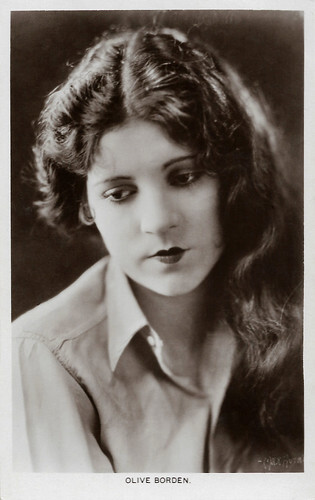
British postcard in the Picturegoer Series, London, no. 296. Photo: Max Munn Autrey.
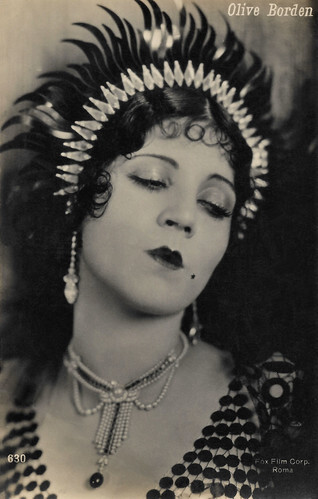
Italian postcard by Casa Editrice Ballerini & Fratini, Firenze, no. 630. Photo: Fox Film Corp., Roma.
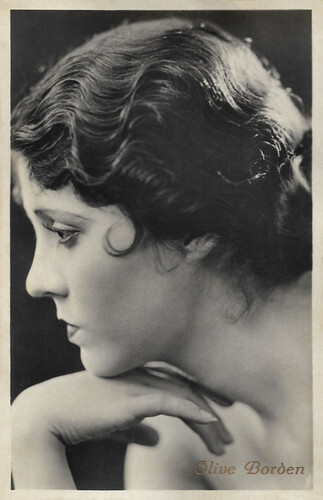
Italian postcard by G.B. Falci Editore, Milano, no. 543.
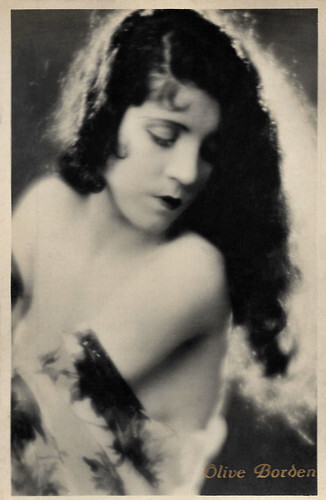
Italian postcard by G.B. Falci Editore, Milano, no. 614.
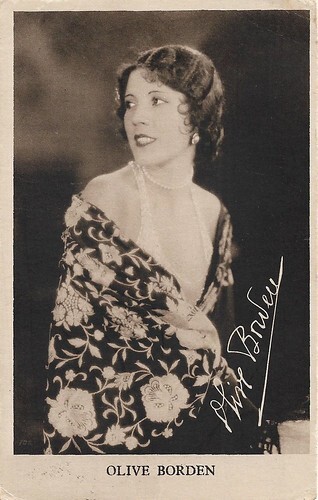
Italian postcard. Photo: Columbia Pictures. Olive Borden in Virgin Lips (Elmer Clifton, 1928). The postcard indicates the film as 1929, possibly the year it was released in Italy by the company EIA in Rome, under the title Labbra di vergine.
One of the Sennett Bathing Beauties
Olive Mary Borden was born in Richmond, Virginia in 1906. Contrary to urban legend, her original name was not Sybil Tinkle. Her father, Harry Robinson Borden, died when she was a baby and she was raised by her mother Cecilia Agnes Shields Borden.
As a teenager, she persuaded her widowed mother to take her to Hollywood to pursue a career in show business. To support themselves they opened a candy store and Olive worked as a telephone operator.
In 1922, Borden began her film career as one of the Sennett Bathing Beauties and was soon appearing as a vamp in Hal Roach comedy shorts. Producer Paul Bern chose her for an uncredited role in his film The Dressmaker from Paris (Paul Bern, 1925), starring Leatrice Joy Janiss Garza at AllMovie: "The flimsy plot to this romance seems to exist purely for the opportunity to have a fashion show in mid-picture. This is too bad, considering some of the names attached to the production: Howard Hawks was one of the writers, Paul Bern directed, and the whole production was overseen by Cecil B. DeMille ."
Olive was signed by Fox after being named one of the 13 WAMPAS Baby Stars in 1925. Borden quickly became one of their most popular and highest-paid stars earning a salary of $1,500 a week and celebrated for her long pitch-black hair. She had starring roles in eleven films at Fox, including the classic Western 3 Bad Men (John Ford, 1926) and Fig Leaves (Howard Hawks, 1926), both of which co-starred her then-boyfriend, George O'Brien . Hal Erickson at AllMovie : "Fig Leaves is historically important as the earliest extant film of director Howard Hawks. A partial parody of the Cecil B. DeMille historical spectacles, the film opens in the Garden of Eden, where Adam ( George O'Brien ) tries to read his morning paper (a stone tablet, a la The Flintstones) while Eve (Olive Borden) complains that she has nothing to wear."
After her leading role in the playful The Joy Girl (Allan Dwan, 1927), she was nicknamed 'the Joy Girl'. Borden starred as impulsive flapper Jewel Courage, who dumps the man she loves, a humble chauffeur (Jimmy Grainger Jr.) in favour of millionaire John Jeffrey Fleet (Neil Hamilton). Hal Erickson: "the film's principal selling angle was the stunning beauty of Olive Borden, who appeared in a variety of revealing outfits." But soon Olive's career waned. Paramount Studios began a policy of 10% pay cuts on any salary over $50 to recoup production costs, when Fox tried the same and cut her salary in 1927, Borden left the studio. By this point, she was a major silent film star. In making the transition to 'talkies', she worked with a voice coach to suppress her Southern accent.
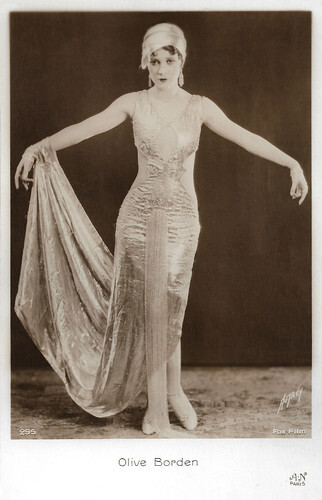
French postcard by A.N., Paris, no. 295. Photo: Max Munn Autrey / Fox.
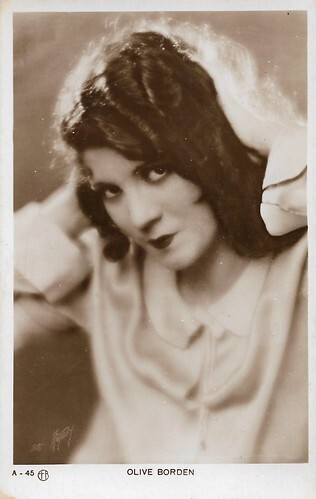
Spanish postcard by EFB (Editorial Fotografica, Barcelona), no. A-45. Photo: Max Munn Autrey.
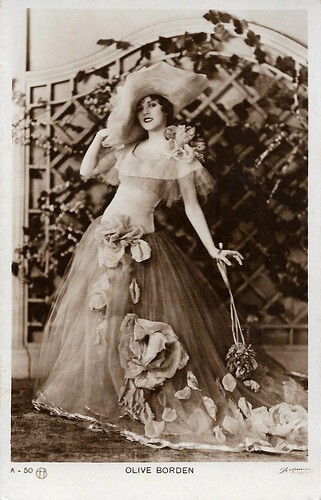
Spanish postcard by EFB (Editorial Fotografica, Barcelona), no. A-50. Photo: Zerkowitz.
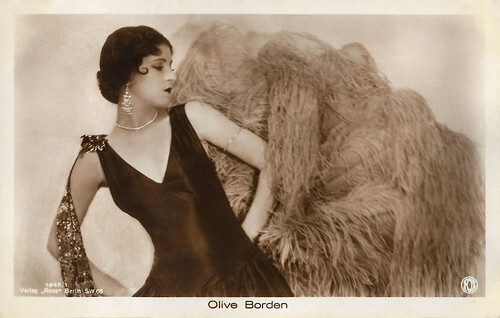
German postcard by Ross Verlag, Berlin, no. 1645/1, 1927-1928. Photo: Fox.
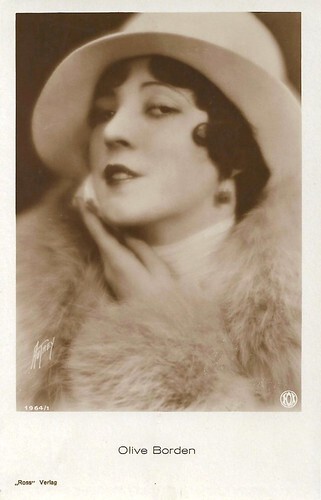
German postcard by Ross Verlag, Berlin, no. 1964/1, 1927-28. Photo: Max Munn Autrey / Fox.
A lavish lifestyle with limos, mansions, servants, and a dozen fur coats
Olive Borden lived a lavish lifestyle with limos, mansions, servants, and a dozen fur coats. By 1929, her career began to wane due to her rumoured reputation for being temperamental and her difficulty transitioning to sound films. She continued to work for Columbia and RKO. She had cut her trademark jet-black hair into a short bob and turned herself into a modern flapper. In Hello Sister (Walter Lang, 1930), produced and supervised by legendary silent-film director James Cruze, she starred as pert heiress Vee Newell who falls in love with handsome deacon Marshall Jones (Lloyd Hughes).
But Borden had trouble with the new look, losing her identity. She couldn't find her audience and this confused her waning public. Her strong Southern accent did not help. Frequently she had played Vamps, exotic types, and sophisticated society women, but those sorts of characters did not match the type of voice she had. In 1932, she appeared only in one feature, The Divorce Racket (Aubrey Scotto, 1932) starring James Rennie. In 1933 she made the British comedy Leave it to Me (Monty Banks, 1933) with Gene Gerrard, Hotel Variety (Raymond Cannon, 1933), and such shorts as The Mild West (Joseph Henabery, 1933).
Her last screen credit came in the low-budget film Chloe, Love Is Calling You (Marshall Neilan, 1934), where she played a woman kidnapped at birth and raised as a child of mixed race. Robert Firsching at AllMovie : "All the black characters despise white people, and even Mandy turns against the mulatto girl she raised, trying to cut her heart out in a voodoo ritual. As in many such efforts, 'whiteness' wins out in the end. This is a sad spectacle to behold today, but was par for the course in 1934." A pre-code movie made under Will Hays, it had little box office success and in some states (mostly southern) it was banned at the time of its release.
Olive made headlines in 1935 when she was named as the other woman in actor Ralph Emerson's divorce. She and Emerson costarred in Dance Hall (Melville W. Brown, 1929) and had an affair in 1934. When his wife, Jane N. Scholtz, found out, she filed for divorce and told the court that Emerson cheated on her with Borden. The bad publicity hurt Borden's reputation, and she never made another film.
Borden then moved to New York, where she had a brief stage career, and made a living on the waning vaudeville circuit. By the late 1930s, she was declared bankrupt and stopped acting. Borden then found work as a postal clerk and mail carrier and also worked as a nurse's aide. During World War II, she joined the Women's Army Corps. She served as an ambulance driver and received an Army citation for bravery in turning over an enemy ammunition truck. She was later honourably discharged with distinction after sustaining a severe foot injury during service.
Borden attempted a comeback in films, however, she was hindered by her alcoholism and health problems. In 1945, she began working at the Sunshine Mission, a home for impoverished women located in the skidrow section of Los Angeles. Olive Borden died there in a hotel room in October 1947 of a stomach ailment and pneumonia at the age of 41. A simple funeral was held at the Sunshine Mission for Women, where its founder, Pastor Essie Binkley West, performed the last rites, saying, "She played her greatest role when she became a star for Jesus." No one from her glory days in Hollywood was there, but a fairly large crowd came from the surrounding community of Skid Row. Sadly many of Borden's silent films have been lost.
Olive Borden was engaged to actor George O'Brien in 1929 and was also romantically involved with director Marshall Neilan. She was married twice. Her first marriage was to stockbroker Theodore Spector, whom she married in 1931. The marriage was rocky from the start, and the couple separated in early 1932 after news broke that she was involved in a love triangle. Spector had not divorced his first wife, Pearl, whom he married in 1919, and he was arrested for bigamy after his first wife came forward and claimed they were still married. In November 1932, Borden petitioned the court for an annulment, which was granted. Spector was ultimately cleared of bigamy, but Borden with the marriage annulled moved on from the entire incident. She married her second husband, 26-year-old railroad technician, John Moeller in 1934 under the pseudonym Mary Borden. That marriage ended in divorce seven years later.
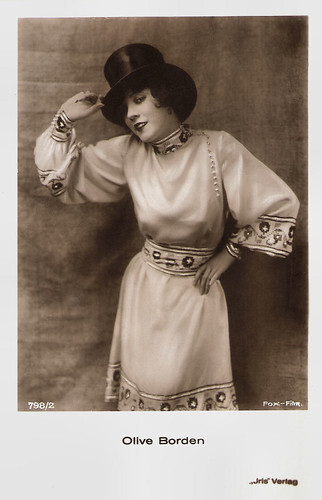
Austrian postcard by Iris Verlag, no. 798/2. Photo: Fox-Film.
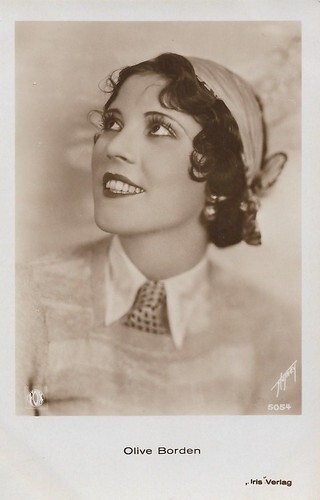
Austrian postcard by Iris Verlag, no. 5054. Photo: Max Munn Autrey / Fox.

Austrian postcard by Iris Verlag, no. 6575. Photo: Max Munn Autrey / Fox. Collection: Marlene Pilaete.
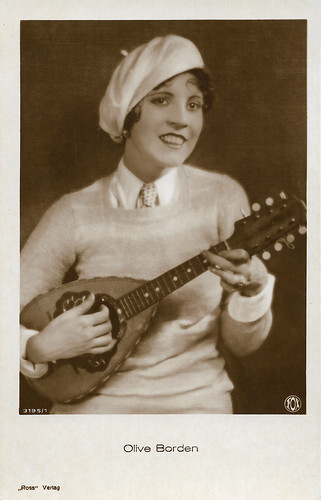
German postcard by Ross Verlag, no. 3195/1, 1928-29. Photo: Fox.
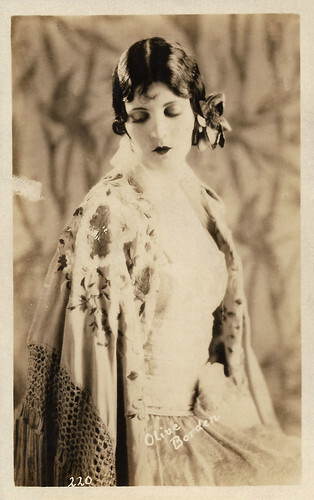
Vintage postcard, no. 220.
Sources: Janiss Garza (AllMovie), Robert Firsching (AllMovie), Hal Erickson (AllMovie), Carrie-Anne (Finf-A-Grave), Wikipedia and .

British postcard in the Picturegoer Series, London, no. 296. Photo: Max Munn Autrey.

Italian postcard by Casa Editrice Ballerini & Fratini, Firenze, no. 630. Photo: Fox Film Corp., Roma.

Italian postcard by G.B. Falci Editore, Milano, no. 543.

Italian postcard by G.B. Falci Editore, Milano, no. 614.

Italian postcard. Photo: Columbia Pictures. Olive Borden in Virgin Lips (Elmer Clifton, 1928). The postcard indicates the film as 1929, possibly the year it was released in Italy by the company EIA in Rome, under the title Labbra di vergine.
One of the Sennett Bathing Beauties
Olive Mary Borden was born in Richmond, Virginia in 1906. Contrary to urban legend, her original name was not Sybil Tinkle. Her father, Harry Robinson Borden, died when she was a baby and she was raised by her mother Cecilia Agnes Shields Borden.
As a teenager, she persuaded her widowed mother to take her to Hollywood to pursue a career in show business. To support themselves they opened a candy store and Olive worked as a telephone operator.
In 1922, Borden began her film career as one of the Sennett Bathing Beauties and was soon appearing as a vamp in Hal Roach comedy shorts. Producer Paul Bern chose her for an uncredited role in his film The Dressmaker from Paris (Paul Bern, 1925), starring Leatrice Joy Janiss Garza at AllMovie: "The flimsy plot to this romance seems to exist purely for the opportunity to have a fashion show in mid-picture. This is too bad, considering some of the names attached to the production: Howard Hawks was one of the writers, Paul Bern directed, and the whole production was overseen by Cecil B. DeMille ."
Olive was signed by Fox after being named one of the 13 WAMPAS Baby Stars in 1925. Borden quickly became one of their most popular and highest-paid stars earning a salary of $1,500 a week and celebrated for her long pitch-black hair. She had starring roles in eleven films at Fox, including the classic Western 3 Bad Men (John Ford, 1926) and Fig Leaves (Howard Hawks, 1926), both of which co-starred her then-boyfriend, George O'Brien . Hal Erickson at AllMovie : "Fig Leaves is historically important as the earliest extant film of director Howard Hawks. A partial parody of the Cecil B. DeMille historical spectacles, the film opens in the Garden of Eden, where Adam ( George O'Brien ) tries to read his morning paper (a stone tablet, a la The Flintstones) while Eve (Olive Borden) complains that she has nothing to wear."
After her leading role in the playful The Joy Girl (Allan Dwan, 1927), she was nicknamed 'the Joy Girl'. Borden starred as impulsive flapper Jewel Courage, who dumps the man she loves, a humble chauffeur (Jimmy Grainger Jr.) in favour of millionaire John Jeffrey Fleet (Neil Hamilton). Hal Erickson: "the film's principal selling angle was the stunning beauty of Olive Borden, who appeared in a variety of revealing outfits." But soon Olive's career waned. Paramount Studios began a policy of 10% pay cuts on any salary over $50 to recoup production costs, when Fox tried the same and cut her salary in 1927, Borden left the studio. By this point, she was a major silent film star. In making the transition to 'talkies', she worked with a voice coach to suppress her Southern accent.

French postcard by A.N., Paris, no. 295. Photo: Max Munn Autrey / Fox.

Spanish postcard by EFB (Editorial Fotografica, Barcelona), no. A-45. Photo: Max Munn Autrey.

Spanish postcard by EFB (Editorial Fotografica, Barcelona), no. A-50. Photo: Zerkowitz.

German postcard by Ross Verlag, Berlin, no. 1645/1, 1927-1928. Photo: Fox.

German postcard by Ross Verlag, Berlin, no. 1964/1, 1927-28. Photo: Max Munn Autrey / Fox.
A lavish lifestyle with limos, mansions, servants, and a dozen fur coats
Olive Borden lived a lavish lifestyle with limos, mansions, servants, and a dozen fur coats. By 1929, her career began to wane due to her rumoured reputation for being temperamental and her difficulty transitioning to sound films. She continued to work for Columbia and RKO. She had cut her trademark jet-black hair into a short bob and turned herself into a modern flapper. In Hello Sister (Walter Lang, 1930), produced and supervised by legendary silent-film director James Cruze, she starred as pert heiress Vee Newell who falls in love with handsome deacon Marshall Jones (Lloyd Hughes).
But Borden had trouble with the new look, losing her identity. She couldn't find her audience and this confused her waning public. Her strong Southern accent did not help. Frequently she had played Vamps, exotic types, and sophisticated society women, but those sorts of characters did not match the type of voice she had. In 1932, she appeared only in one feature, The Divorce Racket (Aubrey Scotto, 1932) starring James Rennie. In 1933 she made the British comedy Leave it to Me (Monty Banks, 1933) with Gene Gerrard, Hotel Variety (Raymond Cannon, 1933), and such shorts as The Mild West (Joseph Henabery, 1933).
Her last screen credit came in the low-budget film Chloe, Love Is Calling You (Marshall Neilan, 1934), where she played a woman kidnapped at birth and raised as a child of mixed race. Robert Firsching at AllMovie : "All the black characters despise white people, and even Mandy turns against the mulatto girl she raised, trying to cut her heart out in a voodoo ritual. As in many such efforts, 'whiteness' wins out in the end. This is a sad spectacle to behold today, but was par for the course in 1934." A pre-code movie made under Will Hays, it had little box office success and in some states (mostly southern) it was banned at the time of its release.
Olive made headlines in 1935 when she was named as the other woman in actor Ralph Emerson's divorce. She and Emerson costarred in Dance Hall (Melville W. Brown, 1929) and had an affair in 1934. When his wife, Jane N. Scholtz, found out, she filed for divorce and told the court that Emerson cheated on her with Borden. The bad publicity hurt Borden's reputation, and she never made another film.
Borden then moved to New York, where she had a brief stage career, and made a living on the waning vaudeville circuit. By the late 1930s, she was declared bankrupt and stopped acting. Borden then found work as a postal clerk and mail carrier and also worked as a nurse's aide. During World War II, she joined the Women's Army Corps. She served as an ambulance driver and received an Army citation for bravery in turning over an enemy ammunition truck. She was later honourably discharged with distinction after sustaining a severe foot injury during service.
Borden attempted a comeback in films, however, she was hindered by her alcoholism and health problems. In 1945, she began working at the Sunshine Mission, a home for impoverished women located in the skidrow section of Los Angeles. Olive Borden died there in a hotel room in October 1947 of a stomach ailment and pneumonia at the age of 41. A simple funeral was held at the Sunshine Mission for Women, where its founder, Pastor Essie Binkley West, performed the last rites, saying, "She played her greatest role when she became a star for Jesus." No one from her glory days in Hollywood was there, but a fairly large crowd came from the surrounding community of Skid Row. Sadly many of Borden's silent films have been lost.
Olive Borden was engaged to actor George O'Brien in 1929 and was also romantically involved with director Marshall Neilan. She was married twice. Her first marriage was to stockbroker Theodore Spector, whom she married in 1931. The marriage was rocky from the start, and the couple separated in early 1932 after news broke that she was involved in a love triangle. Spector had not divorced his first wife, Pearl, whom he married in 1919, and he was arrested for bigamy after his first wife came forward and claimed they were still married. In November 1932, Borden petitioned the court for an annulment, which was granted. Spector was ultimately cleared of bigamy, but Borden with the marriage annulled moved on from the entire incident. She married her second husband, 26-year-old railroad technician, John Moeller in 1934 under the pseudonym Mary Borden. That marriage ended in divorce seven years later.

Austrian postcard by Iris Verlag, no. 798/2. Photo: Fox-Film.

Austrian postcard by Iris Verlag, no. 5054. Photo: Max Munn Autrey / Fox.

Austrian postcard by Iris Verlag, no. 6575. Photo: Max Munn Autrey / Fox. Collection: Marlene Pilaete.

German postcard by Ross Verlag, no. 3195/1, 1928-29. Photo: Fox.

Vintage postcard, no. 220.
Sources: Janiss Garza (AllMovie), Robert Firsching (AllMovie), Hal Erickson (AllMovie), Carrie-Anne (Finf-A-Grave), Wikipedia and .
Published on November 22, 2022 22:00
Paul van Yperen's Blog
- Paul van Yperen's profile
- 13 followers
Paul van Yperen isn't a Goodreads Author
(yet),
but they
do have a blog,
so here are some recent posts imported from
their feed.



